Horizon Hobby BLH9706 Ozone User Manual BRWBLH9706
Horizon Hobby, LLC Ozone BRWBLH9706
BRWBLH9706_User Manual
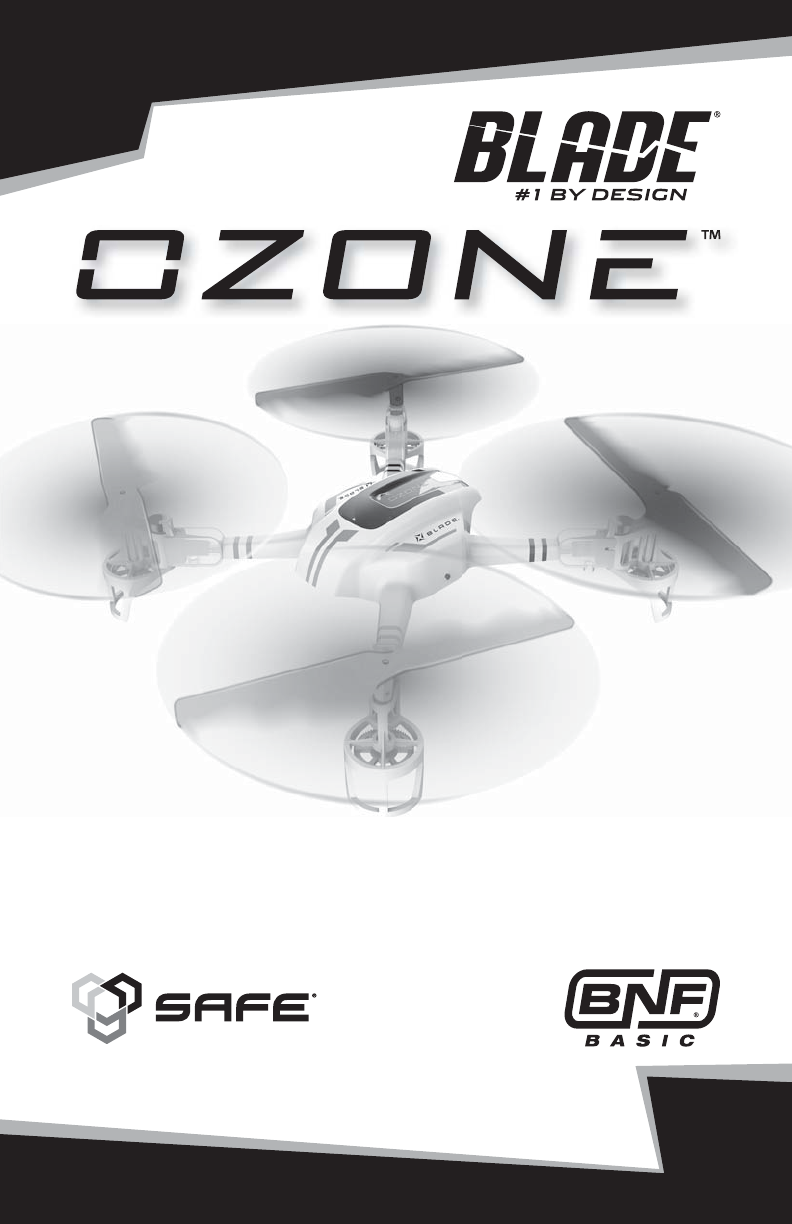
RTF
READY-TO-FLY
Instruction Manual
Bedienungsanleitung
Manuel d’utilisation
Manuale di Istruzioni
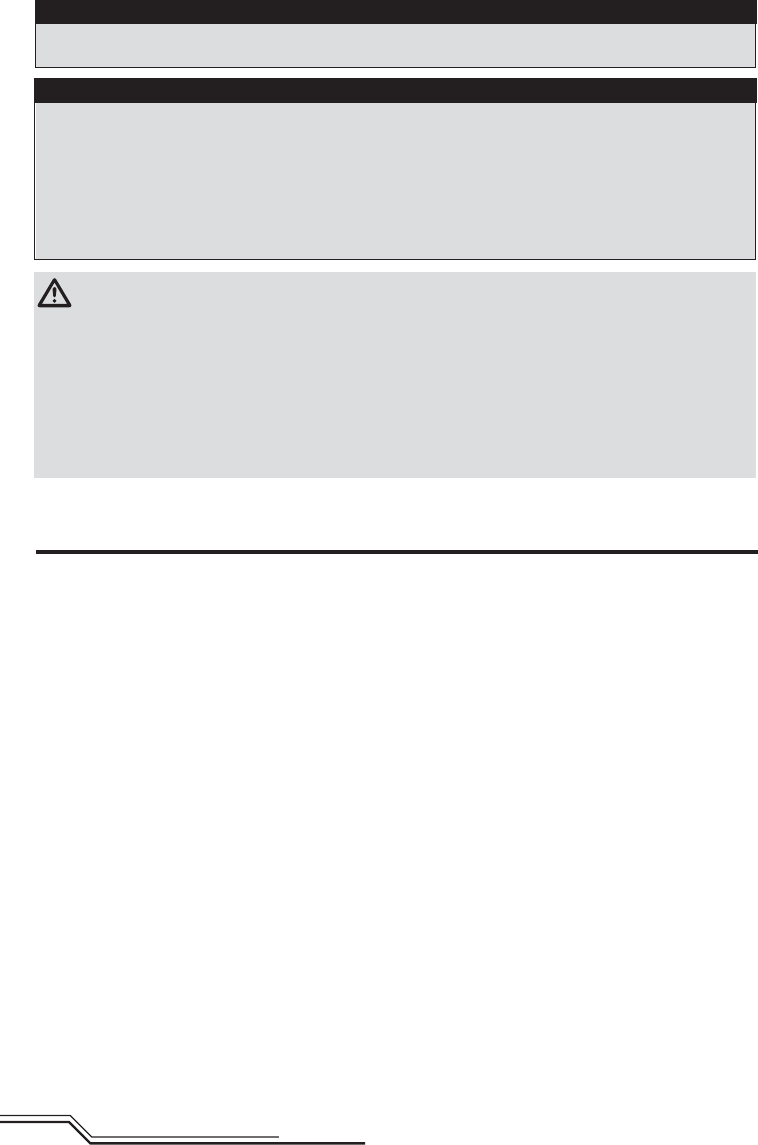
2
EN
WARNING: Read the ENTIRE instruction manual to become familiar with the features of the product before
operating. Failure to operate the product correctly can result in damage to the product, personal property and
cause serious injury.
This is a sophisticated hobby product. It must be operated with caution and common sense and requires some basic
mechanical ability. Failure to operate this Product in a safe and responsible manner could result in injury or damage
to the product or other property. This product is not intended for use by children without direct adult supervision. Do
not use with incompatible components or alter this product in any way outside of the instructions provided by Horizon
Hobby, LLC. This manual contains instructions for safety, operation and maintenance. It is essential to read and follow
all the instructions and warnings in the manual, prior to assembly, setup or use, in order to operate correctly and avoid
damage or serious injury.
The following terms are used throughout the product literature to indicate various levels of potential harm when
operating this product:
WARNING: Procedures, which if not properly followed, create the probability of property damage, collateral damage,
and serious injury OR create a high probability of superfi cial injury.
CAUTION: Procedures, which if not properly followed, create the probability of physical property damage AND a
possibility of serious injury.
NOTICE: Procedures, which if not properly followed, create a possibility of physical property damage AND a little or no
possibility of injury.
• Always keep a safe distance in all directions around
your model to avoid collisions or injury. This model is
controlled by a radio signal subject to interference from
many sources outside your control. Interference can
cause momentary loss of control.
• Always operate your model in open spaces away from
full-size vehicles, traffi c and people.
• Always carefully follow the directions and warnings for
this and any optional support equipment
(chargers, rechargeable battery packs, etc.).
• Always keep all chemicals, small parts and anything
electrical out of the reach of children.
• Always avoid water exposure to all equipment not
specifi cally designed and protected for this purpose.
Moisture causes damage to electronics.
• Never place any portion of the model in your mouth as it
could cause serious injury or even death.
• Never operate your model with low transmitter
batteries.
• Always keep aircraft in sight and under control.
• Always move the throttle fully down at rotor strike.
• Always use fully charged batteries.
• Always keep transmitter powered on while aircraft is
powered.
• Always remove batteries before disassembly
• Always keep moving parts clean.
• Always keep parts dry.
• Always let parts cool after use before touching.
• Always remove batteries after use.
• Never operate aircraft with damaged wiring.
• Never touch moving parts.
NOTICE
All instructions, warranties and other collateral documents are subject to change at the sole discretion of Horizon
Hobby, LLC. For up-to-date product literature, visit horizonhobby.com and click on the support tab for this product.
Meaning of Special Language
Safety Precautions and Warnings
Age Recommendation: Not for children under 14 years. This is not a toy.
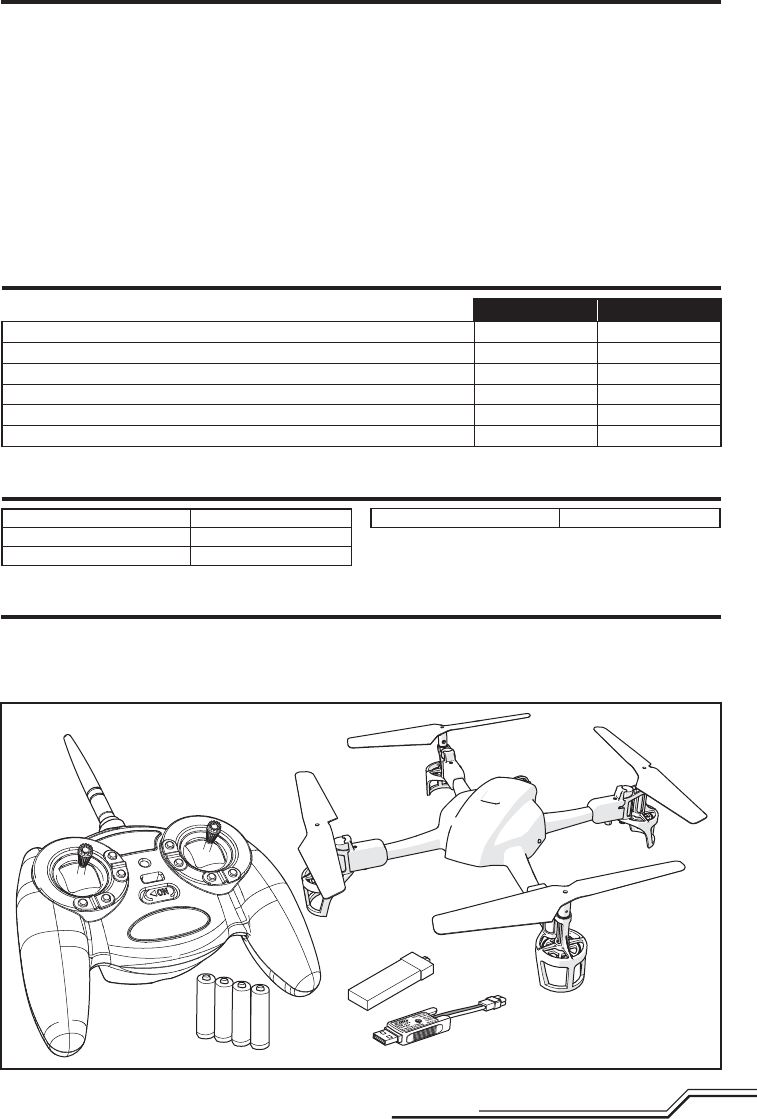
3EN
Box Contents
Components
Specifi cations
• Blade® Ozone™
• 3.7V 25C 500mAh 1S Li-Po Battery (RTF Only)
• 1S USB Li-Po Charger (RTF Only)
• MLP4DSM Transmitter (RTF Only)
• 4 AA Batteries (RTF Only)
Table of Contents
Length 6.78 in (172mm)
Height 2.20 in (56mm)
Propeller Diameter 2.56 in (65mm)
Flying Weight 2.65 oz (75 g)
RTF BLH9700 BNF BLH9750
Airframe – Blade® Ozone™ (BLH9700) Included Included
Motors – 8.53mm Brushed, (BLH9709, CW), (BLH9710, CCW) Installed Installed
On-board Electronics – Main control board, SAFE® (BLH9706) Installed Installed
Battery – 500mAh 1S 3.7V 25C Li-Po (EFLB5001S25UM) Included Required
Charger – 1S USB Li-Po Charger, 500 mAh, High-current UMX (EFLC1013) Included Required
Transmitter – MLP4DSM 2.4 GHz, 4 CH Transmitter, BCMX2 (EFLH1064/B) Included Required
To register your product online,visit www.bladehelis.com
Components ....................................................................3
Specifi cations ..................................................................3
Box Contents ...................................................................3
First Flight Preparation .....................................................4
Flying Checklist ...............................................................4
Charging Warnings...........................................................4
Battery Charging ..............................................................5
Installing the Transmitter Batteries (RTF) ..........................5
Installing the Flight Battery ..............................................5
Transmitter and Receiver Binding .....................................6
SAFE Technology .............................................................7
Transmitter Control ..........................................................7
Flight Mode Selection ......................................................8
LED Codes .......................................................................8
Understanding the Primary Flight Controls .......................9
Flying the Ozone ............................................................10
Post-Flight Inspection and Maintenance Checklist ..........10
Troubleshooting Guide ...................................................10
Exploded View ...............................................................12
Parts Listings .................................................................12
Limited Warranty ...........................................................13
Warranty and Service Contact Information .....................14
FCC Information .............................................................14
IC Information ...............................................................14
Compliance Information for the European Union .............14
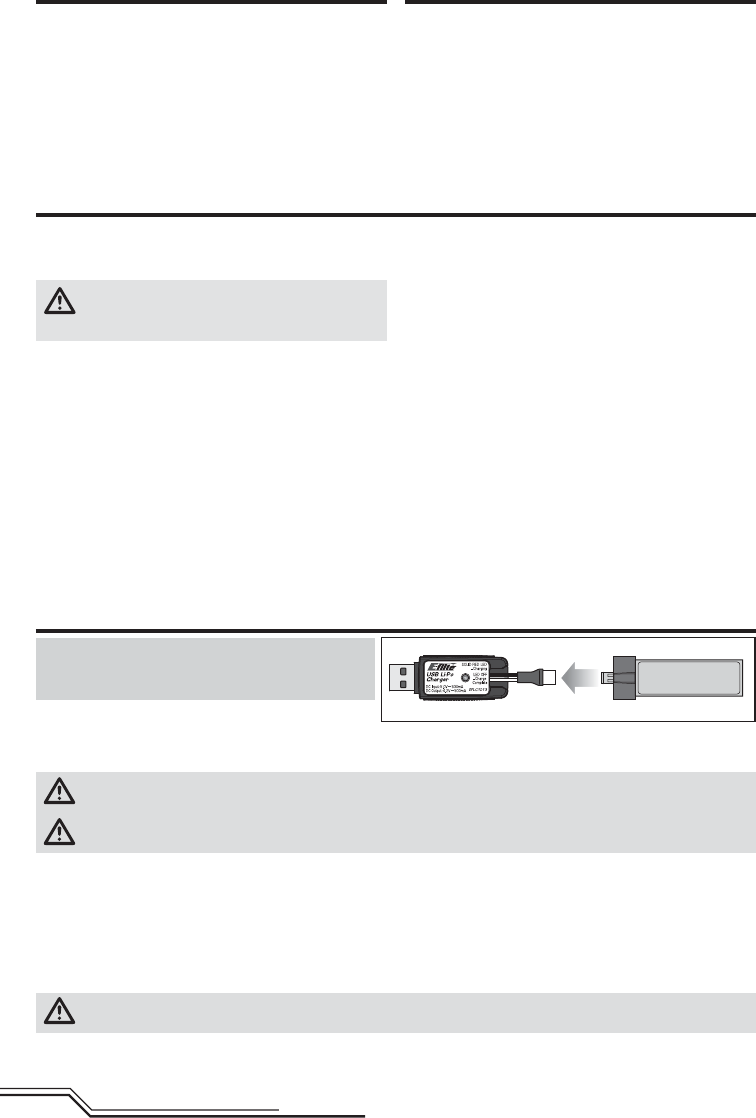
4
EN
The Battery Charger (EFLC1013) included with your
quadcopter has been designed to safely charge the Li-Po
battery.
CAUTION: All instructions and warnings must be
followed exactly. Mishandling of Li-Po batteries can
result in a fi re, personal injury and/or property damage.
• By handling, charging or using the included Li-Po battery,
you assume all risks associated with lithium batteries.
• If at any time the battery begins to balloon or swell,
discontinue use immediately. If charging or discharging,
discontinue and disconnect. Continuing to use, charge or
discharge a battery that is ballooning or swelling can result
in fi re.
• Always store the battery at room temperature in a dry area
for best results.
• Always transport or temporarily store the battery in a tem-
perature range of 40–120º F (5–49° C). Do not store battery
or model in a car or direct sunlight. If stored in a hot car, the
battery can be damaged or even catch fi re.
• Always charge batteries away from fl ammable materials.
• Always inspect the battery before charging.
• Always disconnect the battery after charging, and let the
charger cool between charges.
• Always constantly monitor the temperature of the battery
pack while charging.
• ONLY USE A CHARGER SPECIFICALLY DESIGNED TO CHARGE
LI-PO BATTERIES. Failure to charge the battery with a
compatible charger may cause a fi re resulting in personal
injury and/or property damage.
• Never discharge Li-Po cells to below 3V under load.
• Never cover warning labels with hook and loop strips.
• Never leave charging batteries unattended.
• Never charge batteries outside recommended levels.
• Never charge damaged batteries.
• Never attempt to dismantle or alter the charger.
• Never allow minors to charge battery packs.
• Never charge batteries in extremely hot or cold places
(recommended between 40–120° F or 5–49° C) or place in
direct sunlight.
Charging Warnings
Battery Charging
NOTICE: Charge only batteries that are cool to the touch
and are not damaged. Look at the battery to make sure it
is not damaged e.g., swollen, bent, broken or punctured.
1. Insert the charger into a USB port.
2. Properly connect the battery to the charger lead.
3. Always disconnect the fl ight battery from the charger immediately upon completion of charging.
CAUTION: Only use chargers specifi cally designed to charge the included Li-Po battery. Failure to do so could result
in fi re, causing injury or property damage.
CAUTION: Never exceed the recommended charge rate.
LED Indications
When you make the connection successfully, the LED on the charger turns solid red, indicating charging has begun.
Charging a fully discharged (not over-discharged) 500mAh battery takes approximately 60 minutes. The light goes out
when the charge is complete.
CHARGING (Solid Red)
MAX CHARGE (OFF)
CAUTION: Once charging is complete, immediately remove the battery. Never leave a battery connected to the
charger.
First Flight Preparation
• Remove and inspect contents
• Begin charging the fl ight battery
• Install the fl ight battery in the quadcopter
(once it has been fully charged)
• Program your computer transmitter (BNF only)
• Bind your transmitter (BNF only)
• Familiarize yourself with the controls
• Find a suitable area for fl ying
Flying Checklist
❏Always turn the transmitter on fi rst
❏ Plug the fl ight battery into the lead from the 5-in-1
control unit
❏ Allow the 5-in-1 control unit to initialize and arm
properly
❏Fly the model
❏Land the model
❏ Unplug the fl ight battery from the 5-in-1 control unit
❏Always turn the transmitter off last
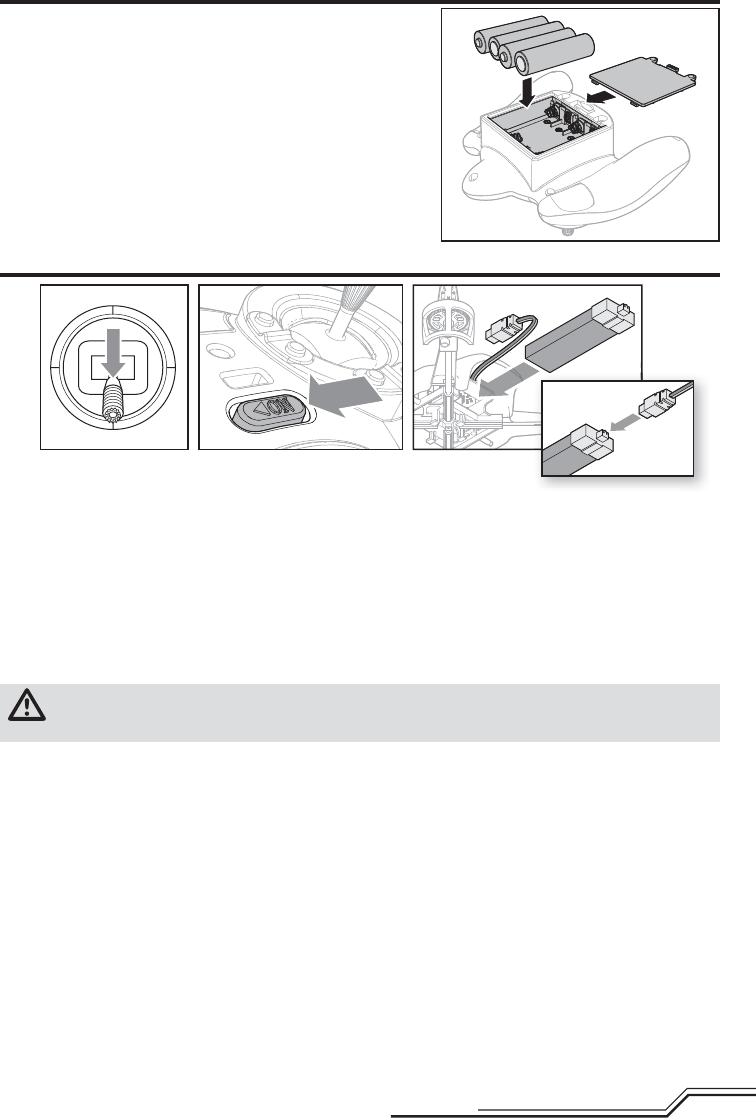
5EN
Installing the Transmitter Batteries (RTF)
Replace the transmitter batteries when the power LED fl ashes and the
transmitter beeps.
1. Lower the throttle to the lowest setting. For BNF aircraft, engage throttle hold if your transmitter is so equipped.
2. Power on the transmitter.
3. Install the battery by sliding it into the battery mounting slot below the control unit. Slide the battery into the slots
with the label facing upward so that the battery key molded into the battery end-cap comes in contact with
the key on the battery slot.
4. Connect the battery cable to the control unit.
5. Place the quadcopter on a fl at surface and leave the aircraft still until the LED on the control unit indicates one of the
following fl ight modes:
Solid blue: Stability mode, switch position 1
Solid red: Agility mode, switch position 2
CAUTION: Always disconnect the Li-Po battery from the aircraft when not fl ying to avoid over-discharging the
battery. Batteries discharged to a voltage lower than the lowest approved voltage may become damaged,
resulting in loss of performance and potential fi re when batteries are charged.
Installing the Flight Battery
12
ansmitter is so equipped
3
4
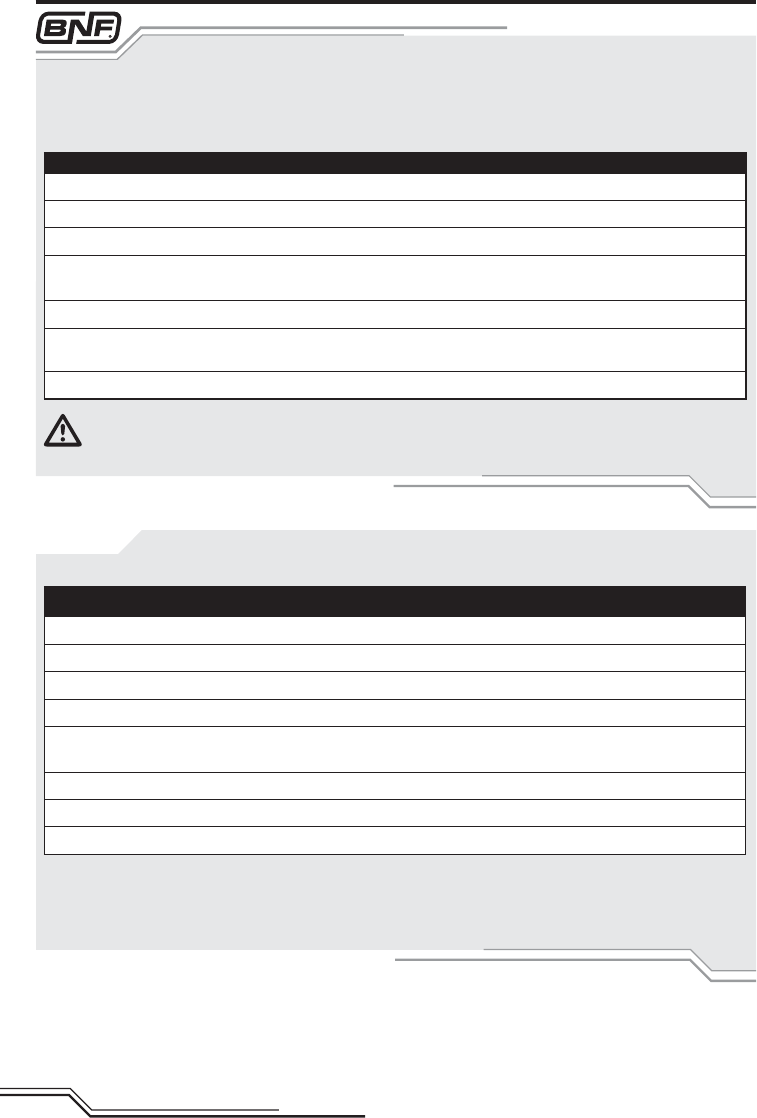
6
EN
CAUTION: When using a Futaba® transmitter with a Spektrum™ DSM2®/DSMX ® module, you must reverse the
throttle channel and re-bind. Refer to your Spektrum module manual for binding and failsafe instructions.
Refer to your Futaba transmitter manual for instructions on reversing the throttle channel.
MLP4DSM Binding Procedure
1. Disconnect the fl ight battery from the quadcopter.
2. Center all trims on your transmitter.
3. Power off the transmitter and move the throttle stick to the down/off position.
4. Connect the fl ight battery in the quadcopter. The LED on the control unit fl ashes after 5 seconds.
5. When the blue light is fl ashing, push in and hold down the left stick* while powering on the transmitter
(you will hear a ‘click’).
6. Release the left stick. The transmitter will beep and the power LED will blink.
7. The quadcopter is bound when all of the LEDs on the aircraft turn solid.
8. Disconnect the fl ight battery and power the transmitter off.
* The trigger switch may also be used for the binding procedure.
If you encounter problems, obey binding instructions and refer to the troubleshooting guide for other instructions.
If needed, contact the appropriate Horizon Product Support offi ce. For a list of compatible DSM® transmitters, please
visit www.bindnfl y.com.
RTF
Your RTF transmitter comes prebound to the model. If you need to re-bind, follow the directions below.
Transmitter and Receiver Binding
If you are using a computer transmitter, set the model type to “Acro” or “Airplane” mode. In the channel input menu, set
channel 6 (Aux1) to a momentary switch such as the bind button ( I) and channel 5 (Gear) to a 3-position switch (switch
B). In the Servo Setup menu, reverse channel 6 (Aux1).
Bind the quadcopter to your transmitter following the Transmitter and Receiver Binding directions below.
General Binding Procedure
1. Disconnect the fl ight battery from the quadcopter.
2. Center all trims on your transmitter.
3. Power off the transmitter and fully lower the throttle.
4. Connect the fl ight battery in the quadcopter. All of the LEDs on the aircraft will fl ash rapidly, indicating the aircraft has
entered bind mode.
5. Put the transmitter into bind mode while powering on the transmitter.
6. Release the bind button/switch after 2–3 seconds. The quadcopter is bound when all of the LEDs on the aircraft
turn solid.
7. Disconnect the fl ight battery and power the transmitter off.
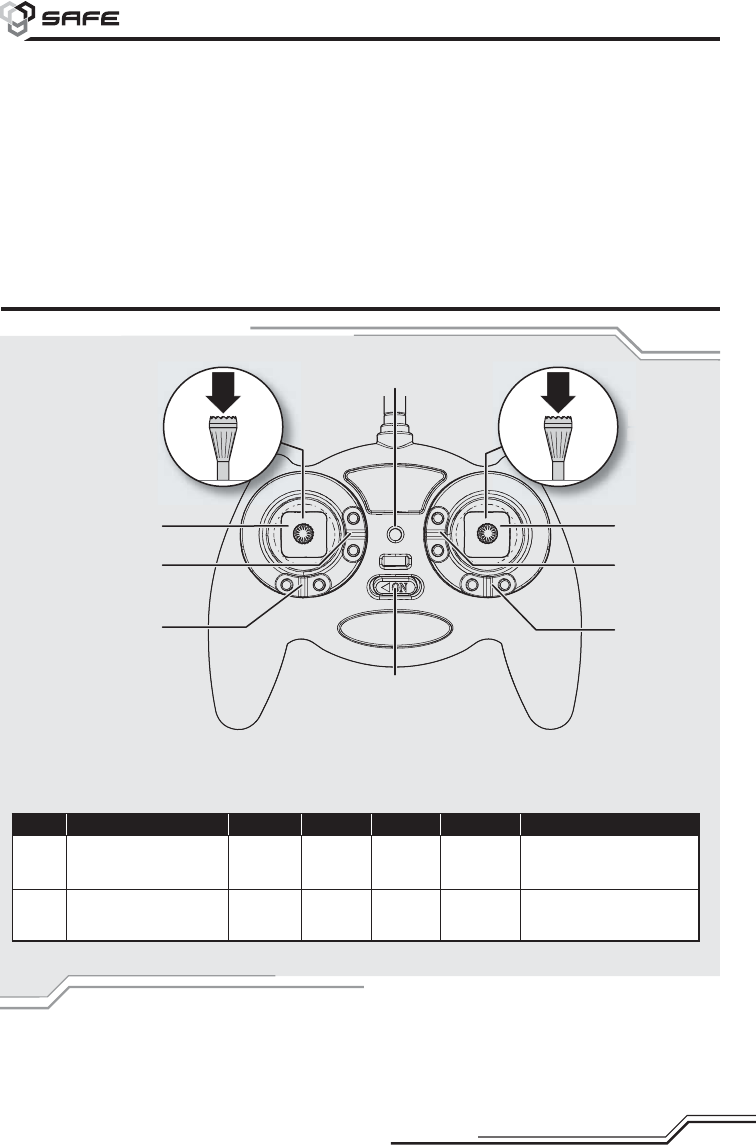
7EN
RTF
Transmitter Control
Revolutionary SAFE® (Sensor Assisted Flight Envelope) technology uses an innovative combination of multi-axis sensors and
software that allows model aircraft to know its position relative to the horizon. This spatial awareness is utilized to create a
controlled fl ight envelope the aircraft can use to maintain a safe region of bank and pitch angles so you can fl y more safely.
Far beyond stability, this level of protection offers multiple modes so the pilot can choose to develop his or her skills with a
greater degree of security and fl ight control that always feels crisp and responsive.
SAFE technology delivers:
• Flight envelope protection you can enable at the fl ip of a switch.
• Multiple modes let you adapt SAFE technology to your skill level instantly.
Best of all, sophisticated SAFE technology doesn’t require any work to enjoy. Every aircraft with SAFE installed is ready to use
and optimized to offer the best possible fl ight experience.
FlySAFERC.com
Technology
®
ABCDE F
Mode
1
Aileron (Left/Right)
Throttle (Up/Down)
Throttle
Trim
Aileron
Trim
Rudder
Trim
Elevator
Trim
Rudder (Left/Right)
Elevator (Up/Down)
Mode
2
Aileron (Left/Right)
Elevator (Up/Down)
Elevator
Trim
Aileron
Trim
Rudder
Trim
Throttle
Trim
Rudder (Left/Right)
Throttle (Up/Down)
Flight mode
selection
• Bind
• Long press:
Arm/Disarm
D
E
F
Power LED indicator
C
B
A
On/Off Switch
When pressed down, trim buttons make a sound that increases or decreases in pitch at each pressing. The middle or
neutral trim position is heard as a middle tone in the pitch range of the sounds. The end of the control range is sounded
by a series of beeps.
Fl
se
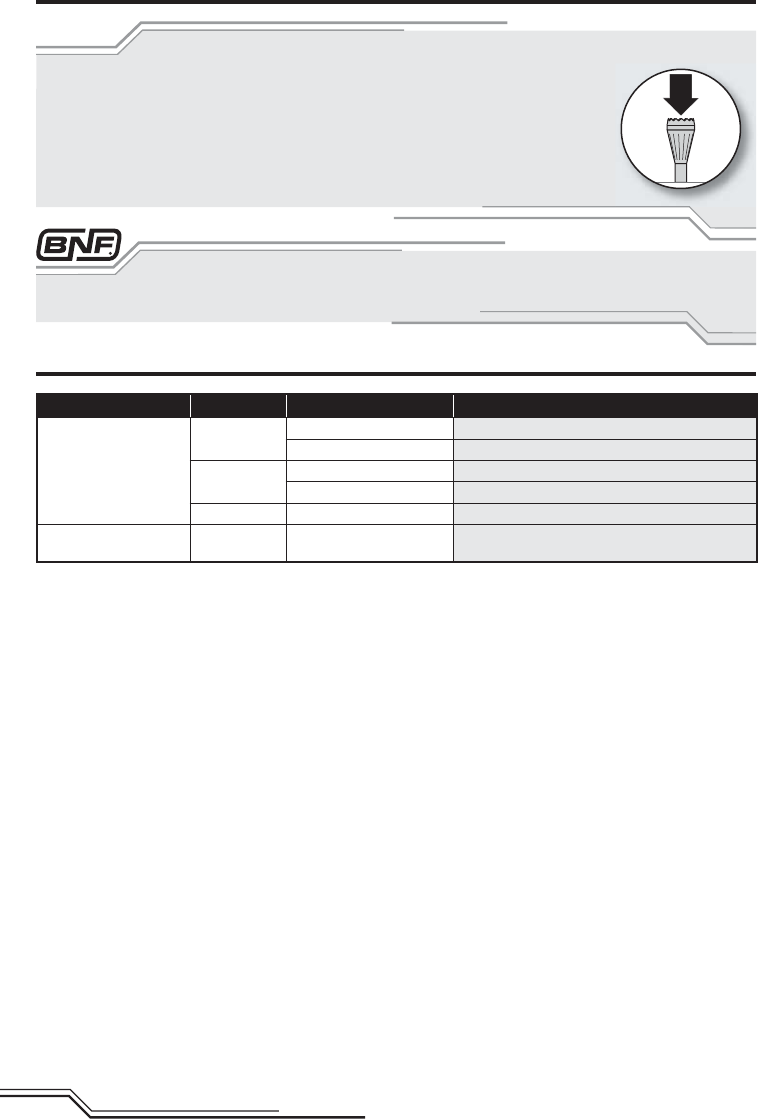
8
EN
RTF
Change fl ight modes by pushing down on the right stick. Ensure the fl ight mode switch is in the
desired position before fl ying.
• In Stability mode (switch position 1), the controls provide a minimum bank angle. This mode
is shown by the fl ight control LEDs on the quadcopter glowing solid blue.
• Agility mode (switch position 2) is shown by the fl ight control LEDs on the quadcopter
glowing solid red.
If you purchased a BNF Ozone™ quadcopter, the channel 5 switch on your transmitter will select fl ight modes.
Flight Mode Selection
LED Codes
Equipment LED Color LED Status Operation
Quadcopter:
Flight control LEDs on
the control board
Blue Solid Stability mode, switch position 1
Blinking Loss of RF / Transmitter OFF
Red Solid Agility mode, switch position 2
Blinking Low Battery
White Blinking Disarmed, Ready
Quadcopter:
Outer motor pod LEDs
White (Front)
Red (Rear) Slowly Dim and Brighten In relation to throttle input
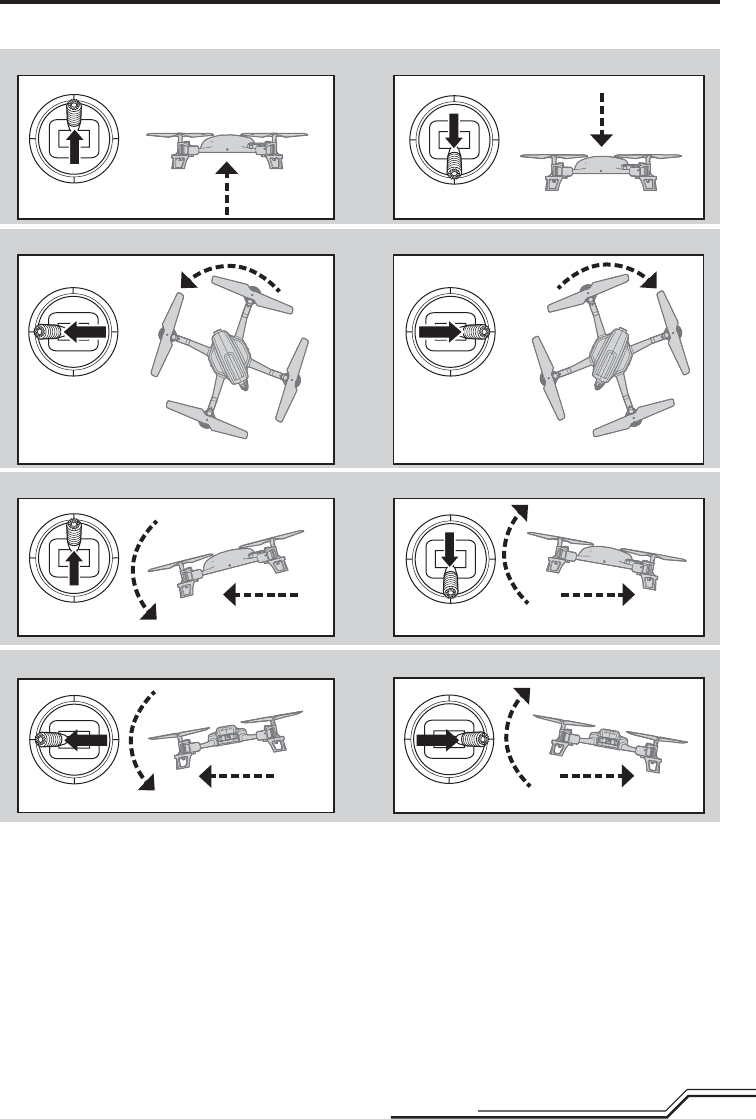
9EN
Elevator
ForwardElevator down Elevator up Backward
Left Side View Left Side View
Rudder
Rudder left Rudder right
Nose Yaws Right
Nose Yaws Left
Understanding the Primary Flight Controls
If you are not familiar with the controls of your Ozone™ quadcopter, take a few minutes to familiarize yourself with them
before attempting your fi rst fl ight.
Throttle
Throttle down
Throttle up
Left Side View Left Side View
Descend
Climb
Aileron
Aileron left Left Aileron right Right
Rear ViewRear View
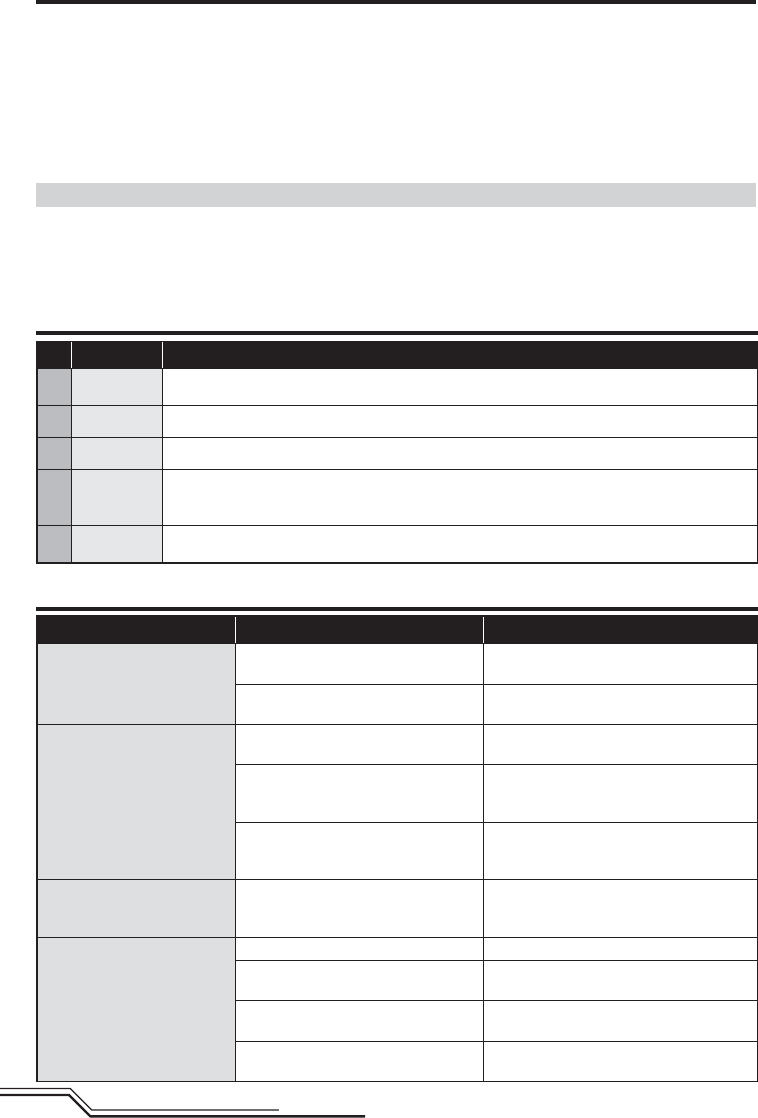
10
EN
Post-Flight Inspection and Maintenance Checklist
√
Cleaning Make sure the battery is not connected before cleaning. Remove dust and debris with a soft brush or
a dry, lint-free cloth.
Motors Replace the motor when the model will not fl y steady or veers off when doing a climb out.
Wiring Make sure the wiring does not block moving parts. Replace damaged wiring and loose connectors.
Fasteners
Make sure there are no loose screws, other fasteners or connectors. Do not over-tighten metal
screws in plastic parts. Tighten screws so the parts are mated together, then turn the screw only
1/8th of a turn more.
Propellers Make sure there is no damage to the propellers or other parts that move at high speed. Damage to
these parts includes cracks, burrs, chips or scratches. Replace damaged parts before fl ying.
Troubleshooting Guide
Problem Possible Cause Solution
Quadcopter control response is
inconsistent or requires extra trim
to neutralize movement.
Aircraft not initialized on a level surface. Disconnect the fl ight battery, center the control
trim and re-initialize the quadcopter.
Battery not correctly placed in
battery slot. Adjust battery position so quadcopter balances
in the center of the frame.
Quadcopter will not respond to
throttle.
Throttle too high and/or throttle trim is
too high. Reset controls with the throttle stick
and throttle trim at the lowest setting.
Quadcopter moved during initialization. Disconnect the flight battery and re-initialize
the quadcopter while keeping the quadcopter
from moving.
Throttle channel is reversed. Disconnect fl ight battery, reverse the throttle
channel on the transmitter,
recconnect fl ight battery.
Quadcopter does not function
and smells burnt after connecting
the fl ight battery.
Flight battery connected with the wrong
polarity. Replace the 5-in-1 board. Connect the fl ight
battery noting proper polarity.
Quadcopter has reduced fl ight
time or is underpowered.
Flight battery charge is low. Completely recharge the fl ight battery.
Inadequate power to fl ight battery charger. Use a different USB power source for the
charger.
Flight battery is damaged. Replace the fl ight battery and follow the fl ight
battery instructions.
Flight conditions might be too cold. Make sure the battery is warm (room
temperature) before use.
Takeo
Increase the throttle until the model is approximately 2 ft. (600mm) off the ground and check the trim so the model
fl ies as desired. Once the trim is adjusted, begin fl ying the model.
Typical fl ight times for the included battery range from 5 to 10 minutes.
Low Voltage Cuto (LVC)
LVC decreases the power to the motors when the battery voltage gets low. When the motor power decreases and the
front and rear FC LEDs fl ash red, land the aircraft immediately and recharge the fl ight battery.
LVC does not prevent the battery from over-discharge during storage.
NOTICE: Repeated fl ying to LVC will damage the battery.
Landing
To land, slowly decrease the throttle while in a low-level hover. After landing, hold the arm/disarm switch until the
motors have stopped, then remove the battery. Fully charge your battery before storing it. During storage, make sure the
battery charge does not fall below 3V per cell.
Flying the Ozone™
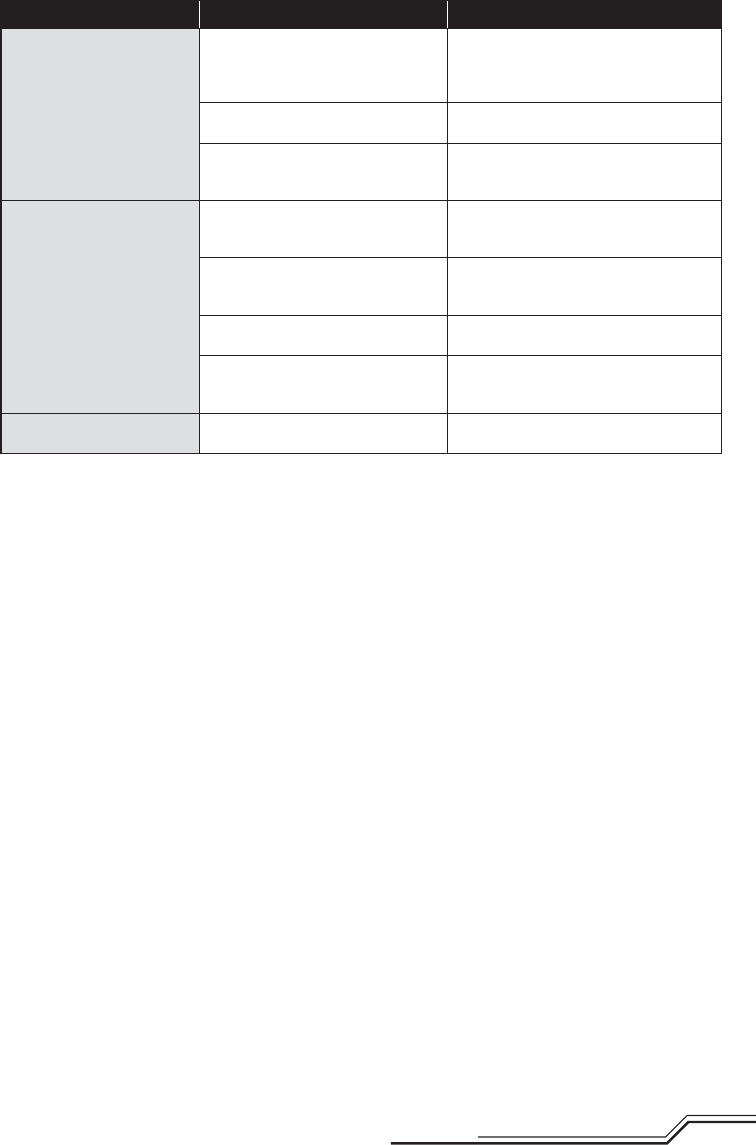
11 EN
Problem Possible Cause Solution
LED on receiver fl ashes rapidly
and aircraft will not respond to
transmitter (during binding).
Transmitter too near aircraft during bind-
ing process.
Power off the transmitter. Move the transmitter
a larger distance from the aircraft. Disconnect
and reconnect the fl ight battery to the aircraft.
Follow the binding instructions.
Bind switch or button was not held while
transmitter was powered on. Power off transmitter and repeat bind process.
Aircraft or transmitter is too close to large
metal object, wireless source or another
transmitter.
Move aircraft and transmitter to another
location and attempt binding again.
LED on the receiver fl ashes rap-
idly and the quadcopter will not
respond to the transmitter (after
binding).
Less than a 5-second wait between fi rst
powering on the transmitter and connect-
ing the fl ight battery to the quadcopter.
Leave the transmitter powered on. Disconnect
and reconnect the fl ight battery to the
quadcopter.
The quadcopter is bound to a different
model memory (ModelMatch™ transmit-
ters only).
Select the correct model memory on the
transmitter. Disconnect and reconnect the fl ight
battery to the quadcopter.
Flight battery or transmitter battery charge
is too low. Replace or recharge batteries.
Aircraft or transmitter is too close to
large metal object, wireless source or
another transmitter.
Move aircraft and transmitter to another
location and attempt connecting again.
Crashes immediately upon lift-off Propellers in wrong locations or
incorrect fl ight mode selected. Ensure propeller direction and motor
direction are correct.
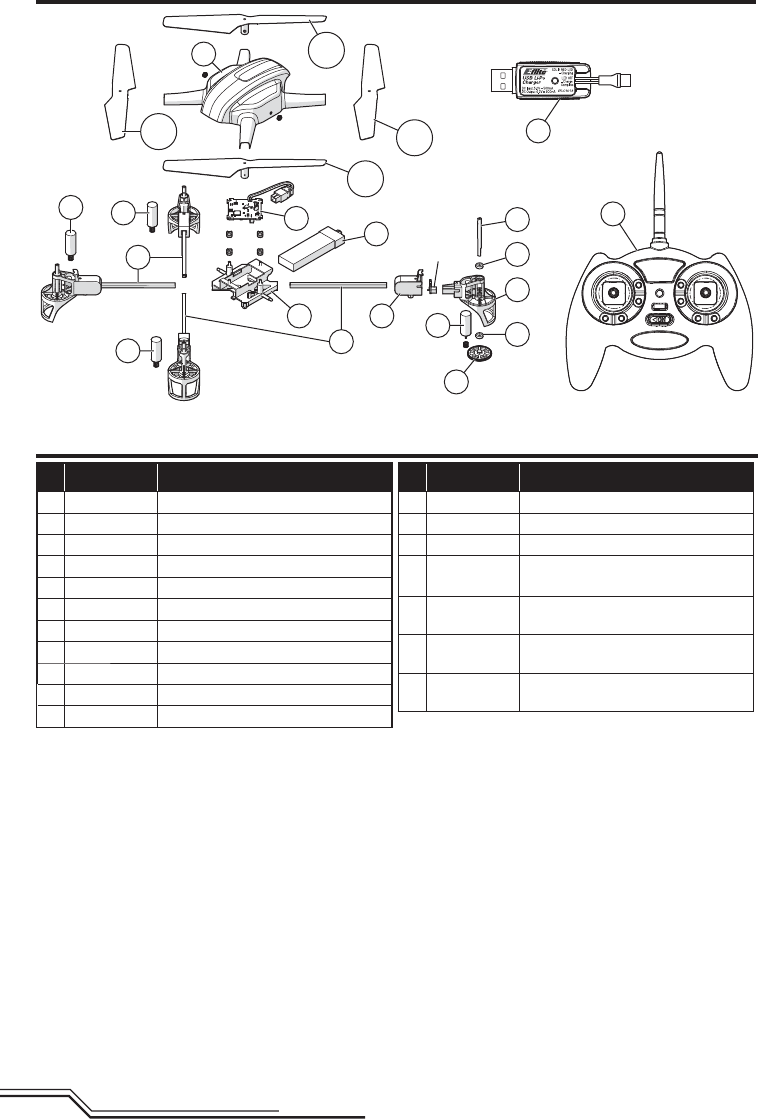
12
EN
Exploded View
Parts Listings
Part # Description
1 BLH9706 Main control board: Ozone
2 BLH9707 Left boom set (2)
3 BLH9708 Right boom set (2)
4 BLH9710 Counterclockwise motor
5 BLH9709 Clockwise motor
6 BLH9702 Inner frame
7 BLH9704 Canopy
8 BLH9703 Complete propeller set (4)
9 BLH9705 Motor mount cover (semi-transp)
10 BLH9712 Landing skids
11 BLH7521 Propeller, CCW rotation, black (2)
Part # Description
12 BLH7520 Propeller, CW rotation, black, (2)
13 BLH7513 Propeller shaft, carbon
14 BLH3506 Main gear: BMSR, mCP S/X
15 BLH3515 Main shaft bearing, 3x6x2mm (2):
BMCX/2/MSR, MH-35, mCP X
16 EFLB5001S25UM 3.7V 500mAh 1S 25C LiPo, High
current UMX connector
17 EFLC1013 1S USB LiPo charger, 500 mAh, High
current UMX connector
18 EFLH1064/B Blade MLP4DSM 4CH transmitter,
2.4 GHz: BMCX2, 120SR
14
15
15
LED
13
17
18
10
8
12 8
12
8
11
8
11
1
6
2
3
9
16
4
4
5
5
7

13 EN
Limited Warranty
What this Warranty Covers
Horizon Hobby, LLC, (Horizon) warrants to the original purchaser
that the product purchased (the "Product") will be free from
defects in materials and workmanship at the date of purchase.
What is Not Covered
This warranty is not transferable and does not cover (i) cosmetic
damage, (ii) damage due to acts of God, accident, misuse,
abuse, negligence, commercial use, or due to improper use,
installation, operation or maintenance, (iii) modification of or to
any part of the Product, (iv) attempted service by anyone other
than a Horizon Hobby authorized service center, (v) Product not
purchased from an authorized Horizon dealer, or (vi) Product not
compliant with applicable technical regulations.
OTHER THAN THE EXPRESS WARRANTY ABOVE, HORIZON
MAKES NO OTHER WARRANTY OR REPRESENTATION, AND
HEREBY DISCLAIMS ANY AND ALL IMPLIED WARRANTIES,
INCLUDING, WITHOUT LIMITATION, THE IMPLIED WARRANTIES
OF NON-INFRINGEMENT, MERCHANTABILITY AND FITNESS FOR
A PARTICULAR PURPOSE. THE PURCHASER ACKNOWLEDGES
THAT THEY ALONE HAVE DETERMINED THAT THE PRODUCT
WILL SUITABLY MEET THE REQUIREMENTS OF THE
PURCHASER’S INTENDED USE.
Purchaser’s Remedy
Horizon’s sole obligation and purchaser’s sole and exclusive
remedy shall be that Horizon will, at its option, either (i)
service, or (ii) replace, any Product determined by Horizon to
be defective. Horizon reserves the right to inspect any and all
Product(s) involved in a warranty claim. Service or replacement
decisions are at the sole discretion of Horizon. Proof of purchase
is required for all warranty claims. SERVICE OR REPLACEMENT
AS PROVIDED UNDER THIS WARRANTY IS THE PURCHASER’S
SOLE AND EXCLUSIVE REMEDY.
Limitation of Liability
HORIZON SHALL NOT BE LIABLE FOR SPECIAL, INDIRECT,
INCIDENTAL OR CONSEQUENTIAL DAMAGES, LOSS OF
PROFITS OR PRODUCTION OR COMMERCIAL LOSS IN ANY
WAY, REGARDLESS OF WHETHER SUCH CLAIM IS BASED IN
CONTRACT, WARRANTY, TORT, NEGLIGENCE, STRICT LIABILITY
OR ANY OTHER THEORY OF LIABILITY, EVEN IF HORIZON HAS
BEEN ADVISED OF THE POSSIBILITY OF SUCH DAMAGES.
Further, in no event shall the liability of Horizon exceed the
individual price of the Product on which liability is asserted.
As Horizon has no control over use, setup, final assembly,
modification or misuse, no liability shall be assumed nor
accepted for any resulting damage or injury. By the act of use,
setup or assembly, the user accepts all resulting liability. If you
as the purchaser or user are not prepared to accept the liability
associated with the use of the Product, purchaser is advised to
return the Product immediately in new and unused condition to
the place of purchase.
Law
These terms are governed by Illinois law (without regard to
conflict of law principals). This warranty gives you specific legal
rights, and you may also have other rights which vary from state
to state. Horizon reserves the right to change or modify this
warranty at any time without notice.
WARRANTY SERVICES
Questions, Assistance, and Services
Your local hobby store and/or place of purchase cannot provide
warranty support or service. Once assembly, setup or use of the
Product has been started, you must contact your local distributor
or Horizon directly. This will enable Horizon to better answer your
questions and service you in the event that you may need any
assistance. For questions or assistance, please visit our website
at www.horizonhobby.com, submit a Product Support Inquiry, or
call the toll free telephone number referenced in the Warranty
and Service Contact Information section to speak with a Product
Support representative.
Inspection or Services
If this Product needs to be inspected or serviced and is
compliant in the country you live and use the Product in,
please use the Horizon Online Service Request submission
process found on our website or call Horizon to obtain a Return
Merchandise Authorization (RMA) number. Pack the Product
securely using a shipping carton. Please note that original boxes
may be included, but are not designed to withstand the rigors
of shipping without additional protection. Ship via a carrier that
provides tracking and insurance for lost or damaged parcels, as
Horizon is not responsible for merchandise until it arrives and is
accepted at our facility. An Online Service Request is available at
http://www.horizonhobby.com/content/_service-center_render-
service-center. If you do not have internet access, please
contact Horizon Product Support to obtain a RMA number along
with instructions for submitting your product for service. When
calling Horizon, you will be asked to provide your complete
name, street address, email address and phone number where
you can be reached during business hours. When sending
product into Horizon, please include your RMA number, a list
of the included items, and a brief summary of the problem. A
copy of your original sales receipt must be included for warranty
consideration. Be sure your name, address, and RMA number
are clearly written on the outside of the shipping carton.
NOTICE: Do not ship LiPo batteries to Horizon. If you
have any issue with a LiPo battery, please contact the
appropriate Horizon Product Support office.
Warranty Requirements
For Warranty consideration, you must include your
original sales receipt verifying the proof-of-purchase
date. Provided warranty conditions have been met, your
Product will be serviced or replaced free of charge. Service or
replacement decisions are at the sole discretion of Horizon.
Non-Warranty Service
Should your service not be covered by warranty, service
will be completed and payment will be required without
notification or estimate of the expense unless the
expense exceeds 50% of the retail purchase cost. By
submitting the item for service you are agreeing to payment of
the service without notification. Service estimates are available
upon request. You must include this request with your item
submitted for service. Non-warranty service estimates will be
billed a minimum of ½ hour of labor. In addition you will be billed
for return freight. Horizon accepts money orders and cashier’s
checks, as well as Visa, MasterCard, American Express, and
Discover cards. By submitting any item to Horizon for service,
you are agreeing to Horizon’s Terms and Conditions found on
our website http://www.horizonhobby.com/content/_service-
center_render-service-center.
ATTENTION: Horizon service is limited to Product
compliant in the country of use and ownership. If
received, a non-compliant Product will not be serviced.
Further, the sender will be responsible for arranging
return shipment of the un-serviced Product, through
a carrier of the sender’s choice and at the sender’s
expense. Horizon will hold non-compliant Product for a
period of 60 days from notification, after which it will be
discarded.
10/2015
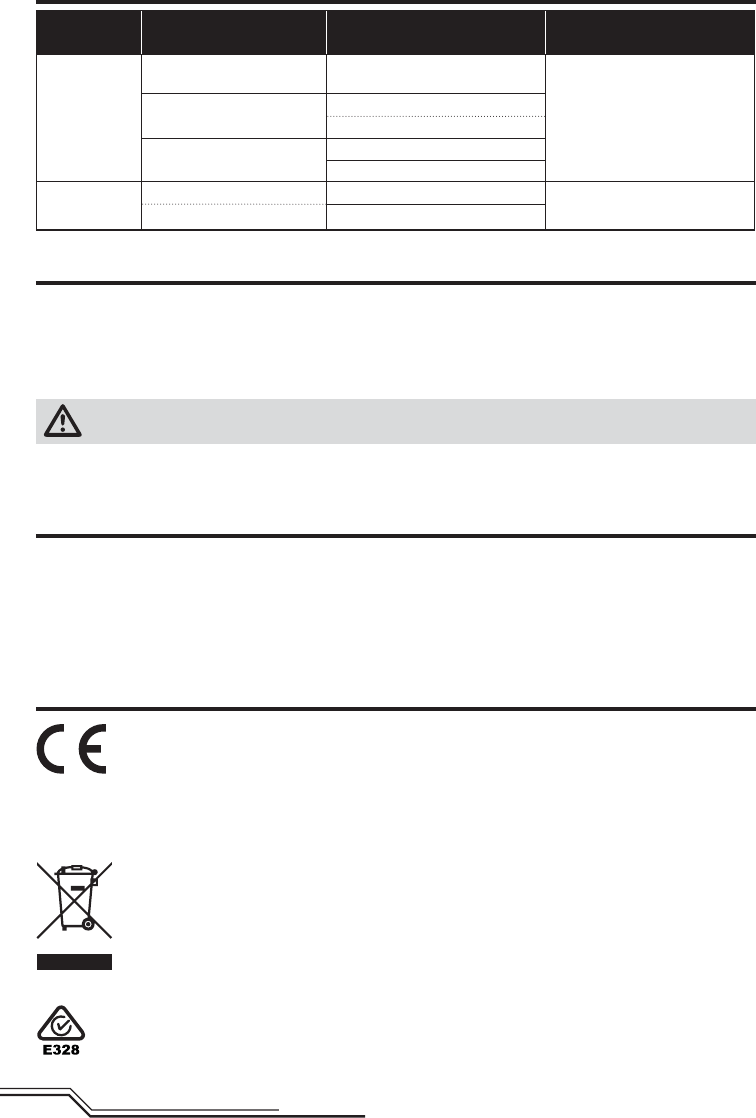
14
EN
Warranty and Service Contact Information
FCC Information
FCC ID (Transmitter): BRWDXMTX10
FCC ID (Quadcopter): BRWBLH9706
This device complies with part 15 of the FCC rules. Operation is subject to the following two conditions: (1) This device
may not cause harmful interference, and (2) this device must accept any interference received, including interference that
may cause undesired operation.
CAUTION: Changes or modifi cations not expressly approved by the party responsible for compliance could void
the user’s authority to operate the equipment.
This product contains a radio transmitter with wireless technology which has been tested and found to be compliant with
the applicable regulations governing a radio transmitter in the 2.400GHz to 2.4835GHz frequency range.
IC Information
IC (Transmitter): 6175A-BRWDXMT
IC (Quadcopter): 6157A-BLH9706
This device complies with Industry Canada license-exempt RSS standard(s). Operation is subject to the following two
conditions:
(1) this device may not cause interference, and (2) this device must accept any interference, including interference that
may cause undesired operation of the device.
Country of
Purchase Horizon Hobby Contact Information Address
United States of
America
Horizon Service Center
(Repairs and Repair Requests)
servicecenter.horizonhobby.com/
RequestForm/
1608 Interstate Drive
Champaign, Illinois, 61822 USA
Horizon Product Support
(Product Technical Assistance)
productsupport@horizonhobby.com
877-504-0233
Sales websales@horizonhobby.com
800-338-4639
European Union Horizon Technischer Service service@horizonhobby.eu Hanskampring 9
D 22885 Barsbüttel, Germany
Sales: Horizon Hobby GmbH +49 (0) 4121 2655 100
EU Compliance Statement:
BLH9700: Horizon Hobby, LLC hereby declares that this product is in compliance with the essential requirements
and other relevant provisions of the RED and EMC Directives.
BLH9750: Horizon Hobby, LLC hereby declares that this product is in compliance with the essential requirements and other
relevant provisions of the RED Directive.
A copy of the EU Declaration of Conformity is available online at: http://www.horizonhobby.com/content/support-render-
compliance.
Compliance Information for the European Union
Instructions for disposal of WEEE by users in the European Union
This product must not be disposed of with other waste. Instead, it is the user’s responsibility to dispose of their
waste equipment by handing it over to a designated collections point for the recycling of waste electrical and
electronic equipment. The separate collection and recycling of your waste equipment at the time of disposal will
help to conserve natural resources and make sure that it is recycled in a manner that protects human health and
the environment. For more information about where you can drop off your waste equipment for recycling, please
contact your local city offi ce, your household waste disposal service or where you purchased the product.
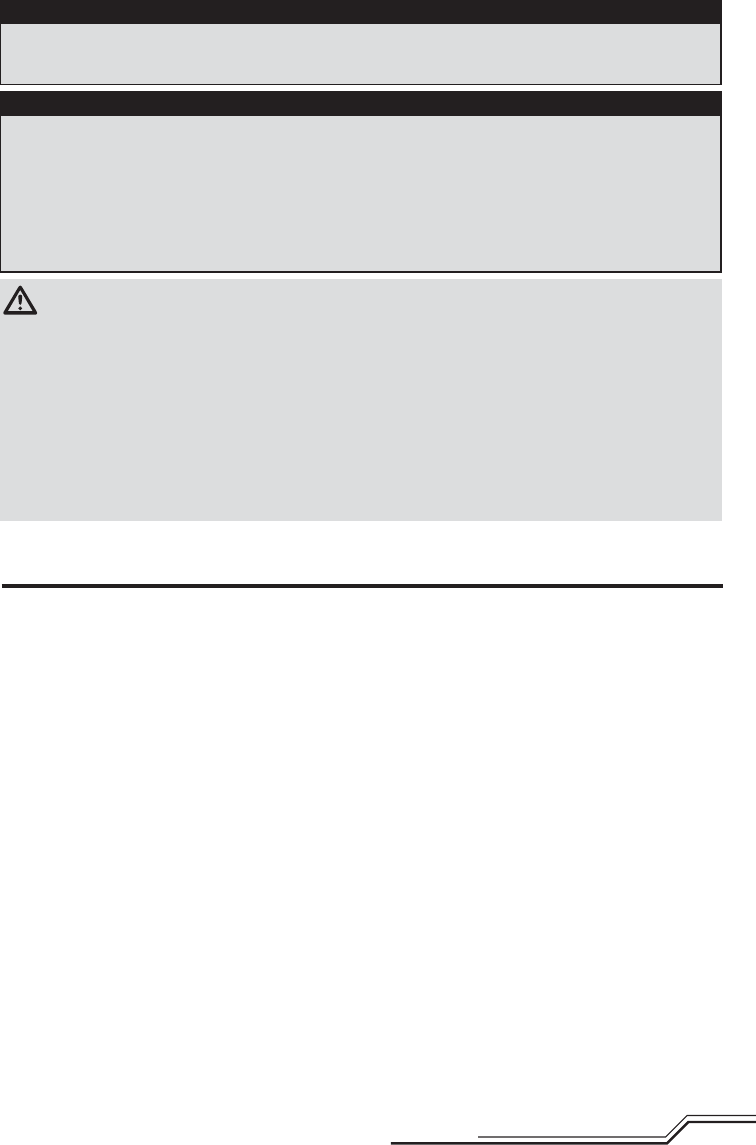
15 DE
WARNUNG: Lesen Sie die GESAMTE Bedienungsanleitung, um sich vor dem Betrieb mit den Produktfunktionen
vertraut zu machen. Wird das Produkt nicht korrekt betrieben, kann dies zu Schäden am Produkt oder persönli-
chem Eigentum führen oder schwere Verletzungen verursachen.
Dies ist ein hochentwickeltes Hobby-Produkt. Es muss mit Vorsicht und gesundem Menschenverstand betrieben werden
und benötigt gewisse mechanische Grundfähigkeiten. Wird dieses Produkt nicht auf eine sichere und verantwortungs-
volle Weise betrieben, kann dies zu Verletzungen oder Schäden am Produkt oder anderen Sachwerten führen. Dieses
Produkt eignet sich nicht für die Verwendung durch Kinder ohne direkte Überwachung eines Erwachsenen. Versuchen
Sie nicht ohne Genehmigung durch Horizon Hobby, LLC, das Produkt zu zerlegen, es mit inkompatiblen Komponenten
zu verwenden oder auf jegliche Weise zu erweitern. Diese Bedienungsanleitung enthält Anweisungen für Sicherheit,
Betrieb und Wartung. Es ist unbedingt notwendig, vor Zusammenbau, Einrichtung oder Verwendung alle Anweisungen
und Warnhinweise im Handbuch zu lesen und zu befolgen, damit es bestimmungsgemäß betrieben werden kann und
Schäden oder schwere Verletzungen vermieden werden.
Die folgenden Begriffe werden in der gesamten Produktliteratur verwendet, um auf unterschiedlich hohe Gefahren-
risiken beim Betrieb dieses Produkts hinzuweisen:
WARNUNG: Wenn diese Verfahren nicht korrekt befolgt werden, ergeben sich wahrscheinlich Sachschäden,
Kollateralschäden und schwere Verletzungen ODER mit hoher Wahrscheinlichkeit oberfl ächliche Verletzungen.
ACHTUNG: Wenn diese Verfahren nicht korrekt befolgt werden, ergeben sich wahrscheinlich Sachschäden UND die
Gefahr von schweren Verletzungen.
HINWEIS: Wenn diese Verfahren nicht korrekt befolgt werden, können sich möglicherweise Sachschäden UND geringe
oder keine Gefahr von Verletzungen ergeben.
• Halten Sie stets in allen Richtungen einen Sicherhe-
itsabstand um Ihr Modell, um Zusammenstöße oder
Verletzungen zu vermeiden. Dieses Modell wird von
einem Funksignal gesteuert, das Interferenzen von
vielen Quellen außerhalb Ihres Einfl ussbereiches unter-
liegt. Diese Interferenzen können einen augenblicklichen
Steuerungsverlust verursachen.
• Betreiben Sie Ihr Modell immer auf einer Freifl äche ohne
Fahrzeuge in voller Größe, Verkehr oder Menschen.
• Befolgen Sie stets sorgfältig die Anweisungen und
Warnhinweise für das Modell und jegliche optionalen
Hilfsgeräte (Ladegeräte, Akkupacks usw.).
• Bewahren Sie alle Chemikalien, Klein- und Elektroteile
stets außerhalb der Reichweite von Kindern auf.
• Setzen Sie Geräte, die für diesen Zweck nicht speziell
ausgelegt und geschützt sind, niemals Wasser aus.
Feuchtigkeit kann die Elektronik beschädigen.
• Stecken Sie keinen Teil des Modells in den Mund, da
dies zu schweren Verletzungen oder sogar zum Tod
führen kann.
• Betreiben Sie Ihr Modell nie mit fast leeren Senderak-
kus.
• Halten Sie das Fluggerät immer in Sicht und unter
Kontrolle.
• Gehen Sie sofort auf Motor Aus bei Rotorberührung.
• Verwenden Sie immer vollständig geladene Akkus.
• Lassen Sie immer den Sender eingeschaltet wenn das
Fluggerät eingeschaltet ist.
• Nehmen Sie vor der Demontage des Fluggerätes die
Akkus heraus.
• Halten Sie bewegliche Teile immer sauber.
• Halten Sie die Teile immer trocken.
• Lassen Sie Teile immer erst abkühlen bevor Sie sie
anfassen.
• Nehmen Sie die Akkus/Batterien nach Gebrauch heraus.
• Betreiben Sie Ihr Fluggerät niemals mit beschädigter
Verkabelung.
• Fassen Sie niemals bewegte Teile an.
HINWEIS
Alle Anweisungen, Garantien und anderen zugehörigen Dokumente können im eigenen Ermessen von Horizon Hobby, LLC
jederzeit geändert werden. Die aktuelle Produktliteratur fi nden Sie auf horizonhobby.com unter der Registerkarte „Support“
für das betreffende Produkt.
Spezielle Bedeutungen
Sicherheitsvorkehrungen und Warnhinweise
Nicht geeignet für Kinder unter 14 Jahren. Dies ist kein Spielzeug.
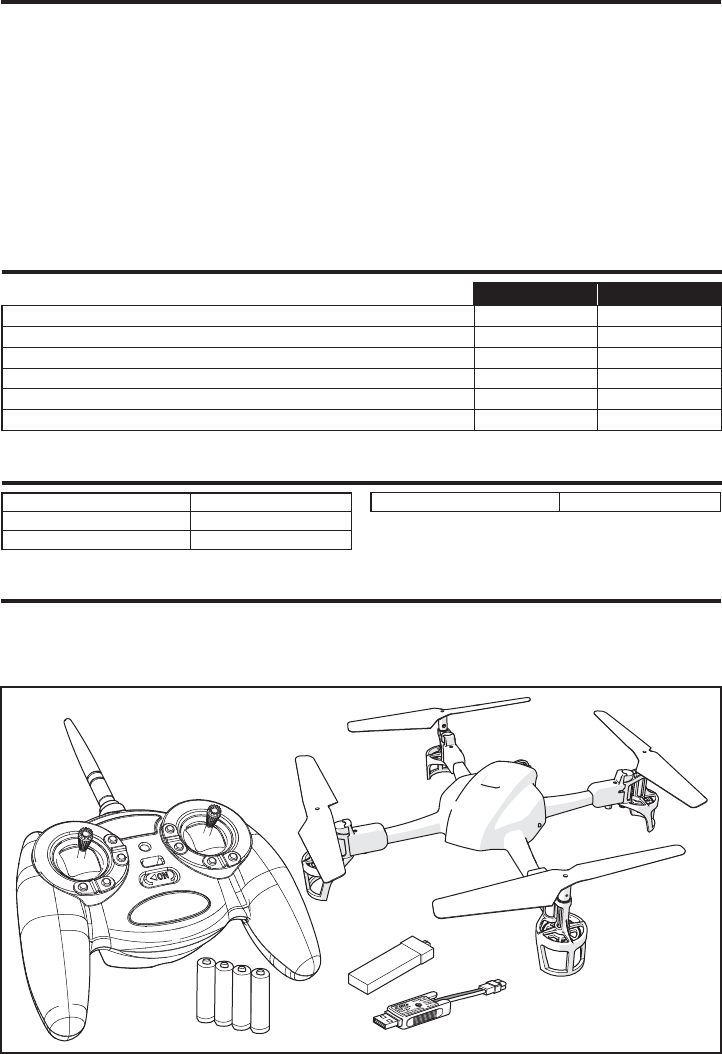
16
DE
Box Inhalt
Komponenten
Spezifi kationen
• Blade® Ozone™
• 3.7V 25C 500mAh 1S Li-Po Akku (nur RTF)
• 1S USB Li-Po Ladegerät (nur RTF)
• MLP4DSM Sender (nur RTF)
• 4 AA Batterien (nur RTF)
Inhaltsverzeichnis
Länge 172mm
Höhe 56mm
Propeller Durchmesser 65mm
Fluggewicht 75 g
Sie können Ihr Produkt online unter
www.bladehelis.com registrieren.
Komponenten ................................................................16
Spezifi kationen ..............................................................16
Box Inhalt ......................................................................16
Vorbereitung für den Erstfl ug .........................................17
Checkliste zum Fliegen ..................................................17
Akku-Warnhinweise .......................................................17
Aufl aden des Flugakkus .................................................17
Einsetzen der Senderbatterien (RTF) ..............................18
Einsetzen des Flugakkus ................................................18
Binden von Sender und Empfänger ................................19
SAFE Technologie ..........................................................20
Sendersteuerung ...........................................................20
Auswahl des Flugmodus ................................................21
LED Anzeigen .................................................................21
Einführung in die Hauptsteuerfunktionen........................22
Fliegen des Ozone .........................................................23
Checkliste für die Kontrolle und Wartung nach dem Flug 23
Hilfestellung zur Problemlösung .....................................23
Explosionszeichnung......................................................25
Teileliste ........................................................................25
Garantie und Service Informationen ...............................26
Garantie und Service Kontaktinformationen....................27
Konformitätshinweise für die Europäische Union ............27
RTF BLH9700 BNF BLH9750
Rumpf – Blade® Ozone™ (BLH9700) Inklusive Inklusive
Motoren – 8,53mm gebürstet, (BLH9709, CW) (BLH9710, CCW) Eingebaut Eingebaut
Elektronikplatine – Hauptschalttafel, SAFE® (BLH9706) Eingebaut Eingebaut
Akku – 500mAh 1S 3,7V 25C Li-Po (EFLB5001S25UM) Inklusive Erforderlich
Lader – 1S USB Li-Po, 500 mAh, Hochstrom-UMX (EFLC1013) Inklusive Erforderlich
Sender – MLP4DSM 2.4 GHz, 4 CH, BCMX2 (EFLH1064/B) Inklusive Erforderlich
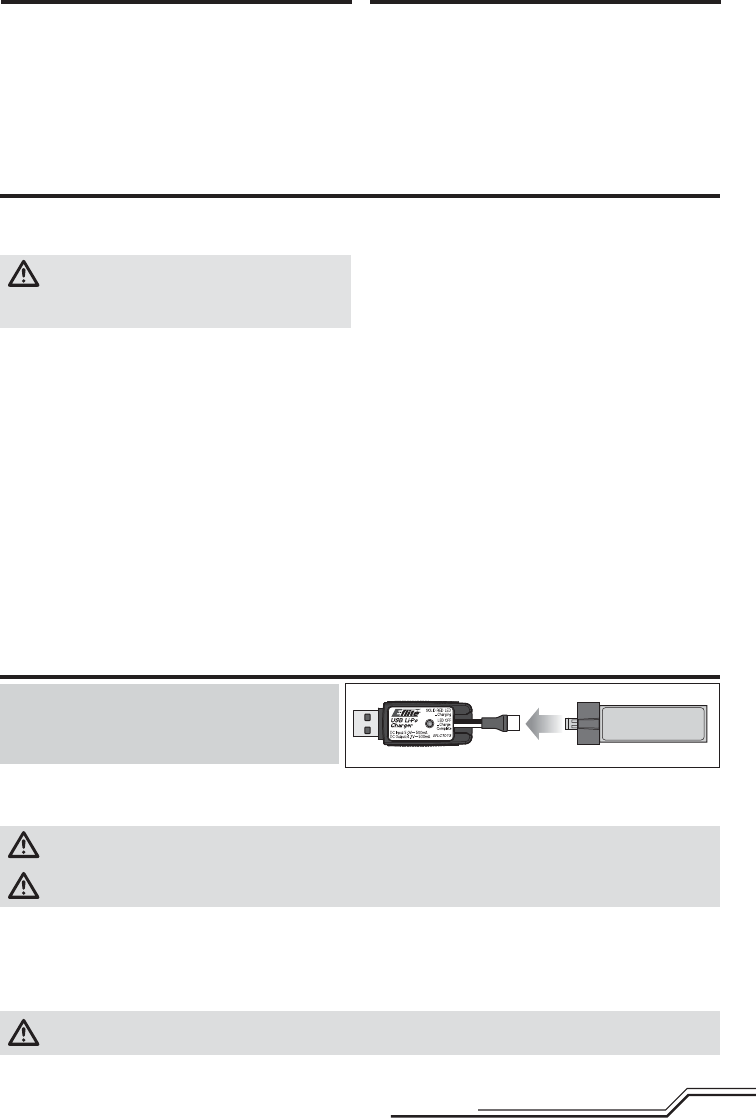
17 DE
Das dem Blade Ozone beiliegende Akkuladegerät (EFLC1013)
wurde speziell auf eine sichere Aufl adung des Li-Po-Akkus
ausgelegt.
ACHTUNG: Alle Anweisungen und Warnhinweise
müssen genau befolgt werden. Falsche Handha-
bung von Li-Po-Akkus kann zu Brand, Personen- und/oder
Sachwertschäden führen.
• Durch Handhabung, Aufl adung oder Verwendung des mitge-
lieferten Li-Po-Akkus übernehmen Sie alle mit Lithiumakkus
verbundenen Risiken.
• Sollte der Akku zu einem beliebigen Zeitpunkt beginnen, sich
aufzublähen oder anzuschwellen, stoppen Sie die Verwendung
unverzüglich. Falls dies beim Laden oder Entladen auftritt,
stoppen Sie den Lade-/Entladevorgang, und entnehmen Sie
den Akku. Wird ein Akku, der sich aufbläht oder anschwillt,
weiter verwendet, geladen oder entladen, besteht Brandge-
fahr.
• Lagern Sie den Akku stets bei Zimmertemperatur an einem
trockenen Ort.
• Bei Transport oder vorübergehender Lagerung des Akkus
muss der Temperaturbereich zwischen 40°F und 120°F (ca.
5 – 49°C) liegen. Akku oder Modell dürfen nicht im Auto oder
unter direkter Sonneneinstrahlung gelagert werden. Bei Lage-
rung in einem heißen Auto kann der Akku beschädigt werden
oder sogar Feuer fangen.
• Laden Sie die Akkus immer weit entfernt von brennbaren
Materialien.
• Überprüfen Sie immer den Akku vor dem Laden und laden Sie
niemals defekte oder beschädigte Akkus.
• Verwenden Sie ausschließlich ein Ladegerät das speziell für
das Laden von LiPo Akku geeignet ist. Das Laden mit einem
nicht geeignetem Ladegerät kann Feuer und / oder Sachbe-
schädigung zur Folge haben.
• Überwachen Sie ständig die Temperatur des Akkupacks
während des Ladens.
• Trennen Sie immer den Akku nach dem Laden und lassen das
Ladegerät abkühlen.
• Entladen Sie niemals ein LiPo Akku unter 3V pro Zelle unter
Last.
• Verdecken Sie niemals Warnhinweise mit Klettband.
• Lassen Sie niemals Akkus während des Ladens unbeauf-
sichtigt.
• Laden Sie niemals Akkus ausserhalb ihrer sicheren Grenzen.
• Laden Sie nur Akkus die kühl genug zum anfassen sind.
• Versuchen Sie nicht das Ladegerät zu demontieren oder zu
verändern.
• Lassen Sie niemals Minderjährige Akkus laden.
• Laden Sie niemals Akkus an extrem kalten oder heißen
Plätzen (empfohlener Temperaturbereich 5 – 49°) oder im
direkten Sonnenlicht.
Akku-Warnhinweise
Aufl aden des Flugakkus
HINWEIS: Laden Sie nur Akkus die kühl genug zum Anfas-
sen und unbeschädigt sind. Bitte prüfen Sie den Akku um
sicher zu stellen, dass er nicht beschädigt, angeschwollen,
verbogen, gebrochen und punktiert ist.
1. Stecken Sie das Ladegerät in den USB Anschluss.
2. Schließen Sie den Akku an das Ladekabel an.
3. Trennen Sie nach dem Laden den Akku unverzüglich vom Ladegerät.
ACHTUNG: Verwenden Sie nur Ladegeräte die zum Laden von LiPo Akkus geeignet sind. Ein Nichtbefolgen könnte zu
Feuer, Sachschäden und Verletzungen führen.
ACHTUNG: Überschreiten Sie niemals den empfohlenen Ladestrom.
LED Anzeige
Nach korrektem Anschluss leuchtet die LED auf dem Ladegerät Rot und zeigt damit den Ladevorgang an. Das Laden eines entla-
denen (nicht tiefentladenen) 500mAh Akkus dauert ca. 60 Minuten. Nach erfolgtem Ladevorgang ist die LED aus.
LADEN (leuchtet Rot)
LADEN FERTIG (AUS)
ACHTUNG: Entnehmen Sie nach dem Ladevorgang unverzüglich den Akku. Lassen Sie niemals den Akku am Ladegerät
angeschlossen.
Vorbereitung für den Erstfl ug
• Entnehmen und überprüfen Sie die Komponenten
• Laden Sie den Flugakku
• Setzen Sie den Akku ein wenn er vollständig geladen ist
• Programmieren Sie Ihren Sender (nur BNF Version)
• Binden Sie Ihren Sender (nur BNF Version)
• Machen Sie sich mit den Kontrollen vertraut
• Finden Sie eine geeignete Fläche zum fl iegen
Checkliste zum Fliegen
❏Schalten Sie immer den Sender zuerst ein
❏Stecken Sie den Flugakku an den Anschluß der
Kontrolleinheit an
❏Lassen Sie der Kontrolleinheit Zeit zum initialisieren und
armieren
❏Fliegen Sie das Modell
❏Landen Sie das Modell
❏Stecken Sie den Flugakku von der Kontrolleinheit ab
❏Schalten Sie immer den Sender als letztes aus
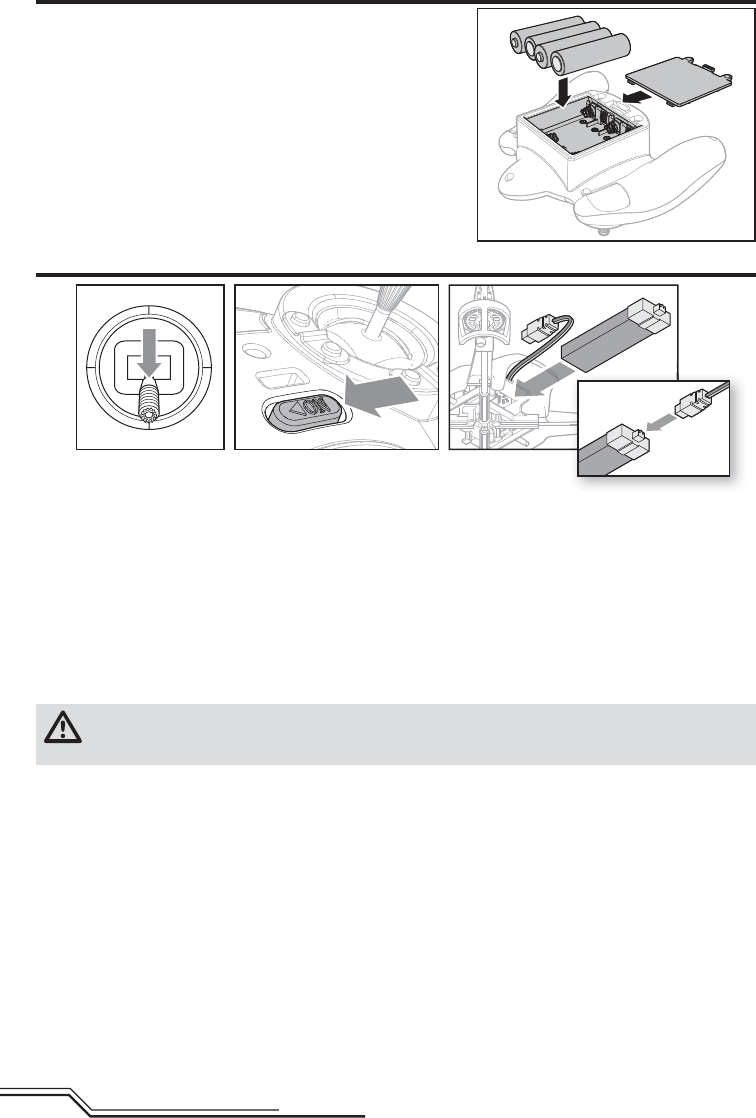
18
DE
Einsetzen der Senderbatterien (RTF)
Blinkt die LED und ertönt ein Piepton müssen die Senderbatterien
gewechselt werden.
Einsetzen des Flugakkus
12 3
4
1. Die Gaszufuhr in die niedrigste Einstellung bringen. Bei BNF-Flugzeugen „Gas halten“ aktivieren, wenn Ihr Sender so
ausgerüstet ist.
2. Sender einschalten.
3. Einsetzen der Akkus durch Einschieben in den Akku-Halterungsschlitz unter der Steuereinheit. Akku mit dem Etikett
nach oben in die Schlitze schieben, sodass der in die Akkuendkappe eingefasste Akkutaster in Kontakt kommt mit
dem Taster auf dem Akkufach.
4. Das Akku-Kabel mit der Steuereinheit verbinden.
5. Stellen Sie den Quadcopter auf eine ebene Fläche und lassen Sie das Flugzeug stehen, bis die LED an der Steuerein-
heit einen der folgenden Flugmodi anzeigt:
Durchgängig blau: Stabilitäts Modus, Schalterposition 1
Durchgängig rot: Agilitätsmodus, Schalterposition2
ACHTUNG: Trennen Sie immer den Akku vom Quadcopter, wenn Sie nicht fl iegen, um ein Tiefentladen des
Akkus zu vermeiden. Akkus, die unter die zulässige Grenze entladen werden, können dabei beschädigt werden,
was zu Leistungsverlust und potenzieller Brandgefahr beim Laden führen kann.
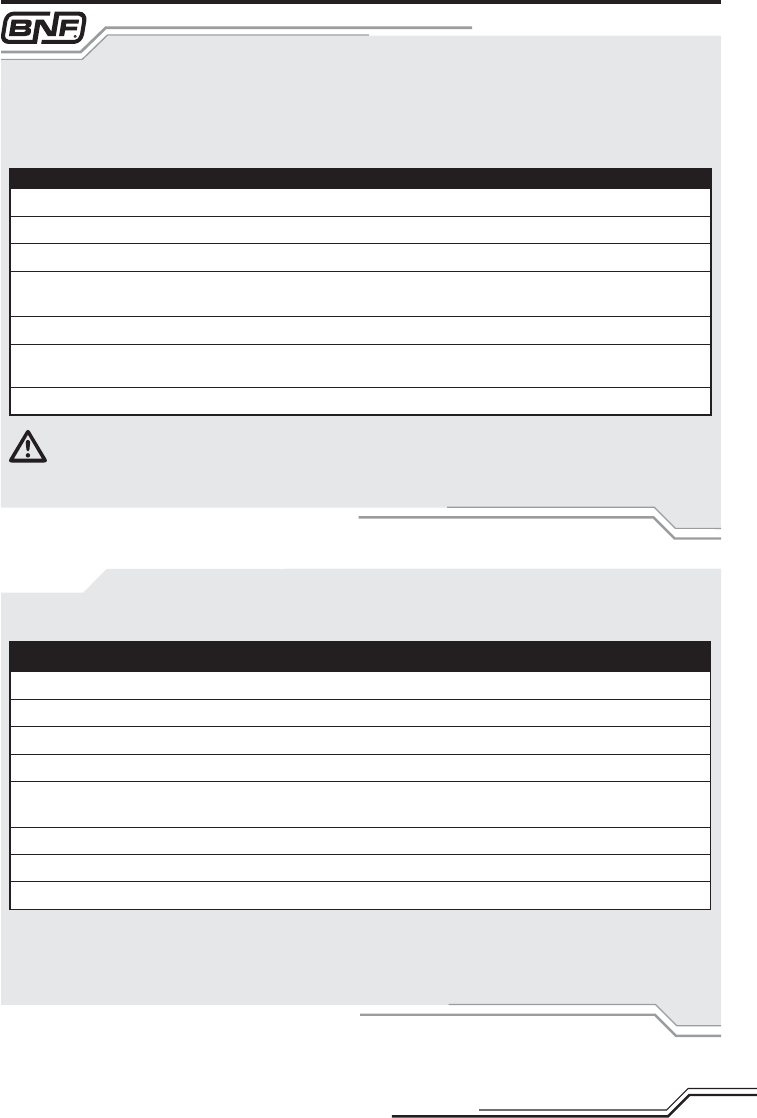
19 DE
ACHTUNG: Wenn Sie einen Futaba-Sender mit einem Spektrum DSM-Modul verwenden, müssen Sie den
Gaskanal reversieren (umkehren) und danach das System neu binden. Lesen Sie bitte für den Bindevorgang
und programmieren der Failsafeeinstellungen die Bedienungsanleitung des Spektrum Modules. Zum reversieren des
Gaskanals lesen Sie bitte in der Anleitung des Futaba Senders nach.
* Dieser Stickschalter kann ebenfalls für den Bindevorgang verwendet werden.
Wenn Probleme auftreten beachten Sie bitte die Bindeanweisungen und schauen in die Hilfestellung zur
Problemlösung. Kontaktieren Sie falls notwendig den technischen Service von Horizon Hobby. Eine Liste der
kompatiblen DSM Sender sehen Sie unter www.bindnfl y.com.
RTF
Binden von Sender und Empfänger
Ihr RTF Sender ist bereits an das Modell gebunden. Sollten Sie neu binden wollen folgen Sie bitte den
untenstehenden Anweisungen.
MLP4DSM Bindeprozess
1. Den Flug-Akku vom Quadcopter trennen.
2. Alle Trimmungen auf Ihrem Sender zentrieren.
3. Den Sender ausschalten und den Gashebel in die Position niedrig/aus bringen.
4. Den Flug-Akku am Quadcopter anschließen. Die LED auf dem Steuergerät blinkt nach 5 Sekunden.
5. Wenn das blaue Licht blinkt, den linken Knüppel* gedrückt halten, während sich der Sender einschaltet
(es ist ein „Klicken“ zu hören).
6. Den linken Knüppel loslassen. Der Sender wird einen Piepton abgeben und die Strom-LED wird blinken.
7. Der Quadcopter ist gebunden, wenn alle LEDs auf dem Flugzeug durchgängig leuchten.
8. Den Flug-Akku trennen und den Sender ausschalten.
Bei Verwendung eines Computersenders den Modelltyp auf „Acro“ oder „Flugzeug“ einstellen. Kanal 6 (Aux1) im Ka-
naleingangsmenü auf momentanes Schalten stellen, wie z.B. den Bindungsschalter (I) und den Getriebekanal 5 (Gear)
auf einen 3-Positionen-Schalter (Schalter B). Im Servo-Setup-Menü Kanal 6 (Aux1) umkehren.
Den Quadcopter an Ihren Sender binden unter Beachtung der nachfolgenden Anweisungen zum Binden des Senders
und Empfängers.
Der Bindevorgang
1. Den Flug-Akku vom Quadcopter trennen.
2. Alle Trimmungen auf Ihrem Sender zentrieren.
3. Den Sender ausschalten und die Gaszufuhr vollständig senken.
4. Den Flug-Akku an den Quadcopter anschließen. Alle LEDs am Flugzeug blinken schnell und zeigen damit an, dass
das Flugzeug in den Bindungsmodus übergegangen ist.
5. Den Sender während des Einschaltens in den Bindungsmodus bringen.
6. Den Bindungstaster/-schalter nach 2 bis 3 Sekunden loslassen. Der Quadcopter ist gebunden, wenn alle LEDs
auf dem Flugzeug durchgängig leuchten.
7. Den Flug-Akku trennen und den Sender ausschalten.
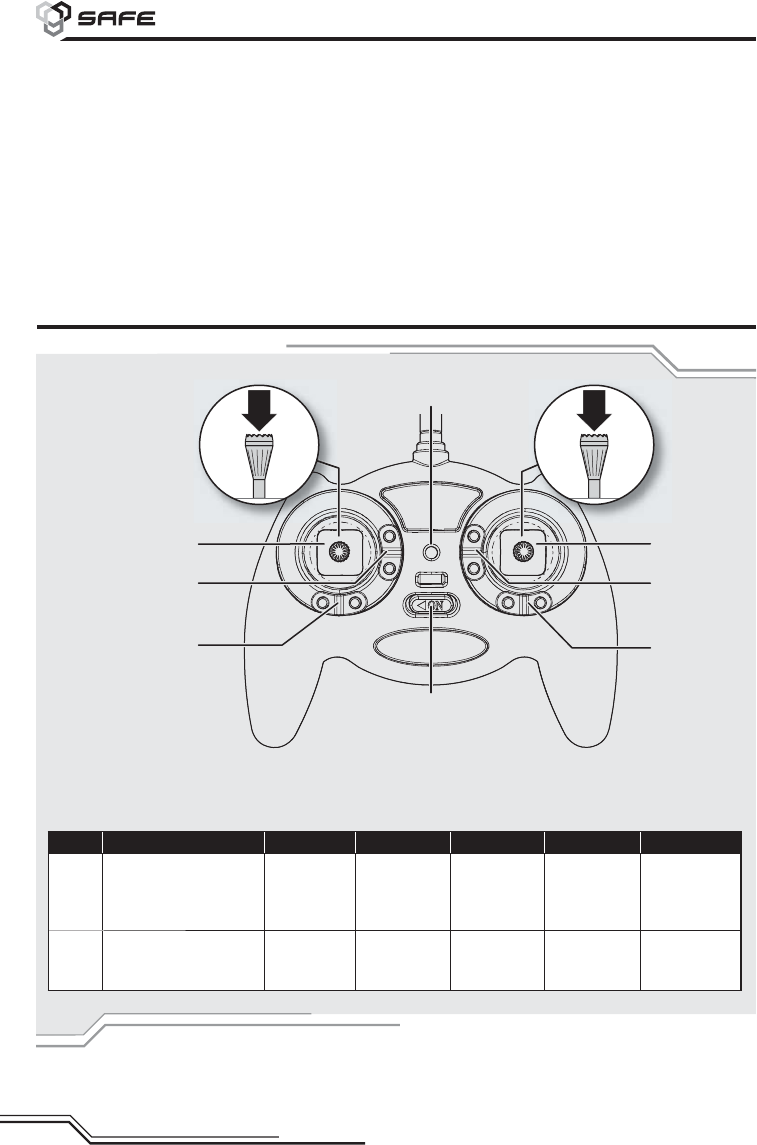
20
DE
RTF
Sendersteuerung
Die revolutionäre SAFE Technologie von Horizon Hobby (Sensor Assited Flight Envelope) verwendet eine innovative Kombination
aus Multi-Achs Sensoren und Software, die es erlauben, die relative Position des Fluggerätes im Raum jederzeit zu bestimmen.
Diese dreidimensionale Wahrnehmung schafft eine schräglagenbegrenzte Fluglage die Sie sicherer Fliegen läßt. Dabei werden
Roll- und Nickwinkel beeinfl usst und geregelt, um die Flugsicherheit zu erhöhen. Und das System kann weit mehr, als die
Stabilisierung des Fluggerätes. Die verschiedenen Flugmodi können vom Piloten gemäß seiner Fähigkeiten individuell eingestellt
werden.
SAFE Technologie im Überblick:
• Flugstabilisierung über einen Schalter zuschaltbar.
• Mehrere Modi zur Anpassung von SAFE and die Fähigkeiten des Piloten.
Und das Beste an allem ist, dass SAFE keine weiteren Einstellungen und Vorbereitungen erfordert. Jedes Modell, welches
mit SAFE ausgestattet wurde, verfügt über eine angepasste und optimierte Programmierung der Elektronik, um für maximale
Sicherheit und maximalen Flugspaß zu sorgen. FLYSAFERC.com
Technologie
®
ABCDEF
Modus
1
Querruder (links/rechts)
Gas (auf/ab) Gas trimm Querruder-
trimm
Seitenruder-
trimm
Höhenruder-
trimm
Seitenruder
(links/rechts)
Höhenruder
(auf/ab)
Modus
2
Querruder (links/rechts)
Höhenruder (auf/ab)
Höhenruder-
trimm
Querruder-
trimm
Seitenruder-
trimm Gas trimm
Seitenruder
(links/rechts)
Gas (auf/ab)
D
E
F
• Ein/Aus-LED
C
B
A
EIN/AUS-Schalter
Wenn die Trimmtasten gedrückt werden, geben sie einen Signalton von sich, der bei jedem erneuten Drücken höher
oder tiefer wird. Die mittlere oder neutrale Trimmstellung erklingt in der mittleren Tonhöhe. An den äußeren Enden des
Steuerbereichs erklingt eine Tonfolge.
Auswahl des
Flugmodus
• Einbinden
• Langes Drücken:
Ein-/Ausschalten
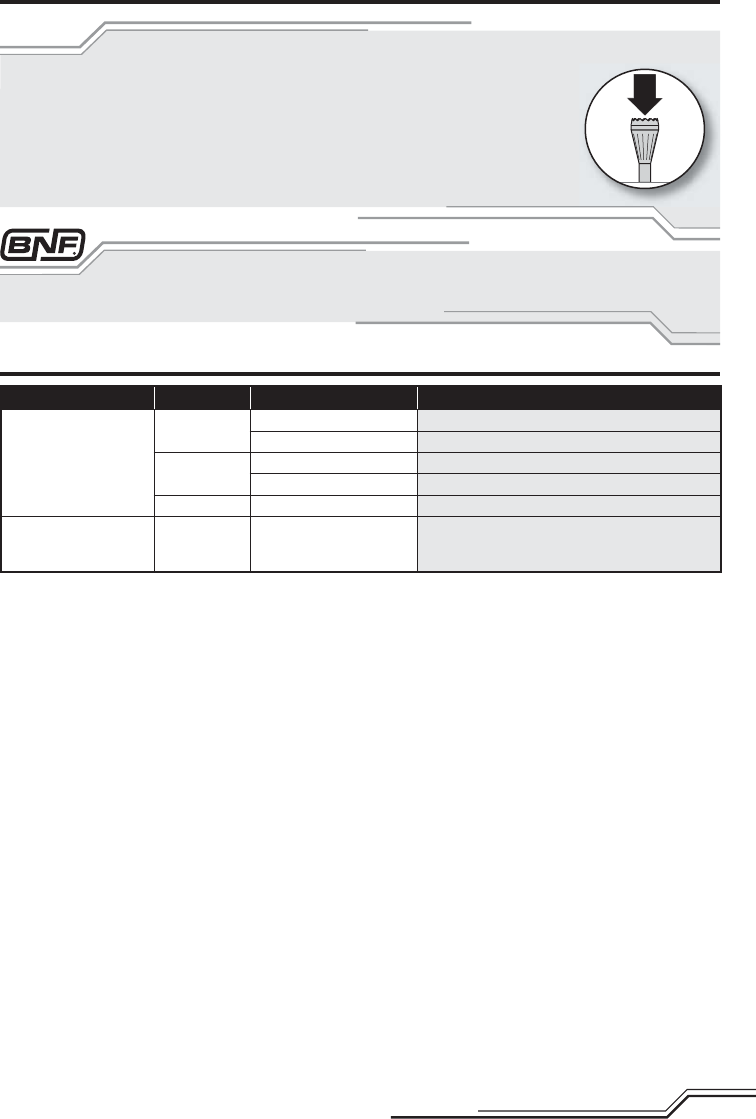
21 DE
RTF
LED Anzeigen
Änderung des Flugmodus durch Herunterdrücken des rechten Knüppels. Sicherstellen, dass
sich der Schalter für den Flugmodus vor dem Flug in der gewünschten Position befi ndet.
• Im Stabilitätsmodus (Schalterposition 1) bieten die Bedienelemente einen minimalen
Querneigungswinkel. Dieser Modus wird durch blau leuchtende Flugsteuerungs-LEDs am
Quadrocopter angezeigt.
• Dieser Agilitätsmodus (Schalterposition2) wird durch rot leuchtende Flugsteuer-LEDs am
Quadrocopter angezeigt.
Bei Kauf eines BNF Ozone™-Quadcopters, werden mit dem Kannel-5-Schalter auf dem Sender die Flugmodi ausgewählt.
Auswahl des Flugmodus
Ausrüstung LED Farbe LED Status Betrieb
Quadcopter:
Flugsteuerungs-LEDs
auf der Steuerplatine
Blau Leuchtet Stabilitätsmodus, Schalterposition 1
Blinkt Verlust von HF/Sender OFF
Rot Leuchtet Agilitätsmodus, Schalterposition2
Blinkt Batterie fast leer
Weiß Blinkt Deaktiviert, bereit
Quadcopter:
LEDs an der Außenmo-
torverkleidung
Weiß (vorne)
Rot (hinten) Blinkt langsam In Bezug auf die Gaszufuhr
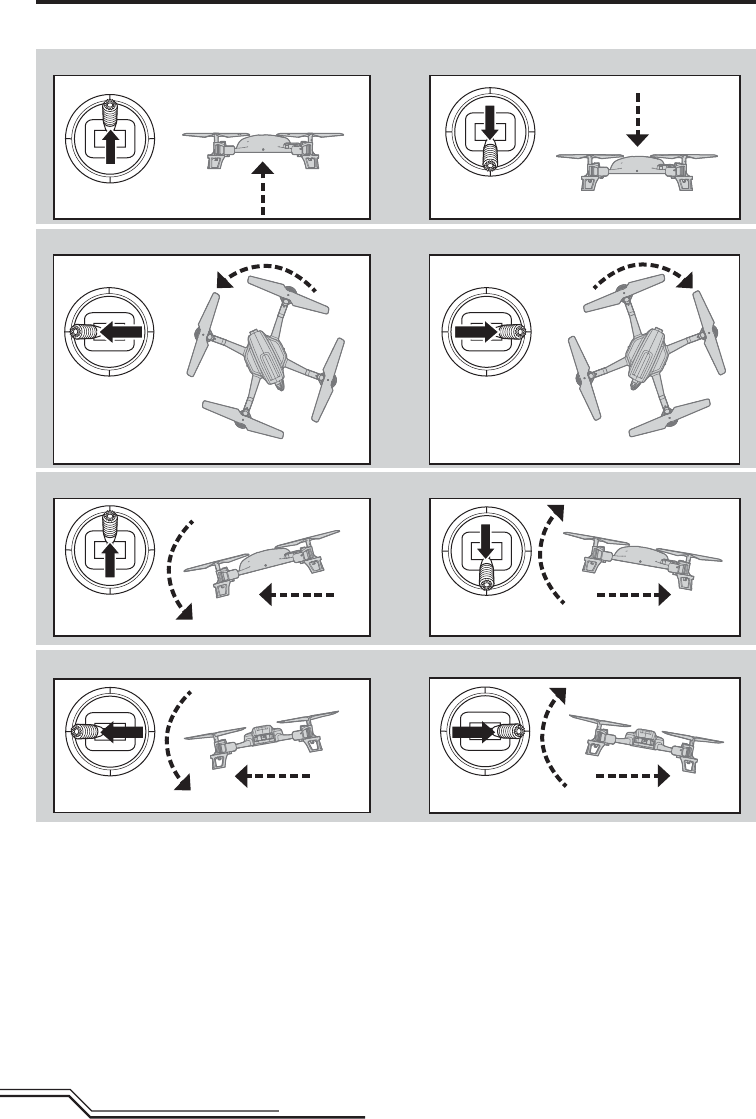
22
DE
Höhenruder
Vorwärts Rückwärts
Seitenansicht
Seitenruder
Einführung in die Hauptsteuerfunktionen
Wenn Ihnen die Steuerung Ihres Ozone noch nicht geläufi g ist, nehmen Sie sich bitte ein paar Minuten Zeit, umsich mit
ihr vertraut zu machen, bevor Sie Ihren ersten Flug versuchen.
Gasgeber
Seitenansicht
•
Querruder
Seitenansicht
Nase dreht nach rechtsNase dreht nach links
Seitenansicht
Sinken
Aufsteigen
Nach links Nach rechts
Rückansicht Rückansicht
Höhenruder
nach unten
Höhenruder
nach oben
Seitenruder
nach links Seitenruder
nach rechts
Gasgeber nach
unten
Gasgeber nach
oben
Querruder
nach links Querruder nach
rechts
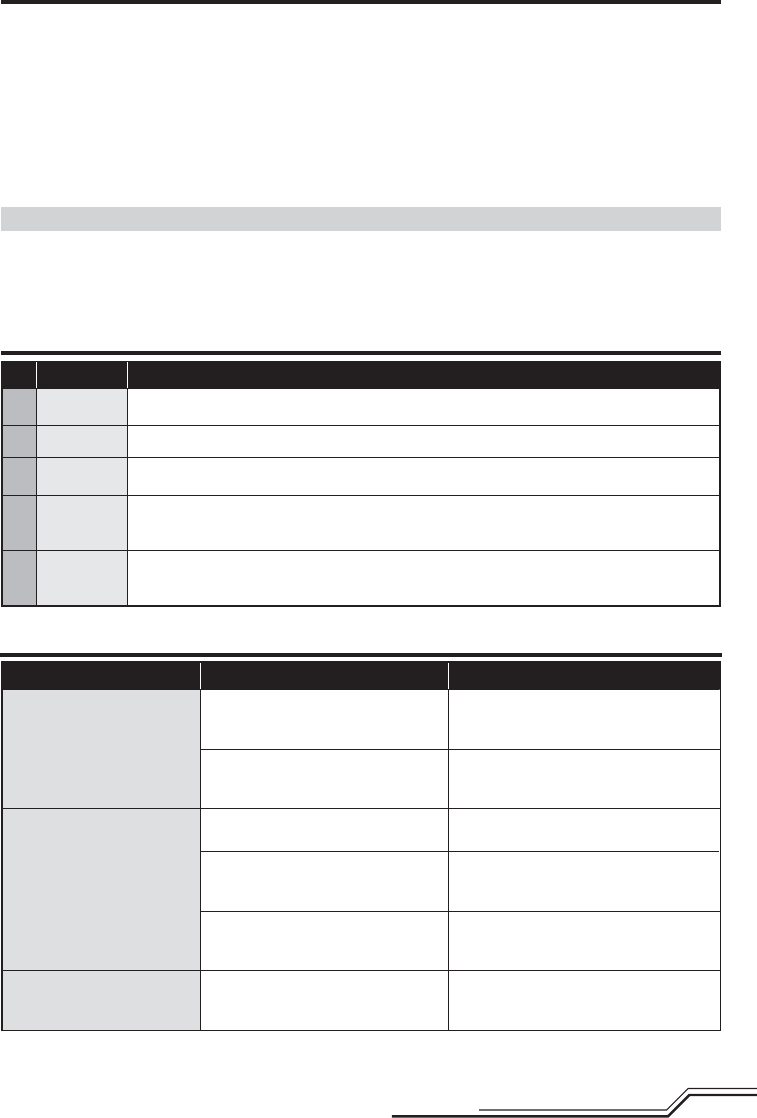
23 DE
Checkliste für die Kontrolle und Wartung nach dem Flug
√
Reinigung Vergewissern Sie sich vor der Reinigung, dass der Akku nicht angeschlossen ist. Entfernen Sie
Staub und Schmutzrückstände mit einer weichen Bürste oder einem trockenen fusselfreien Tuch.
Motoren Ersetzen Sie den Motor, wenn das Modell im geraden Steigfl ug nach einer Seite ausbricht.
Verkabe-
lung
Stellen Sie sicher, dass die Verkabelung keine beweglichen Teile blockiert. Ersetzen Sie beschädigte
Verkabelung und lose Stecker.
Befesti-
gungsele-
mente
Stellen Sie sicher, dass keine Schrauben, andere Befestigungselemente oder Stecker lose sind.
Ziehen Sie Metallschrauben in Kunststoffteilen nicht zu stark an. Ziehen Sie Schrauben so an, dass
die Teile zusammengefügt sind, und drehen Sie die Schrauben danach um eine 1/8-Umdrehung.
Rotoren
Stellen Sie sicher, dass Rotorblätter oder andere Teile, die sich bei hoher Geschwindigkeit bewegen,
unbeschädigt sind, d. h. beispielsweise keine Risse, Grater, Schnitzer oder Kratzer aufweisen. Erset-
zen Sie beschädigte Teile vor dem Flug.
Hilfestellung zur Problemlösung
Problem Mögliche Ursache Lösung
Inkonsistente Quadcopterkontrolle
oder große Trimmeingaben er-
forderlich.
Fluggerät wurde nicht auf eine ebene
Fläche bei der Initialisierung gestellt.
Ziehen Sie den Flugakku ab, stellen Sie die
Trimmung auf Neutral und stecken Sie den
Akku zur Neuinitialisierung wieder an.
Akku liegt nicht richtig im Akkuschacht. Korrigieren Sie die Position im Akkuschacht, so
das der Schwerpunkt des
Quadcopters in dessen Mitte liegt.
Quadcopter reagiert nicht auf Gas.
Gastrimmung oder Gasknüppel zu hoch. Bringen Sie Gashebel und Trimmung auf die
niedrigste Einstellung.
Quadcopter wurde während der
Intialisierung bewegt.
Trennen Sie den Flugakku, initialisieren Sie den
Quad Copter neu, dabei darf er nicht bewegt
werden.
Gaskanal ist reversiert. Trennen Sie den Flugakku, reversieren den
Gaskanal auf dem Sender und schließen den
Flugakku wieder an.
Quadcopter funktioniert nicht
und riecht nach Anschluss des
Flugakkus verbrannt.
Flugakku ist mit der falschen Polarität
angeschlossen. Ersetzen Sie das 5-in-1 Kontrollboard. Schlie-
ßen Sie den Flugakku in richtiger Polarität an.
Starten
Erhöhen Sie das Gas bis das Modell in ca 60cm Höhe ist und stellen dann die Trimmung ein bis das Modell wie gewün-
scht fl iegt. Haben Sie die Trimmung eingestellt können Sie das Modell fl iegen.
Mit dem im Lieferumfang enthaltenem Akku sind Flugzeiten von 5 bis 10 Minuten möglich.
Niederspannungsabschaltung (LVC)
Die Niederspannungsabschaltung reduziert die Leistung zum Motor wenn die Akkuspannung sinkt. Wenn die Motorleis-
tung und die blaue und rote LED auf dem 5 in 1 Kontrollboard leuchten, landen Sie den Copter unverzüglich und laden
den Flugakku.
Die Niederspannungsabschaltung verhindert nicht die Tiefentladung während der Lagerung.
HINWEIS: Wiederholtes fl iegen in die Niederspannungsabschaltung beschädigt den Akku.
Landen
Um zu landen verringern Sie langsam das Gas im niedrigen Schwebefl ug und setzen auf. Trennen Sie nach Landen den
Akku und entnehmen ihn aus dem Copter und eine Tiefentladung zu verhindern. Laden Sie den Akku vollständig auf
bevor Sie ihn einlagern. Überprüfen Sie bei der Lagerung den Akku, dass die Spannung nicht unter 3 Volt fällt.
Fliegen des Ozone™
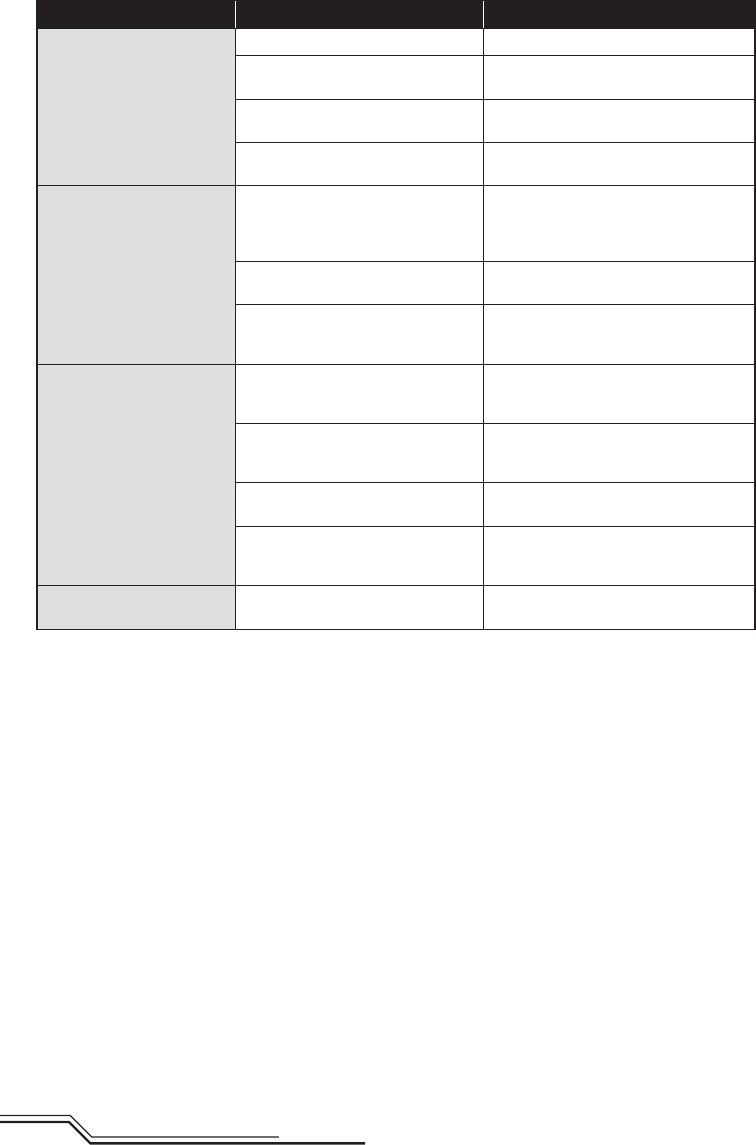
24
DE
Problem Mögliche Ursache Lösung
Reduzierte Flugzeit oder zu wenig
Leistung.
Flugakku ist zu gering geladen. Laden Sie den Flugakku vollständig auf.
Stromversorgung des Ladegerätes ist
unzureichend. Verwenden Sie eine andere USB Stromquelle
für den Lader.
Flugakku ist beschädigt. Ersetzen Sie den Flugakku und folgen
Sie den Akkuanweisungen.
Flugbedingungen möglicherweise zu kalt. Stellen Sie sicher dass der Akku vor
Benutzung warm ist (Raumtemparatur).
LED auf dem Empfänger blinkt
schnell, Quad-Copter reagiert bei
Bindung nicht auf Sender.
Sender war zu nah am Flugzeug während
des Bindevorganges.
Schalten Sie den Sender aus. Stellen Sie den
Sender weiter vom Fluggerät weg. Trennen und
schließen Sie den Akku erneut an den Quad-
Copter an. Folgen Sie den Bindeanweisungen.
Bindeschalter wurde beim Einschalten des
Senders nicht gedrückt. Schalten Sie den Sender aus und wiederholen
Sie den Bindeprozess.
Das Fluggerät oder der Sender ist zu nahe
an einem Metallkörper, einer Strahlungs-
quelle oder einem anderen Sender.
Versuchen Sie den Vorgang noch einmal an
einem anderen Ort.
LED auf dem Empfänger blinkt
schnell und der Quadcopter re-
agiert nicht auf den Sender (nach
dem Binden).
Es wurde weniger als 5 Sekunden nach
Einschalten des Senders der Flugakku
angeschlossen.
Lassen Sie den Sender eingeschaltet. Trennen
sie den Akku und schließen ihn erneut an.
Der Quadcopter ist an einen anderen Mod-
ellspeicher gebunden
(Nur Modelmatch Sender).
Wählen Sie den richtigen Modellspeicher auf
dem Sender. Trennen und verbinden Sie den
Flugakku an den Quadcopter erneut.
Ladung des Flugakkus zu gering oder
Senderbattereien zu schwach. Ersetzen oder laden Sie die Akkus.
Das Fluggerät oder der Sender ist zu nahe
an einem Metallkörper, einer Starhlungs-
quelle oder einem anderen Sender.
Versuchen Sie den Vorgang noch einmal an
einem anderen Ort.
Absturz unverzüglich nach dem
Abheben. Propeller falsch montiert oder falscher Flug
Mode gewählt. Führen Sie die notwendigen
Einstellungen durch.
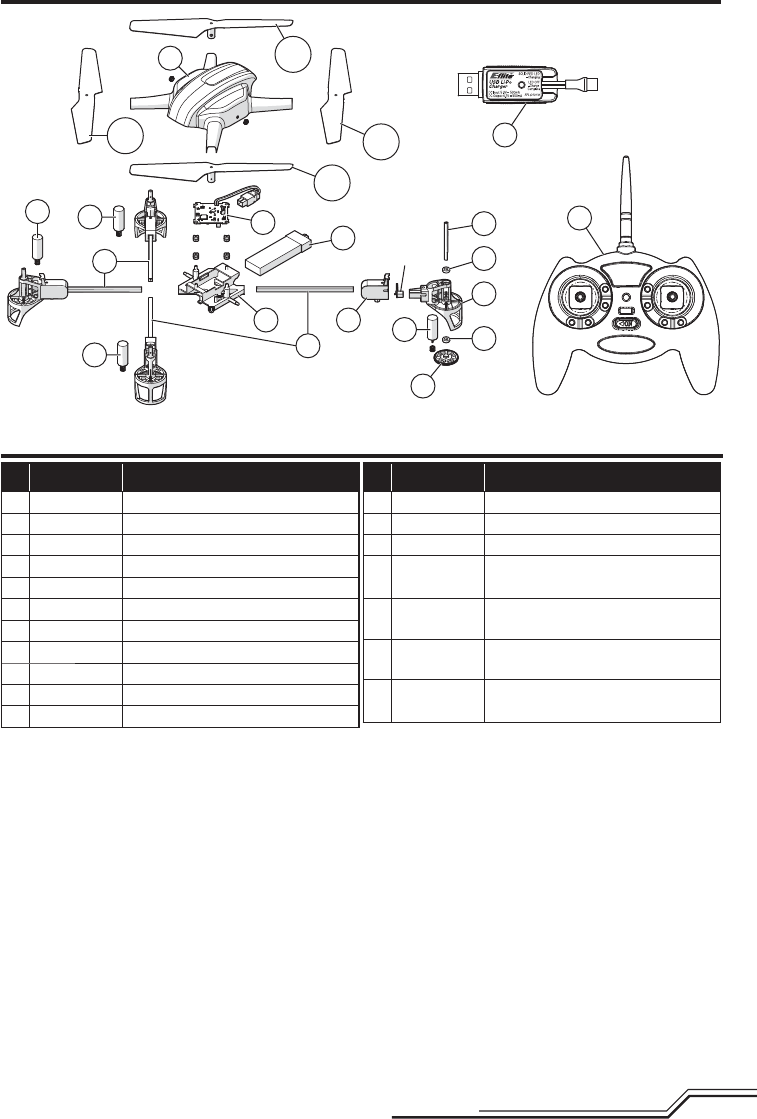
25 DE
Explosionszeichnung
Teileliste
Teil # Beschreibung
1 BLH9706 Hauptschalttafel Ozone
2 BLH9707 Linker Ausleger (2)
3 BLH9708 Rechter Ausleger (2)
4 BLH9710 Motor gegen den Uhrzeigersinn
5 BLH9709 Motor im Uhrzeigersinn
6 BLH9702 Innerer Rahmen
7 BLH9704 Baldachin
8 BLH9703 Kompletter Propellersatz (4)
9 BLH9705 Motorhalterung (Semi-Transp)
10 BLH9712 Landekufen
11 BLH7521 Propeller, Linksrotation, schwarz (2))
Teil # Beschreibung
12 BLH7520 Propeller, CW Rotation, schwarz, (2)
13 BLH7513 Propellerwelle, Karbon
14 BLH3506 Hauptzahnrad: BMSR, mCP S / X
15 BLH3515 Hauptwellenlager, 3x6x2mm (2):
BMCX / 2 / MSR, MH-35, mCP X
16 EFLB-
5001S25UM
3,7 V 500 mAh 1 S 25C LiPo,
hochstrom UMX stecker
17 EFLC1013 1S USB-LiPo-Ladegerät, 500 mAh,
Hochstrom-UMX-Anschluss
18 EFLH1064/B Klinge MLP4DSM 4CH Sender,
2,4 GHz: BMCX2, 120SR
14
15
15
LED
13
17
18
10
8
12 8
12
8
11
8
11
1
6
2
3
9
16
4
4
5
5
7

26
DE
Garantie und Service Informationen
Warnung
Ein ferngesteuertes Modell ist kein Spielzeug. Es kann, wenn
es falsch eingesetzt wird, zu erheblichen Verletzungen bei
Lebewesen und Beschädigungen an Sachgütern führen. Betreiben
Sie Ihr RC-Modell nur auf freien Plätzen und beachten Sie alle
Hinweise der Bedienungsanleitung des Modells wie auch der
Fernsteuerung.
Garantiezeitraum
Exklusive Garantie Horizon Hobby LLC (Horizon) garantiert, dass
dasgekaufte Produkt frei von Material- und Montagefehlern ist.
Der Garantiezeitraum entspricht den gesetzlichen Bestimmung
des Landes, in dem das Produkt erworben wurde. In
Deutschland beträgt der Garantiezeitraum 6 Monate und der
Gewährleistungszeitraum 18 Monate nach dem Garantiezeitraum.
Einschränkungen der Garantie
(a) Die Garantie wird nur dem Erstkäufer (Käufer) gewährt und
kann nicht übertragen werden. Der Anspruch des Käufers
besteht in der Reparatur oder dem Tausch im Rahmen die-
ser Garantie. Die Garantie erstreckt sich ausschließlich auf
Produkte, die bei einem autorisierten Horizon Händler erworben
wurden. Verkäufe an dritte werden von dieser Garantie nicht
gedeckt. Garantieansprüche werden nur angenommen, wenn
ein gültiger Kaufnachweis erbracht wird. Horizon behält sich
das Recht vor, diese Garantiebestimmungen ohne Ankündigung
zu ändern oder modifizieren und widerruft dann bestehende
Garantiebestimmungen.
(b) Horizon übernimmt keine Garantie für die Verkaufbarkeit des
Produktes, die Fähigkeiten und die Fitness des Verbrauchers
für einen bestimmten Einsatzzweck des Produktes. Der Käufer
allein ist dafür verantwortlich, zu prüfen, ob das Produkt seinen
Fähigkeiten und dem vorgesehenen Einsatzzweck entspricht.
(c) Ansprüche des Käufers ¬ Es liegt ausschließlich im Ermessen
von Horizon, ob das Produkt, bei dem ein Garantiefall fest-
gestellt wurde, repariert oder ausgetauscht wird. Dies sind die
exklusiven Ansprüche des Käufers, wenn ein Defekt festgestellt
wird.
Horizon behält sich vor, alle eingesetzten Komponenten zu
prüfen, die in den Garantiefall einbezogen werden können. Die
Entscheidung zur Reparatur oder zum Austausch liegt nur bei
Horizon. Die Garantie schließt kosmetische Defekte oder Defekte,
hervorgerufen durch höhere Gewalt, falsche Behandlung des
Produktes, falscher Einsatz des Produktes, kommerziellen Einsatz
oder Modifikationen irgendwelcher Art aus.
Die Garantie schließt Schäden, die durch falschen Einbau, falsche
Handhabung, Unfälle, Betrieb, Service oder Reparaturversuche, die
nicht von Horizon ausgeführt wurden aus. Rücksendungen durch
den Käufer direkt an Horizon oder eine seiner Landesvertretung
bedürfen der Schriftform.
Schadensbeschränkung
Horizon ist nicht für direkte oder indirekte Folgeschäden,
Einkommensausfälle oder kommerzielle Verluste, die in irgendei-
nem Zusammenhang mit dem Produkt stehen verantwortlich,
unabhängig ab ein Anspruch im Zusammenhang mit einem
Vertrag, der Garantie oder der Gewährleistung erhoben werden.
Horizon wird darüber hinaus keine Ansprüche aus einem
Garantiefall akzeptieren, die über den individuellen Wert des
Produktes hinaus gehen. Horizon hat keinen Einfluss auf den
Einbau, die Verwendung oder die Wartung des Produktes oder
etwaiger Produktkombinationen, die vom Käufer gewählt werden.
Horizon übernimmt keine Garantie und akzeptiert keine Ansprüche
für in der folge auftretende Verletzungen oder Beschädigungen.
Mit der Verwendung und dem Einbau des Produktes akzeptiert
der Käufer alle aufgeführten Garantiebestimmungen ohne
Einschränkungen und Vorbehalte.
Wenn Sie als Käufer nicht bereit sind, diese Bestimmungen im
Zusammenhang mit der Benutzung des Produktes zu akzeptieren,
werden Sie gebeten, dass Produkt in unbenutztem Zustand in der
Originalverpackung vollständig bei dem Verkäufer zurückzugeben.
Sicherheitshinweise
Dieses ist ein hochwertiges Hobby Produkt und kein Spielzeug.
Es muss mit Vorsicht und Umsicht eingesetzt werden und
erfordert einige mechanische wie auch mentale Fähigkeiten. Ein
Versagen, das Produkt sicher und umsichtig zu betreiben kann zu
Verletzungen von Lebewesen und Sachbeschädigungen erhebli-
chen Ausmaßes führen. Dieses Produkt ist nicht für den Gebrauch
durch Kinder ohne die Aufsicht eines Erziehungsberechtigten
vorgesehen. Die Anleitung enthält Sicherheitshinweise und
Vorschriften sowie Hinweise für die Wartung und den Betrieb
des Produktes. Es ist unabdingbar, diese Hinweise vor der ersten
Inbetriebnahme zu lesen und zu verstehen. Nur so kann der
falsche Umgang verhindert und Unfälle mit Verletzungen und
Beschädigungen vermieden werden.
Fragen, Hilfe und Reparaturen
Ihr lokaler Fachhändler und die Verkaufstelle können eine
Garantiebeurteilung ohne Rücksprache mit Horizon nicht durch-
führen. Dies gilt auch für Garantiereparaturen. Deshalb kontak-
tieren Sie in einem solchen Fall den Händler, der sich mit Horizon
kurz schließen wird, um eine sachgerechte Entscheidung zu fällen,
die Ihnen schnellst möglich hilft.
Wartung und Reparatur
Muss Ihr Produkt gewartet oder repariert werden, wenden Sie sich
entweder an Ihren Fachhändler oder direkt an Horizon.
Rücksendungen / Reparaturen werden nur mit einer von Horizon
vergebenen RMA Nummer bearbeitet. Diese Nummer erhalten
Sie oder ihr Fachhändler vom technischen Service. Mehr
Informationen dazu erhalten Sie im Serviceportal unter www.
Horizonhobby.de oder telefonisch bei dem technischen Service
von Horizon.
Packen Sie das Produkt sorgfältig ein. Beachten Sie, dass der
Originalkarton in der Regel nicht ausreicht, um beim Versand nicht
beschädigt zu werden. Verwenden Sie einen Paketdienstleister
mit einer Tracking Funktion und Versicherung, da Horizon bis zur
Annahme keine Verantwortung für den Versand des Produktes
übernimmt. Bitte legen Sie dem Produkt einen Kaufbeleg bei,
sowie eine ausführliche Fehlerbeschreibung und eine Liste aller
eingesendeten Einzelkomponenten. Weiterhin benötigen wir die
vollständige Adresse, eine Telefonnummer für Rückfragen, sowie
eine Email Adresse.
Garantie und Reparaturen
Garantieanfragen werden nur bearbeitet, wenn ein
Originalkaufbeleg von einem autorisierten Fachhändler beiliegt,
aus dem der Käufer und das Kaufdatum hervorgeht. Sollte
sich ein Garantiefall bestätigen wird das Produkt repariert
oder ersetzt. Diese Entscheidung obliegt einzig Horizon Hobby.
Kostenpflichtige Reparaturen
Liegt eine kostenpflichtige Reparatur vor, erstellen wir einen
Kostenvoranschlag, den wir Ihrem Händler übermitteln. Die
Reparatur wird erst vorgenommen, wenn wir die Freigabe des
Händlers erhalten. Der Preis für die Reparatur ist bei Ihrem
Händler zu entrichten. Bei kostenpflichtigen Reparaturen werden
mindestens 30 Minuten Werkstattzeit und die Rückversandkosten
in Rechnung gestellt. Sollten wir nach 90 Tagen keine
Einverständniserklärung zur Reparatur vorliegen haben, behalten
wir uns vor, das Produkt zu vernichten oder anderweitig zu ver-
werten.
ACHTUNG: Kostenpflichtige Reparaturen nehmen wir nur
für Elektronik und Motoren vor. Mechanische Reparaturen,
besonders bei Hubschraubern und RC-Cars sind extrem
aufwendig und müssen deshalb vom Käufer selbst
vorgenommen werden.
5/2015
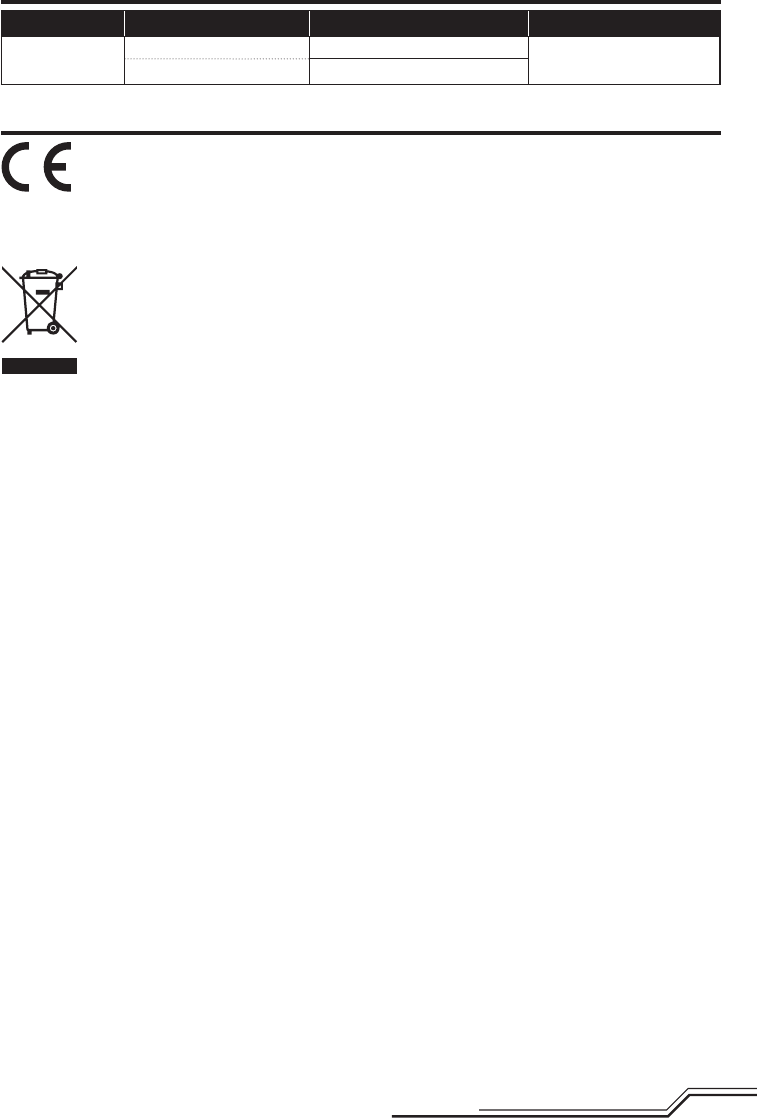
27 DE
Garantie und Service Kontaktinformationen
Land des Kauf Horizon Hobby Telefon/E-mail Adresse Adresse
Europäische Union Horizon Technischer Service service@horizonhobby.eu Hanskampring 9
D 22885 Barsbüttel, Germany
Sales: Horizon Hobby GmbH +49 (0) 4121 2655 100
EU Konformitätserklärung:
BLH9700: Horizon LLC erklärt hiermit, dass dieses Produkt konform zu den essentiellen Anforderungen der RED
und EMC Direktive.
BLH9750: Horizon LLC erklärt hiermit, dass dieses Produkt konform zu den essentiellen Anforderungen der RED Direktive.
Eine Kopie der Konformitätserklärung ist online unter folgender Adresse verfügbar :
http://www.horizonhobby.com/content/support-render-compliance.
Konformitätshinweise für die Europäische Union
Entsorgung von Elektro- und Elektronik-Altgeräten in der Europäischen Union
Dieses Produkt darf nicht mit anderem Abfall entsorgt werden. Stattdessen obliegt es dem Benutzer, das
Altgerät an einer designierten Recycling-Sammelstelle für elektrische und elektronische Geräte abzugeben. Die
getrennte Sammlung und Wiederverwertung Ihres Altgeräts zum Zeitpunkt der Entsorgung hilft, Rohstoff e zu
sparen und sicherzustellen, dass bei seinem Recycling die menschliche Gesundheit und die Umwelt geschützt
werden. Weitere Informationen, wo Sie Ihr Altgerät zum Recycling abgeben können, erhalten Sie bei Ihrer lokalen
Kommunalverwaltung, Ihrem Haushaltsabfall Entsorgungsdienst oder bei der Verkaufsstelle Ihres Produkts.
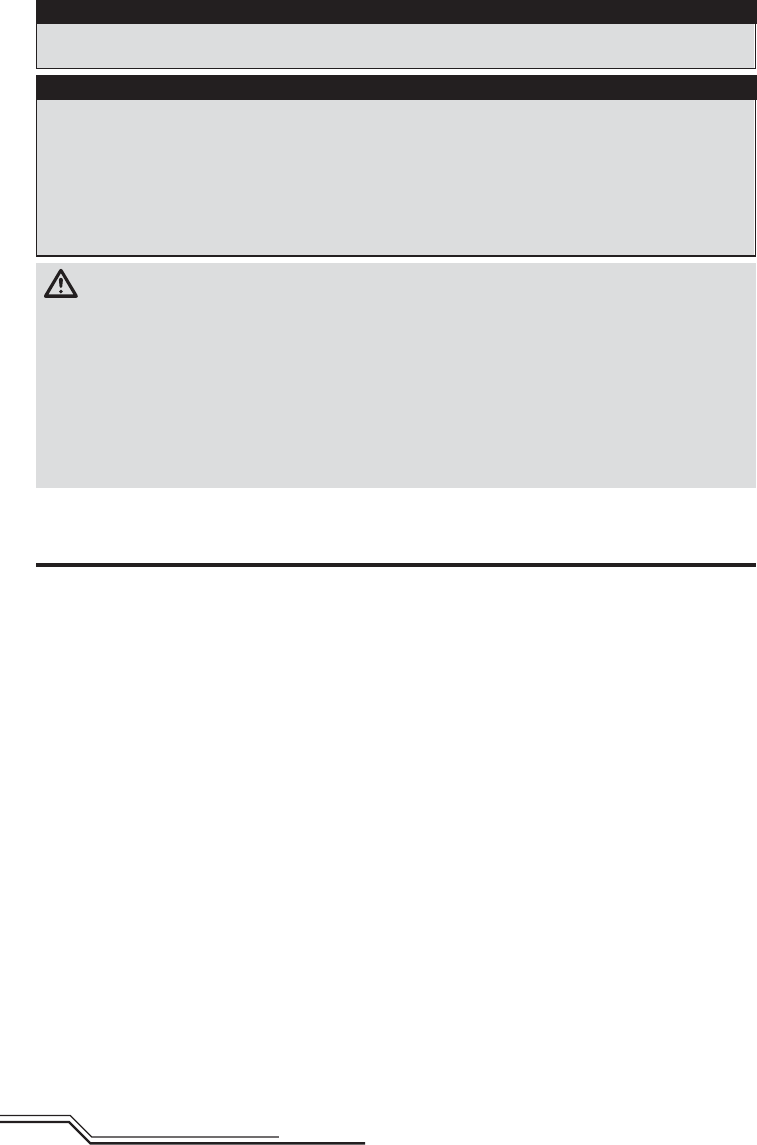
28
FR
AVERTISSEMENT: lisez la TOTALITÉ du manuel d’utilisation afi n de vous familiariser avec les caractéristiques
du produit avant de le faire fonctionner. Une utilisation incorrecte du produit peut entraîner sa détérioration,
ainsi que des risques de dégâts matériels, voire de blessures graves.
Ceci est un produit de loisirs sophistiqué. Il doit être manipulé avec prudence et bon sens et requiert des aptitudes
de base en mécanique. Toute utilisation irresponsable de ce produit ne respectant pas les principes de sécurité peut
provoquer des blessures, entraîner des dégâts matériels et endommager le produit. Ce produit n’est pas destiné à
être utilisé par des enfants sans la surveillance directe d’un adulte. N’essayez pas de démonter le produit, de l’utiliser
avec des composants incompatibles ou d’en améliorer les performances sans l’accord d’Horizon Hobby, LLC. Ce
manuel comporte des instructions relatives à la sécurité, au fonctionnement et à l’entretien. Il est capital de lire et de
respecter la totalité des instructions et avertissements du manuel avant l’assemblage, le réglage et l’utilisation, ceci
afi n de manipuler correctement l’appareil et d’éviter tout dégât matériel ou toute blessure grave.
Les termes suivants sont utilisés dans l’ensemble du manuel pour indiquer différents niveaux de danger lors
de l’utilisation de ce produit:
AVERTISSEMENT: procédures qui, si elles ne sont pas suivies correctement, peuvent entraîner des dégâts matériels
et des blessures graves OU engendrer une probabilité élevée de blessure superfi cielle.
ATTENTION: procédures qui, si elles ne sont pas suivies correctement, peuvent entraîner des dégâts matériels ET des
blessures graves.
REMARQUE: procédures qui, si elles ne sont pas suivies correctement, peuvent entraîner des dégâts matériels ET
éventuellement un faible risque de blessures.
• Maintenez toujours une distance de sécurité adéquate
dans toutes les directions autour de l’appareil pour évi-
ter tout risque de collision ou de blessure. Cet appareil
est contrôlé par signal radio et peut être soumis à des
interférences provenant de nombreuses sources hors de
votre contrôle. Les interférences peuvent entraîner une
perte de contrôle momentanée.
• Utilisez toujours l’appareil dans des espaces dégagés, à
l’écart des véhicules, de la circulation et des personnes.
• Respectez toujours scrupuleusement les instructions et
avertissements relatifs à l’appareil et à tous les équipe-
ments complémentaires optionnels utilisés (chargeurs,
packs de batteries rechargeables, etc.).
• Tenez les produits chimiques, les petites pièces et les
composants électriques hors de portée des enfants.
• Évitez d’exposer à l’eau tout équipement non conçu et
protégé à cet effet. L’humidité endommage les compo-
sants électroniques.
• Ne mettez jamais aucune pièce de l’appareil dans votre
bouche. Vous vous exposeriez à un risque de blessure
grave, voire mortelle.
• N’utilisez jamais l’appareil lorsque les batteries de
l’émetteur sont presque vides.
• Gardez toujours l’aéronef en vue et sous contrôle.
• Toujours baisser le manche des gaz lorsque les pales
touchent un objet ou le sol.
• Utilisez toujours des batteries complètement chargées.
• N’éteignez jamais l’émetteur lorsque l’aéronef est
soustension.
• Retirez toujours les batteries avant le démontage.
• Nettoyez systématiquement les pièces mobiles.
• Séchez systématiquement les pièces de l’appareil.
• Laissez toujours les pièces refroidir avant de les toucher.
• Retirez systématiquement les batteries après utilisation.
• N’utilisez jamais l’aéronef lorsque les câbles
sontendommagés.
• Ne touchez jamais les pièces mobiles.
REMARQUE
La totalité des instructions, garanties et autres documents est sujette à modifi cation à la seule discrétion d’Horizon Hobby, LLC.
Pour obtenir la documentation àjour, rendez-vous sur le site horizonhobby.com et cliquez sur l’onglet de support de ce produit.
Signifi cation de certains termes spécifi ques
Précautions et directives liées à la sécurité
14 ans et plus. Ceci n’est pas un jouet.
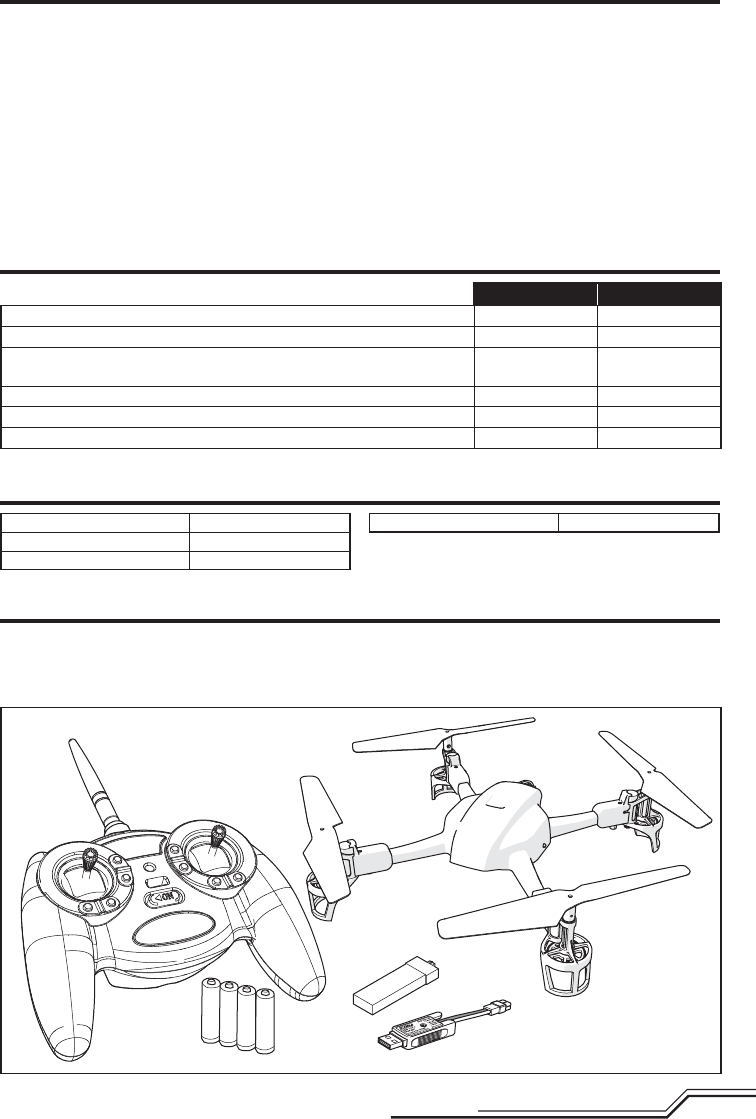
29 FR
Contenu de la boîte
Composants
Spécifi cations
• Blade® Ozone™
• Batterie Li-po 1S 3.7V 500mA 25c (Version RTF)
• Chargeur Li-Po USB 1S (Version RTF)
• Emetteur MLP4DSM (Version RTF)
• 4 piles AA (Version RTF)
Table des matières
Longueur 172mm
Hauteur 56mm
Diamètre de l’hélice 65mm
Poids de vol 75 g
RTF BLH9700 BNF BLH9750
Modèle – Blade® Ozone™ (BLH9700) Inclus Inclus
Moteurs – 8,53mm à balais, (BLH9709, CW), (BLH9710, CCW) Installés Installés
Electronique embarquée – Panneau de commande principale, SAFE®,
(BLH9706) Installés Installés
Batterie – 500mAh 1S 3,7V 25C Li-Po (EFLB5001S25UM) Inclus Non inclus
Chargeur – 1S USB Li-Po, 500mAh, UMX à courant fort (EFLC1013) Inclus Non inclus
Emetteur – MLP4DSM 2,4GHz, 4 canaux, BCMX2 (EFLH1064/B) Inclus Non inclus
Pour enregistrer votre produit en ligne, veuillez visiter
www.bladehelis.com
Composants...................................................................29
Spécifi cations ................................................................29
Contenu de la boîte ........................................................29
Préparation au premier vol .............................................30
Procédure de vol ............................................................30
Avertissements relatifs à la charge ................................30
Charge de la batterie .....................................................30
Installation des piles de l’émetteur (RTF) ........................31
Installation de la batterie de vol .....................................31
Affectation de l’émetteur et du récepteur .......................32
SAFE Technologie ..........................................................33
Contrôle de l’émetteur ...................................................33
Sélection du mode de vol ...............................................34
Signifi cations des DELs ..................................................34
Compréhension des commandes de vol de base ............35
Pilotage du Ozone ..........................................................36
Inspections après-vol et Maintenance ............................36
Guide de résolution des problèmes ................................36
Vue éclatée ....................................................................38
Liste des pièces détachées ............................................38
Garantie limitée .............................................................39
Coordonnées de Garantie et réparations ........................40
Information IC ................................................................40
Informations de conformité pour l’Union Européenne .....40
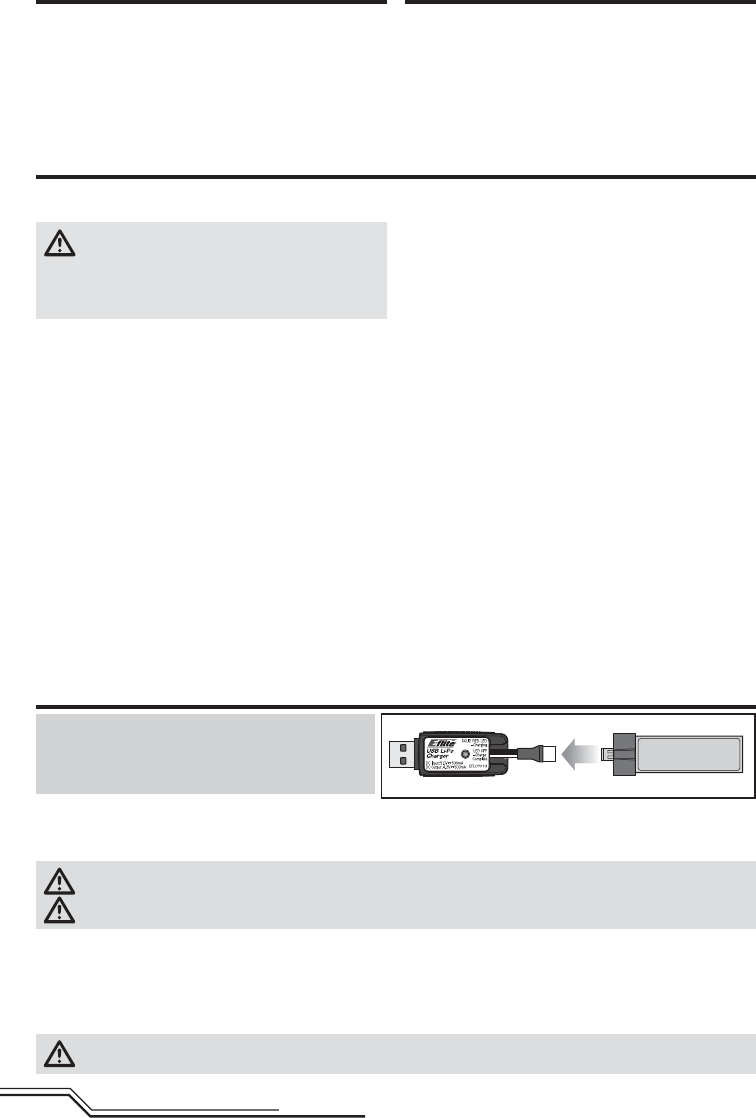
30
FR
Le chargeur (EFLC1013) livré avec votre avion a été conçu
pour charger la batterie Li-Po en toute sécurité.
ATTENTION: les instructions et avertissements
doivent être scrupuleusement suivis. Une manipu-
lation non appropriée des batteries Li-Po peut provoquer
un incendie, des blessures corporelles et/ou des dégâts
matériels.
• En manipulant, en chargeant ou en utilisant la batterie
Li-Po incluse, vous assumez tous les risques associés aux
batteries au lithium.
• Si la batterie commence à gonfl er ou à se dilater, cessez
immédiatement de l’utiliser. Si vous étiez en train de la
charger ou de la décharger, interrompez la procédure et
déconnectez-la. Continuer à utiliser, charger ou décharger
une batterie qui gonfl e ou se dilate peut provoquer un
incendie.
• Pour obtenir les meilleurs résultats, entreposez toujours la
batterie à température ambiante, dans un endroit sec.
• Lorsque vous transportez la batterie ou que vous la stockez
temporairement, la température doit toujours être comprise
entre 5 et 49 ºC.
• Ne stockez en aucun cas la batterie ou l’avion dans une
voiture ou à un endroit directement exposé à la lumière du
soleil. Laissée dans une voiture chaude, la batterie peut se
détériorer ou même prendre feu.
• Chargez toujours les batteries à distance de tout matériau
infl ammable.
• Faites toujours l’inspection de la batterie avant la charge,
et ne chargez jamais des batteries hors d’usage ou
endommagées.
• Déconnectez toujours la batterie après la charge, et laissez
le chargeur se refroidir entre les charges.
• Surveillez toujours en continu la température du pack de
batteries au cours de la charge.
• UTILISEZ EXCLUSIVEMENT UN CHARGEUR CONÇU
SPÉCIFIQUEMENT POUR CHARGER DES BATTERIES LI-PO.
Le fait de charger la batterie avec un chargeur non-com-
patible peut être à l’origine d’un incendie provoquant des
blessures corporelles et/ou des dégâts matériels.
• Ne déchargez jamais les cellules Li-Po en dessous de 3 V.
• Ne couvrez jamais les étiquettes d’avertissement avec des
bandes auto-agrippantes.
• Ne laissez jamais sans surveillance des batteries en cours
de charge.
• Ne chargez jamais les batteries sans respecter les niveaux
recommandés.
• N’essayez jamais de démonter ou de modifi er le chargeur.
• Ne laissez jamais des mineurs charger des packs de
batteries.
• Ne chargez jamais les batteries dans des endroits
extrêmement chauds ou froids (la plage de températures
recommandées se situe entre 5 et 49 °C) et ne les exposez
jamais à la lumière directe du soleil.
Avertissements relatifs à la charge
Charge de la batterie
REMARQUE: Chargez uniquement des batteries froides au
toucher et non endommagées. Contrôlez l'état de la bat-
terie pour être sûr qu'elle n'est pas endommagée, gonfl ée,
pliée ou percée.
1. Insérez le chargeur dans un port USB.
2. Connectez la batterie au câble du chargeur en respectant les polarités.
3. Toujours déconnecter la batterie du chargeur immédiatement après la fi n de charge.
ATTENTION : Utilisez uniquement des chargeurs spécifi quement conçus pour charger la batterie Li-Po incluse.
ATTENTION : Ne jamais dépasser l'intensité de charge recommandée.
Indications de la DEL
Quand la connexion est réussie, la DEL rouge du chargeur s'éclaire fi xement, indiquant que la charge a débuté. Il faudra environ
60 minutes pour charger entièrement une batterie 500mA déchargée. La DEL s'éteint quand la charge est terminée.
CHARGE: (Rouge fi xe)
CHARGE MAX: (OFF)
ATTENTION: Débranchez immédiatement la batterie une fois que la charge est terminée. Ne jamais laisser une batterie
connectée au chargeur.
Préparation au premier vol
• Sortez tous les éléments de la boîte et inspectez-les
• Mettez la batterie en charge
• Installez la batterie totalement chargée dans le quadcoptère
• Programmez votre émetteur (Version BNF)
• Affectez votre émetteur (Version BNF)
• Familiarisez-vous avec les commandes
• Choisissez un endroit approprié pour le vol
Procédure de vol
❏Toujours mettre l’émetteur sous tension en premier
❏ Branchez la batterie à la prise du module
❏ Patientez durant l’initialisation du module
❏Effectuez votre vol
❏Faites atterrir le modèle
❏ Débranchez la batterie du module
❏Toujours mettre l’émetteur hors tension en dernier
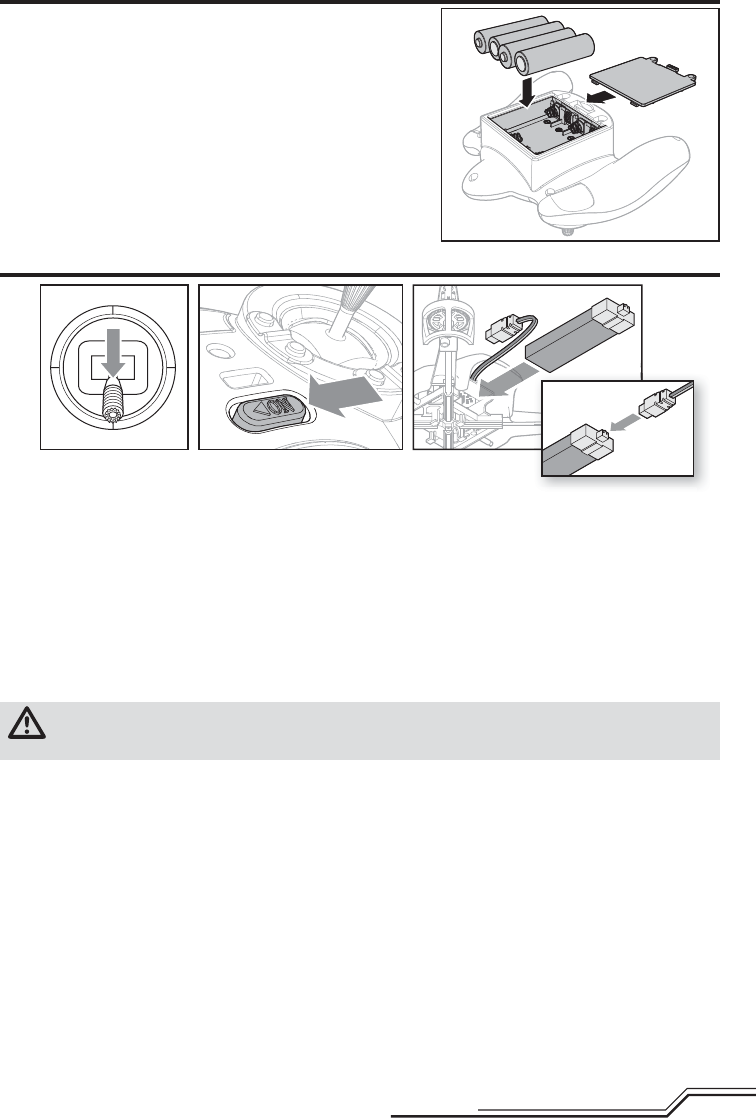
31 FR
Installation des piles de l’émetteur (RTF)
Remplacez les piles quand la DEL de l'émetteur clignote accompagnée
par des bips.
1. Mettez les gaz à la position la plus basse. Pour un appareil BNF, activez le Throttle Hold (Maintien des gaz) si votre
émetteur en est équipé.
2. Mettez l’émetteur en marche.
3. Installez la batterie en la glissant dans la fente de montage de batterie en-dessous de l’unité de commande.
Glissez la batterie dans les fentes avec l’étiquette vers le haut, afi n que la clé de batterie moulée dans le capuchon
d’extrémité de la batterie touche la clé sur la fente de batterie.
4. Raccordez le câble de la batterie à l’unité de commande.
5. Placez le quadricoptère sur une surface plane et laissez l’appareil immobile jusqu’à ce que la DEL de l’unité de
commande indique un des modes de vol suivants:
Bleu fi xe: Stability mode, (mode Stabilité) commutateur en position 1
Rouge fi xe: Agility mode (mode Agilité), commutateur en position 2
ATTENTION: Toujours débrancher la batterie du modèle quand vous ne l’utilisez pas, afin d’éviter une décharge
trop importante. Des batteries déchargées à un voltage inférieur à celui recommandé, seront endommagées,
elles perdront en performance et pourront entraîner un risque d’incendie durant la charge.
Installation de la batterie de vol
12
d (Maintien des gaz) si votre
3
4
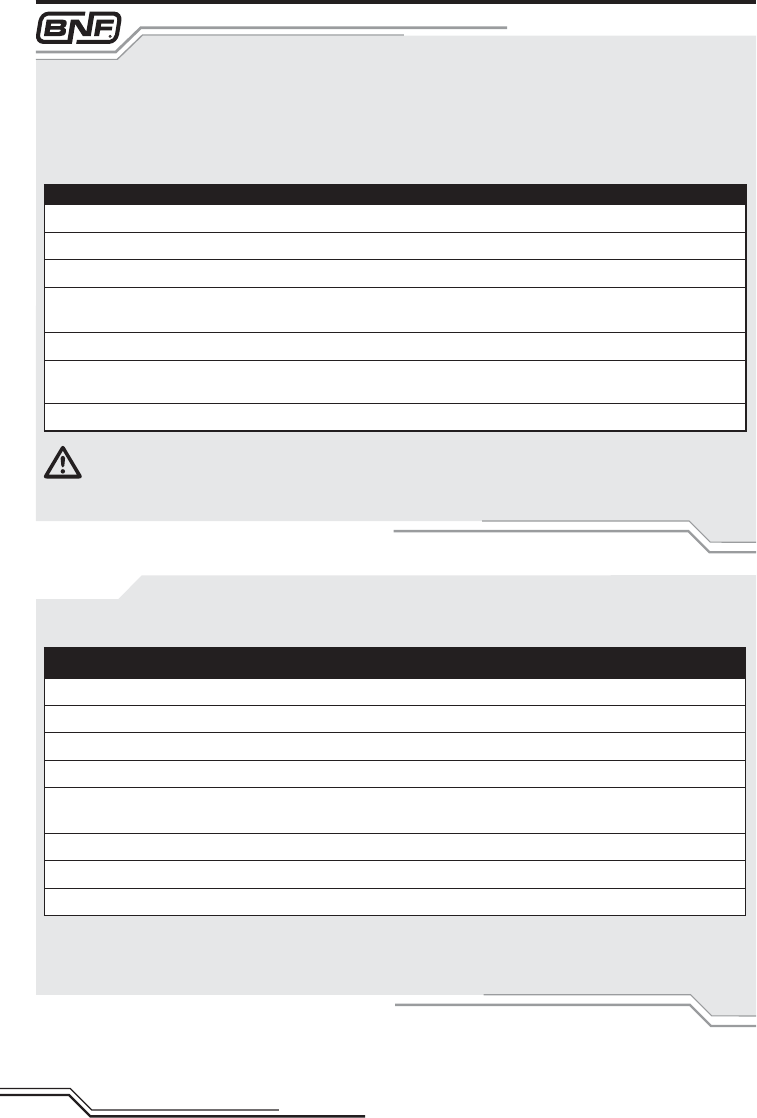
32
FR
ATTENTION : Si vous utilisez un émetteur Futaba avec un module Spektrum DSM2/DSMX, il vous faudra
inverser la voie de la manette des gaz et effectuer à nouveau l’affectation. Référez-vous au manuel d‘utilisation
du module Spektrum pour les instructions d’affectation et de sécurité failsafe. Référez-vous au manuel d’utilisation de
l’émetteur Futaba pour les instructions d’inversion de voie de la manette des gaz.
Procedure d’a ection de l’émetteur MLP4DSM
1. Débranchez la batterie de vol du quadricoptère.
2. Centrez tous les trims sur votre émetteur.
3. Éteignez l’émetteur et mettez la manette des gaz en position basse/point mort (off).
4. Raccordez la batterie de vol dans le quadricoptère. La DEL sur l’unité de commande clignote après 5 secondes.
5. Lorsque la lumière bleue clignote, maintenez appuyé le levier de gauche* pendant que vous allumez l’émetteur
(vous entendrez un déclic).
6. Relâchez le levier de gauche. L’émetteur produira un bip sonore et la DEL d’alimentation clignotera.
7. Le quadricoptère est affecté lorsque toutes les DEL sur l’appareil se fi xent.
8. Débranchez la batterie de vol et éteignez l’émetteur.
* La gâchette peut également être utilisée pour effectuer l'affectation.
Si vous rencontrez des diffi cultés, référez-vous au guide de dépannage. Si nécessaire, contactez votre revendeur ou le
service technique Horizon Hobby. Pour consulter la liste des émetteurs compatibles, veuillez visiter www.bindnfl y.com.
RTF
L'émetteur de la version RTF est livré déjà affecté au modèle. Si vous devez refaire l'affectation, suivez les
instructions ci-dessous.
A ectation de l’émetteur et du récepteur
Si vous utilisez un émetteur informatique, réglez le type d’appareil sur le mode «Acro» ou «Avion». Dans le menu de
saisie de canal, réglez le canal6 (Aux1) sur un commutateur momentané comme le bouton d’affectation (I) et le canal5
(Gear) sur un commutateur à 3positions (commutateur B). Dans le menu de paramétrage des servos, inversez le canal 6
(Aux1).
Affectez le quadricoptère à votre émetteur en suivant les consignes d’affectation de l’émetteur et du récepteur ci-
dessous.
Procédure d’a ectation
1. Débranchez la batterie de vol du quadricoptère.
2. Centrez tous les trims sur votre émetteur.
3. Éteignez l’émetteur et abaissez entièrement les gaz.
4. Raccordez la batterie de vol dans le quadricoptère. Toutes les DEL sur l’appareil clignotent rapidement, ce qui
indique que l’appareil est en mode d’affectation.
5. Mettez l’émetteur en mode d’affectation pendant que vous l’allumez.
6. Relâchez le bouton/commutateur d’affectation après 2-3 secondes. Le quadricoptère est affecté lorsque toutes
les DEL sur l’appareil se fi xent.
7. Débranchez la batterie de vol et éteignez l’émetteur.
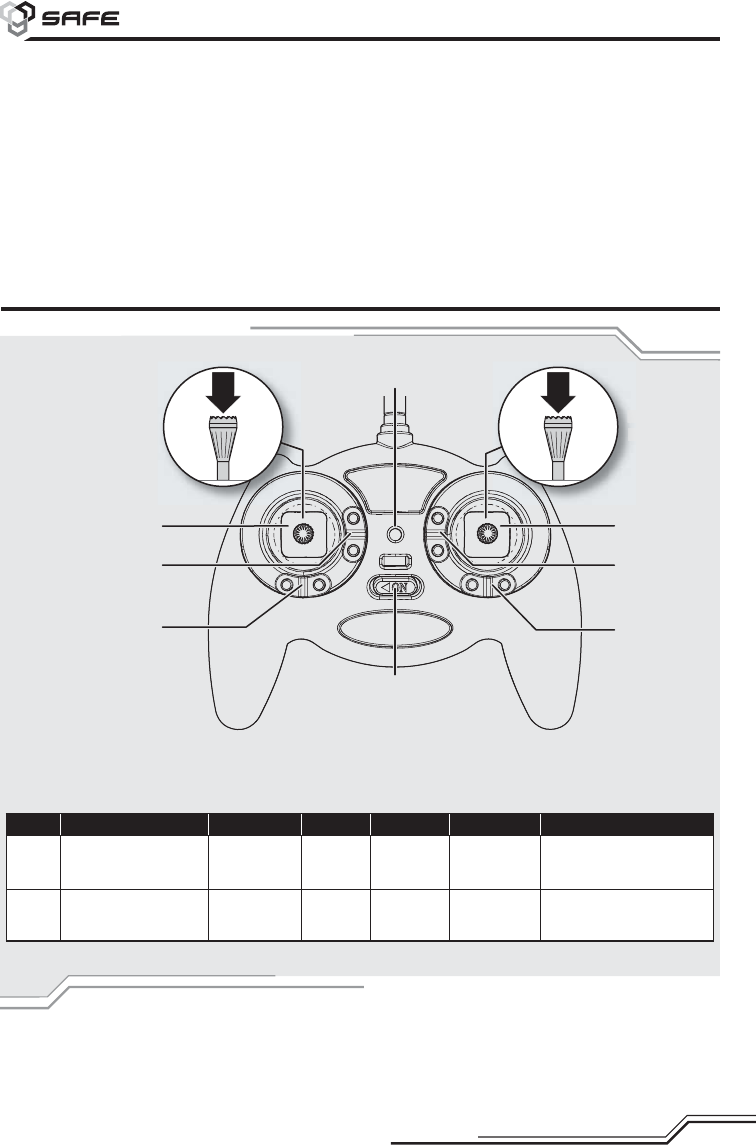
33 FR
RTF
Contrôle de l’émetteur
La technologie révolutionnaire SAFE (Système d'entraînement assisté par capteurs) utilise la combinaison de capteurs sur
différents axes et un logiciel permettant au modèle de connaître sa position par rapport à l'horizon. Cette reconnaissance de
l'espace est utilisée pour générer un domaine de vol sécurisé en limitant les angles afi n de piloter en sécurité. Au-delà de la
stabilité, cette protection offre de multiples modes au choix du pilote pour développer son niveau de pilotage avec un degré
élevé de sécurité tout en conservant toujours les sensations et la réponse.
La technologie SAFE apporte:
• Une protection du domaine de vol qui s'active avec un simple basculement d'un interrupteur.
• Des modes différents pour adapter instantanément la technologie SAFE à votre niveau de pilotage.
Par dessus tout, la technologie SAFE bien que très sophistiquée, ne nécessite aucune opération pour en profi ter.
Chaque appareil équipé de la technologie SAFE est livré prêt à l'emploi et est optimisé pour offrir la meilleure expérience de
vol possible. FlySAFERC.com
Technologie
®
ABCDE F
Mode
1
Aileron (Gauche/Droit)
Gaz (Haut/Bas) Trim des gaz Trim
d’aileron
Trim de
gouvernail
Trim
d’ascenseur
Gouvernail (Gauche/Droit)
Ascenseur (Haut/Bas)
Mode
2
Aileron (Gauche/Droit)
Ascenseur (Haut/Bas)
Trim
d’ascenseur
Trim
d’aileron
Trim de
gouvernail Trim des gaz Gouvernail (Gauche/Droit)
Gaz (Haut/Bas)
Sélection du
mode de vol
D
E
F
DEL d’alimentation
C
B
A
Commutateur ON/OFF
Lorsqu’ils sont enfoncés, les boutons de trim font un bruit qui augmente ou diminue en intensité àchaque
pression. La position intermédiaire ou neutre du trim utilise une tonalité de milieu de gamme. Une série de bips
sonores indique la fi n de la plage de contrôle.
Sé
m
• Affectation
• Appui long:
Activation/
Désactivation
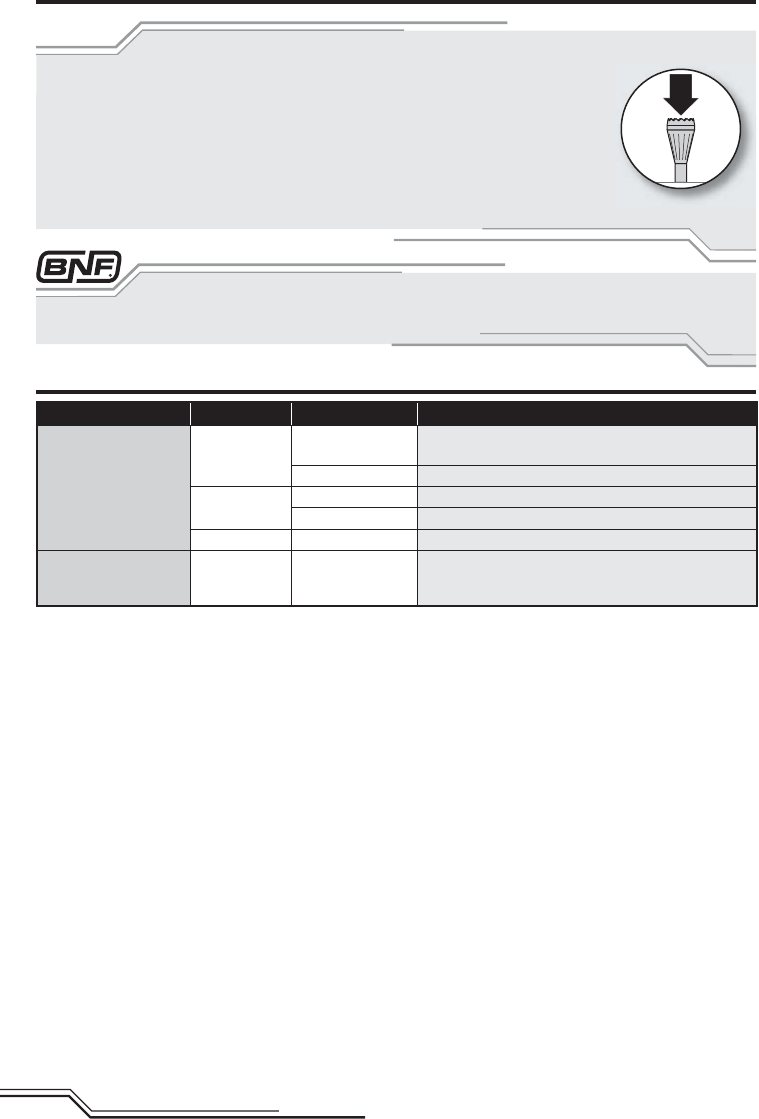
34
FR
RTF
Changez de modes de vol en appuyant sur le levier de droite. Vérifi ez que le commutateur de
mode de vol est à la position souhaitée avant le vol.
• En mode Stabilité (position 1 du commutateur), les commandes fournissent un angle
d'inclinaison minimal. Ce mode est indiqué par les LED de contrôle de vol sur le quadcopter
en bleu fi xe.
• Le mode d'agilité (position de l'interrupteur 2) est indiqué par les LED de contrôle de vol du
quadcopter rouge fi xe.
Si vous avez acheté un quadricoptère BNF Ozone™, le commutateur de canal 5 sur votre émetteur sélectionnera les
modes de vol.
Sélection du mode de vol
Signifi cations des DELs
Équipement Couleur DEL Statut DEL Opération
Quadricoptère:
LED de contrôle de
vol sur le tableau de
commande
Bleue Fixe Stability mode (Mode de stabilité), commutateur en
position 1
Clignotement Perte de RF / Émetteur éteint (OFF)
Rouge Fixe Agility mode (mode Agilité), commutateur en position 2
Clignotement Batterie faible
Blanc Clignotement Désactivé, Prêt
Quadricoptère:
DEL de nacelle de
moteur externe
Blanc (Avant)
Rouge (Arrière) Clignotement lent En lien avec l’accélération
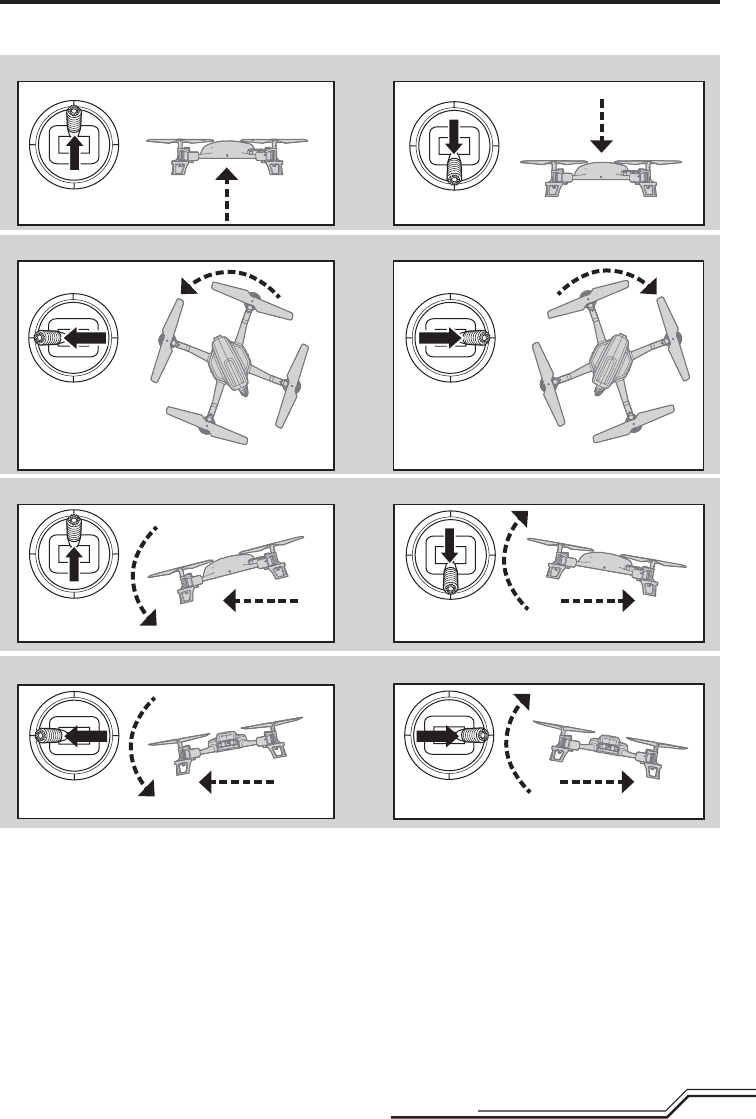
35 FR
Ascenseur
Vers l’avant
Ascenseur
vers la bas
Ascenseur
vers la haut Vers l’arrière
Gouvernail
Gouvernail
gauche
Gouvernail
droite
Compréhension des commandes de vol de base
Si vous n’avez pas encore bien assimilé les commandes de votre quadcoptère, prenez quelques minutes pour vous
familiariser avec elles avant de tenter votre premier vol.
Accélérateur
Ralentir
Accélère
Vue latérale gauche
Vue latérale gauche
Vue latérale gaucheVue latérale gauche
Vue latérale gauche
Descendre
Monter
Aileron
Aileron à gauche Gauche Aileron à droite Droite
Le nez tourne vers la droiteLe nez tourne vers la gauche
Vue arrière Vue arrière
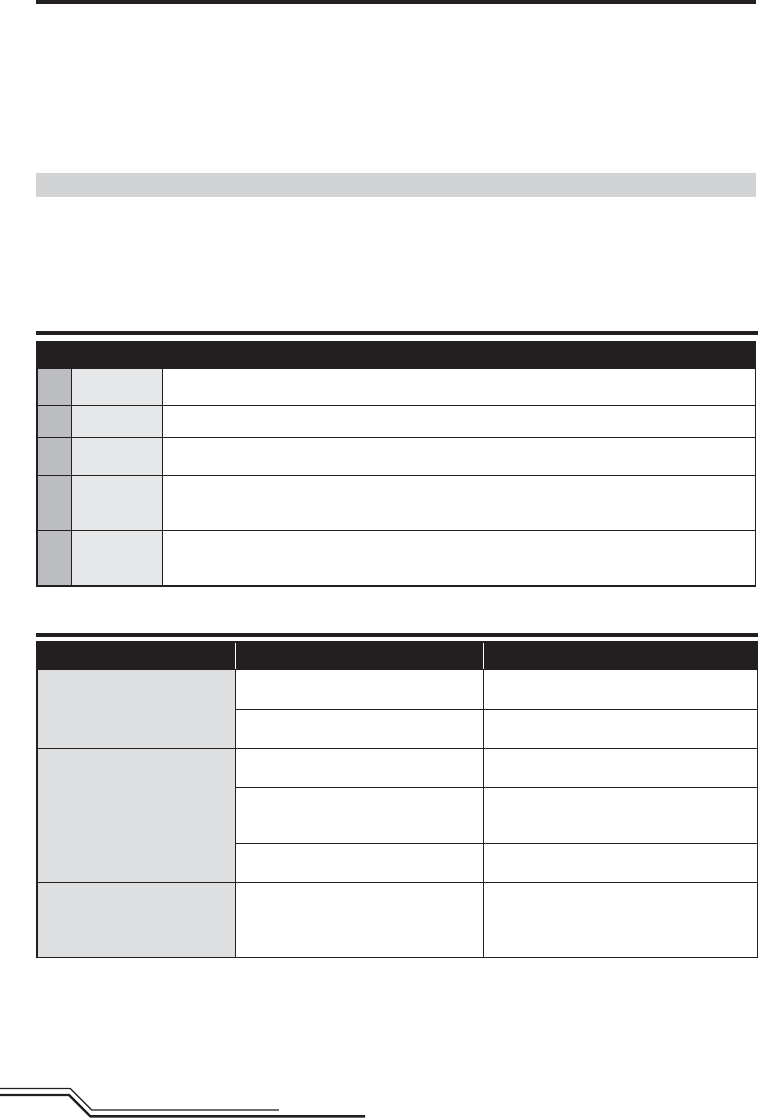
36
FR
Inspections après-vol et Maintenance
Guide de résolution des problèmes
Problème Cause possible Solution
Le quadcoptère répond de
façon incorrecte ou nécessite
l’ajout de trim pour arrêter le
mouvement.
L'appareil n'a pas été initialisé sur une
surface à niveau. Déconnectez la batterie, replacez les trims au
neutre et réinitialisez le quadcoptère.
La batterie n'est pas correctement placée
dans son support. Placez la batterie de façon à obtenir l'équilibre
au centre de son châssis.
Le quadcoptère ne répond pas
aux gaz.
Le manche des gaz et/ou le trim est égale-
ment trop haut. Baissez le manche des gaz et placez le trim à la
valeur la plus basse.
Le quadcoptère à été déplacé durant
l’initialisation.
Débranchez, puis rebranchez la batterie afin
d’initialiser le quadcoptère en prenant soin de
ne pas le déplacer durant cette opération.
La voie des gaz est inversée. Débranchez la batterie, inversez la voie des gaz,
puis rebranchez la batterie.
Le quadcoptère ne fonctionne
pas et dégage une odeur de
brûlé après avoir branché la
batterie.
La polarité de la batterie n’a pas été
respectée. Remplacez le module 5 en 1. Branchez la batte-
rie en respectant la polarité.
Décollage
Augmentez les gaz jusqu'à atteindre une altitude de 60cm et ajustez les trims en cas de dérive du modèle. Une fois que
les trims sont correctement réglés vous pouvez commencer à piloter le modèle.
La batterie incluse permet d’effectuer des temps de vol de durées comprises entre 5 et 10 minutes.
Coupure basse tension (LVC)
Le LVC diminue l'alimentation des moteurs quand la tension de la batterie diminue. Quand vous remarquez une
perte de puissance et que les DELs bleue et rouge du module 5 en 1 s'allument fi xement, veuillez poser le modèle
immédiatement et recharger la batterie. Le LVC n'empêche pas la décharge de la batterie durant le stockage.
REMARQUE: Les vols répétés jusqu'à l'enclenchement du LVC endommageront la batterie.
Atterrissage
Pour effectuer l'atterrissage, baissez progressivement le manche des gaz quand vous êtes en stationnaire à faible
altitude. Déconnectez et retirez la batterie de l'appareil après utilisation afi n d'éviter une décharge trop importante de la
batterie. Chargez complètement la batterie avant de la stocker. Contrôlez régulièrement la tension de la batterie durant
le stockage, la tension ne doit jamais descendre sous 3V par élément.
Pilotage du Ozone™
√
Nettoyage Assurez-vous que la batterie n'est pas connectée avant d'entreprendre le nettoyage. Al'aide d'une
brosse douce ou d'un chiffon sec non-pelucheux, enlevez la poussière et les débris.
Moteurs Remplacez le moteur quand le modèle devient instable ou qu'il vire lors de prise d'altitude.
Câblage Assurez-vous que les câbles ne bloquent pas de pièces en mouvement. Remplacez tout câble
endommagé et tout connecteur devenu lâche.
Pièces
servant àla
fi xation
Assurez-vous de l'absence de toute vis, bride ou connecteur desserré. Ne pas serrer excessivement
des vis métalliques dans des pièces en plastique. Serrez les vis de façon àce que les pièces soient
parfaitement jointives, et ne donner ensuite qu'1/8ème de tour supplémentaire.
Rotors
Vérifi ez l'absence de tout dommage au niveau des pales de rotor et des pièces en mouvement
àvitesse élevée. Citons, au nombre des dommages que peuvent présenter ces pièces: fentes,
criques, bavures ou rayures. Remplacez les pièces endommagées avant d'effectuer un vol.
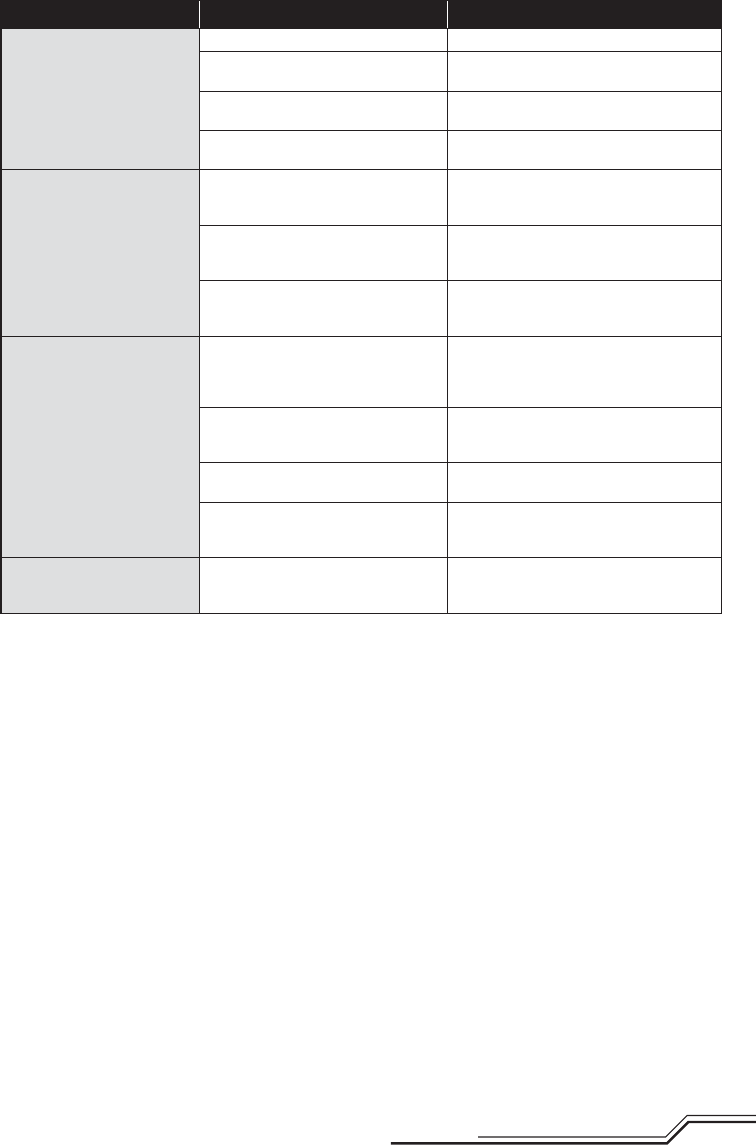
37 FR
Problème Cause possible Solution
Le quadcoptère a une autono-
mie et une puissance réduite.
La batterie n’est pas totalement chargée. Rechargez totalement la batterie.
Le chargeur n’est pas correctement
alimenté. Utilisez une autre prise USB pour alimenter le
chargeur.
La batterie est endommagée. Remplacez la batterie en respectant les carac-
téristiques.
La température est peut-être basse. Vérifiez que la batterie est à température
ambiante (20°) avant de l’utiliser.
La DEL du module clignote rapi-
dement et l’appareil ne répond
pas aux commandes.
(durant l’affectation).
L’émetteur est trop près de l’appareil
durant l’affectation.
Mettez l’émetteur hors tension. Eloignez-le de
l’appareil. Débranchez puis rebranchez la bat-
terie. Suivez les instructions d’affectation.
Le bouton ou l'interrupteur d'affectation
n'a pas été maintenu durant la mise sous
tension de l'émetteur.
Mettez l'émetteur hors tension et répétez le
processus d'affectation.
L'appareil ou l'émetteur se trouve trop
proche d'un grand objet métallique, d'un
réseau sans fi l ou d'un autre émetteur.
Placez l'avion et l'émetteur à un autre emplace-
ment et retentez l'affectation.
La DEL du module clignote
rapidement et le quadcoptère
ne répond pas aux commandes
(après l’affectation).
Moins de 5 secondes se sont écoulées
entre l’allumage de l’émetteur et la
connexion de la batterie de vol sur le
quadcoptère.
Laissez l’émetteur sous tension. Débranchez
puis rebranchez la batterie du quadcoptère.
Le quadcoptère est affecté à une mémoire
de modèle différente (radios ModelMatch
uniquement).
Sélectionnez la mémoire de modèle correcte
sur l’emetteur. Débranchez puis rebranchez la
batterie du quadcoptère.
Charge des batteries de l’émetteur trop
faible. Remplacez ou chargez les batteries
de l’emetteur.
L'appareil ou l'émetteur se trouve trop
proche d'un grand objet métallique, d'un
réseau sans fi l ou d'un autre émetteur.
Placez l'avion et l'émetteur à un autre emplace-
ment et retentez la connexion.
Crash immédiatement après
avoir décollé.
Les hélice ne sont pas correctement
placées ou vous n’avez pas sélectionné la
bonne configuration. Effectuez les modifications nécessaires.
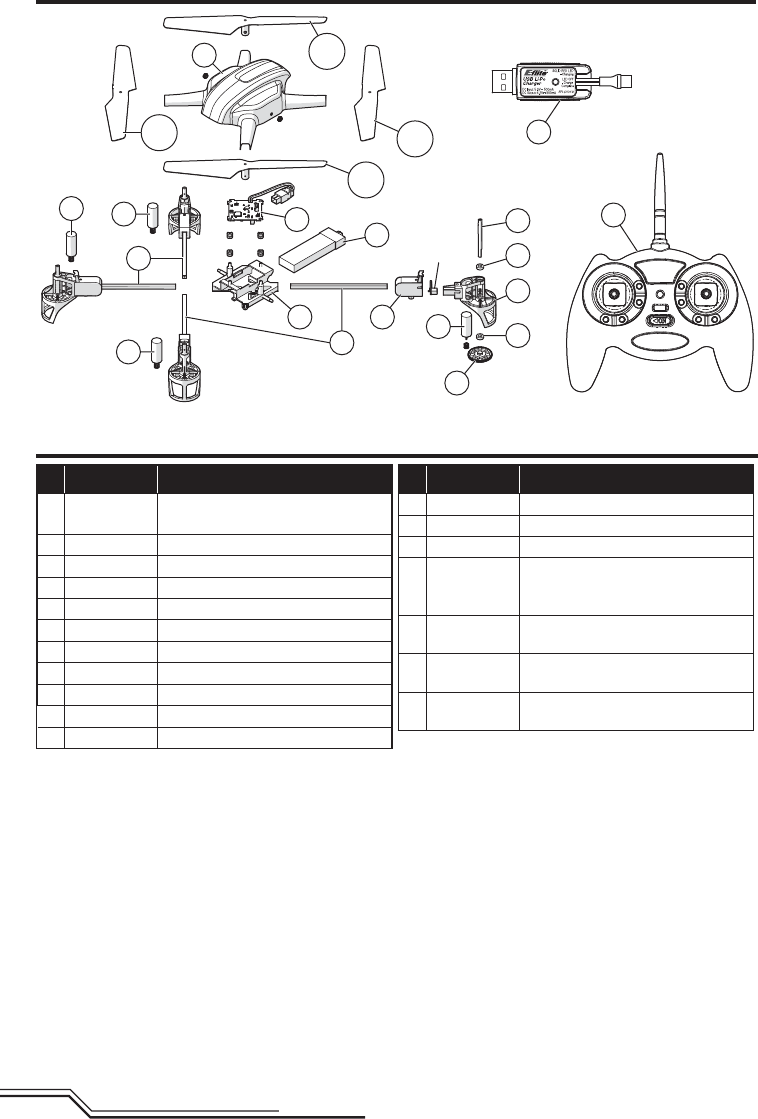
38
FR
Vue éclatée
Liste des pièces détachées
Numéro Description
1 BLH9706 Tableau de commande principal:
Ozone
2 BLH9707 Ensemble de fl èche gauche (2)
3 BLH9708 Ensemble de fl èche droite (2)
4 BLH9710 Moteur antihoraire
5 BLH9709 Moteur horaire
6 BLH9702 Cadre intérieur
7 BLH9704 Verrière
8 BLH9703 Ensemble complet d'hélices (4)
9 BLH9705 Cache moteur (semi-transp)
10 BLH9712 Patins d'atterrissage
11 BLH7521 Hélice, rotation CCW, noir (2))
Numéro Description
12 BLH7520 Hélice, rotation CW, noire, (2)
13 BLH7513 Arbre de l’hélice MQX, carbone
14 BLH3506 Rouage principal: BMSR, mCP S/X
15 BLH3515
Roulement d’arbre principal,
3x6x2mm (2):
BMCX/2/MSR, MH-35, mCP X
16 EFLB5001S25UM 3,7V 500mAh 1S 25C Li-Po,
connecteur UMX à courant fort
17 EFLC1013 Chargeur Li-Po USB 1S, 500 mAh,
connecteur UMX à courant fort
18 EFLH1064/B Émetteur Blade MLP4DSM 4canaux,
2,4 GHz: BMCX2, 120SR
14
15
15
LED
13
17
18
10
8
12 8
12
8
11
8
11
1
6
2
3
9
16
4
4
5
5
7

39 FR
Garantie limitée
Durée de la garantie
Garantie exclusive - Horizon Hobby, LLC (Horizon) garantit
que le Produit acheté (le « Produit ») sera exempt de défauts
matériels et de fabrication à sa date d’achat par l’Acheteur. La
durée de garantie correspond aux dispositions légales du pays
dans lequel le produit a été acquis. La durée de garantie est
de 6 mois et la durée d’obligation de garantie de 18 mois à
l’expiration de la période de garantie.
Limitations de la garantie
(a) La garantie est donnée à l’acheteur initial («Acheteur») et
n’est pas transférable. Le recours de l’acheteur consiste
en la réparation ou en l‘échange dans le cadre de cette
garantie. La garantie s’applique uniquement aux produits
achetés chez un revendeur Horizon agréé. Les ventes faites
à des tiers ne sont pas couvertes par cette garantie. Les
revendications en garantie seront acceptées sur fourniture
d’une preuve d’achat valide uniquement. Horizon se réserve
le droit de modifier les dispositions de la présente garantie
sans avis préalable et révoque alors les dispositions de
garantie existantes.
(b) Horizon n’endosse aucune garantie quant à la vendabilité
du produit ou aux capacités et à la forme physique de
l’utilisateur pour une utilisation donnée du produit. Il est de la
seule responsabilité de l’acheteur de vérifier si le produit cor-
respond à ses capacités et à l’utilisation prévue.
(c) Recours de l’acheteur – Il est de la seule discrétion d‘Horizon
de déterminer si un produit présentant un cas de garantie
sera réparé ou échangé. Ce sont là les recours exclusifs de
l’acheteur lorsqu’un défaut est constaté.
Horizon se réserve la possibilité de vérifier tous les éléments
utilisés et susceptibles d’être intégrés dans le cas de garantie.
La décision de réparer ou de remplacer le produit est du seul
ressort d’Horizon. La garantie exclut les défauts esthétiques
ou les défauts provoqués par des cas de force majeure, une
manipulation incorrecte du produit, une utilisation incorrecte
ou commerciale de ce dernier ou encore des modifications de
quelque nature qu’elles soient.
La garantie ne couvre pas les dégâts résultant d’un montage
ou d’une manipulation erronés, d’accidents ou encore du fonc-
tionnement ainsi que des tentatives d’entretien ou de réparation
non effectuées par Horizon. Les retours effectués par le fait de
l’acheteur directement à Horizon ou à l’une de ses représenta-
tions nationales requièrent une confirmation écrite.
Limitation des dégâts
Horizon ne saurait être tenu pour responsable de dommages
conséquents directs ou indirects, de pertes de revenus ou de
pertes commerciales, liés de quelque manière que ce soit au
produit et ce, indépendamment du fait qu’un recours puisse être
formulé en relation avec un contrat, la garantie ou l’obligation
de garantie. Par ailleurs, Horizon n’acceptera pas de recours
issus d’un cas de garantie lorsque ces recours dépassent la
valeur unitaire du produit. Horizon n’exerce aucune influence
sur le montage, l’utilisation ou la maintenance du produit ou sur
d’éventuelles combinaisons de produits choisies par l’acheteur.
Horizon ne prend en compte aucune garantie et n‘accepte
aucun recours pour les blessures ou les dommages pouvant en
résulter. En utilisant et en montant le produit, l’acheteur accepte
sans restriction ni réserve toutes les dispositions relatives à la
garantie figurant dans le présent document.
Si vous n’êtes pas prêt, en tant qu’acheteur, à accepter ces
dispositions en relation avec l’utilisation du produit, nous vous
demandons de restituer au vendeur le produit complet, non
utilisé et dans son emballage d’origine.
Indications relatives à la sécurité
Ceci est un produit de loisirs perfectionné et non un jouet. Il doit
être utilisé avec précaution et bon sens et nécessite quelques
aptitudes mécaniques ainsi que mentales. L’incapacité à utiliser
le produit de manière sûre et raisonnable peut provoquer des
blessures et des dégâts matériels conséquents. Ce produit n’est
pas destiné à être utilisé par des enfants sans la surveillance
par un tuteur. La notice d’utilisation contient des indications
relatives à la sécurité ainsi que des indications concernant la
maintenance et le fonctionnement du produit. Il est absolument
indispensable de lire et de comprendre ces indications avant
la première mise en service. C’est uniquement ainsi qu’il sera
possible d’éviter une manipulation erronée et des accidents
entraînant des blessures et des dégâts.
Questions, assistance et réparations
Votre revendeur spécialisé local et le point de vente ne peuvent
effectuer une estimation d’éligibilité à l’application de la garantie
sans avoir consulté Horizon. Cela vaut également pour les répa-
rations sous garantie. Vous voudrez bien, dans un tel cas, con-
tacter le revendeur qui conviendra avec Horizon d’une décision
appropriée, destinée à vous aider le plus rapidement possible.
Maintenance et réparation
Si votre produit doit faire l’objet d’une maintenance ou d‘une
réparation, adressez-vous soit à votre revendeur spécialisé,
soit directement à Horizon. Emballez le produit soigneuse-
ment. Veuillez noter que le carton d‘emballage d’origine ne
suffit pas, en règle générale, à protéger le produit des dégâts
pouvant survenir pendant le transport. Faites appel à un service
de messagerie proposant une fonction de suivi et une assur-
ance, puisque Horizon ne prend aucune responsabilité pour
l’expédition du produit jusqu’à sa réception acceptée. Veuillez
joindre une preuve d’achat, une description détaillée des défauts
ainsi qu’une liste de tous les éléments distincts envoyés. Nous
avons de plus besoin d’une adresse complète, d’un numéro
de téléphone (pour demander des renseignements) et d’une
adresse de courriel.
Garantie et réparations
Les demandes en garantie seront uniquement traitées en
présence d’une preuve d’achat originale émanant d’un reven-
deur spécialisé agréé, sur laquelle figurent le nom de l’acheteur
ainsi que la date d’achat. Si le cas de garantie est confirmé,
le produit sera réparé. Cette décision relève uniquement de
Horizon Hobby.
Réparations payantes
En cas de réparation payante, nous établissons un devis que
nous transmettons à votre revendeur. La réparation sera seule-
ment effectuée après que nous ayons reçu la confirmation du
revendeur. Le prix de la réparation devra être acquitté au reven-
deur. Pour les réparations payantes, nous facturons au minimum
30 minutes de travail en atelier ainsi que les frais de réexpédi-
tion. En l’absence d’un accord pour la réparation dans un délai
de 90 jours, nous nous réservons la possibilité de détruire le
produit ou de l’utiliser autrement.
ATTENTION : nous n’effectuons de réparations payantes
que pour les composants électroniques et les moteurs.
Les réparations touchant à la mécanique, en particulier
celles des hélicoptères et des voitures radiocomman-
dées, sont extrêmement coûteuses et doivent par con-
séquent être effectuées par l’acheteur lui-même.
5/2015
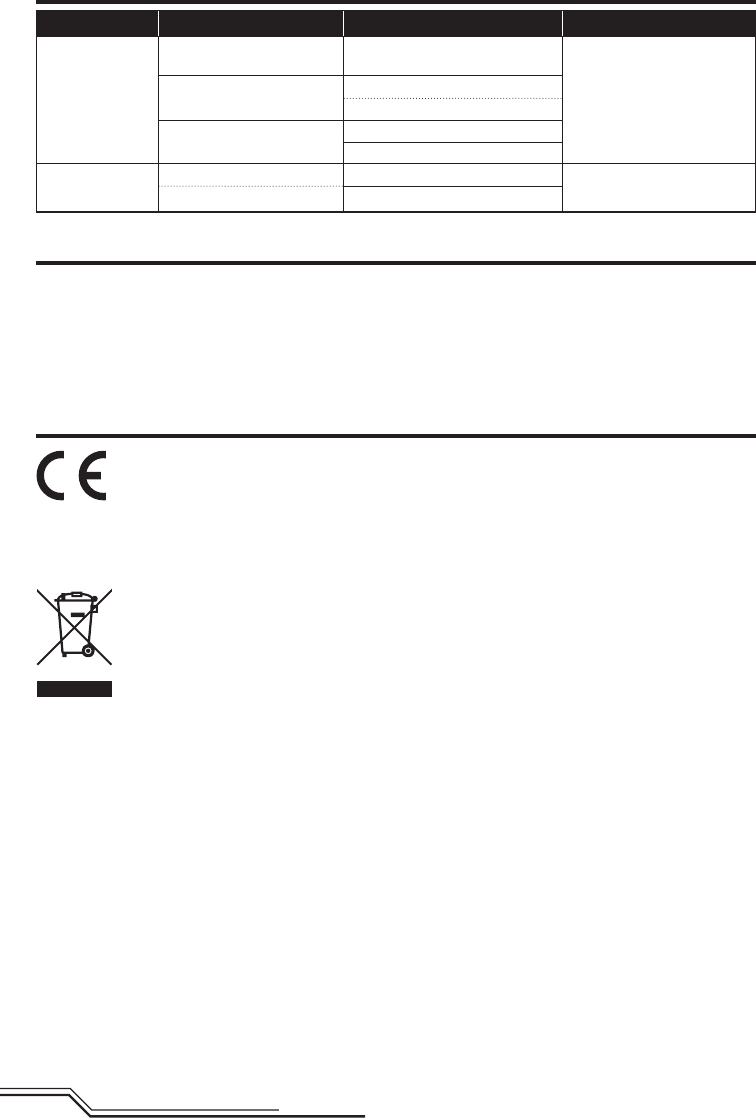
40
FR
Coordonnées de Garantie et réparations
Information IC
IC (Émetteur): 6175A-BRWDXMT
IC (Quadcopter): 6157A-BLH9706
Le présent appareil est conforme aux CNR d’Industrie Canada applicables aux appareils radio exempts de licence.
L’exploitation est autorisée aux deux conditions suivantes : (1) l’appareil ne doit pas produire de brouillage, et (2)
l’utilisateur de l’appareil doit accepter tout brouillage radioélectrique subi, même si le brouillage est susceptible d’en
compromettre le fonctionnement.
Pays d’achat Horizon Hobby Numéro de téléphone/E-mail Adresse
Amérique du Nord
Horizon Service Center
(Repairs and Repair Requests)
servicecenter.horizonhobby.com/
RequestForm/
1608 Interstate Drive
Champaign, Illinois, 61822 USA
Horizon Product Support
(Product Technical Assistance)
productsupport@horizonhobby.com
877-504-0233
Sales websales@horizonhobby.com
800-338-4639
Union européenne Horizon Technischer Service service@horizonhobby.eu Hanskampring 9
D 22885 Barsbüttel, Germany
Sales: Horizon Hobby GmbH +49 (0) 4121 2655 100
Déclaration de conformité de l’union européenne :
BLH9700: Horizon Hobby, LLC déclare par la présente que ce produit est en conformité avec les exigences
essentielles et les autres dispositions des Directives RED et CEM.
BLH9750: Horizon Hobby, LLC déclare par la présente que ce produit est en conformité avec les exigences essentielles et les
autres dispositions de la Directive RED.
Une copie de la déclaration de conformité Européenne est disponible à : http://www.horizonhobby.com/content/support-render-
compliance.
Informations de conformité pour l’Union Européenne
Instructions relatives à l’élimination des D3E pour les utilisateurs résidant dans l’Union Européenne
Ce produit ne doit pas être éliminé avec d’autres déchets. Il est de la responsabilité de l’utilisateur d’éliminer
les équipements rebutés en les remettant à un point de collecte désigné en vue du recyclage des déchets
d’équipements électriques et électroniques. La collecte et le recyclage séparés de vos équipements usagés
au moment de leur mise au rebut aideront à préserver les ressources naturelles et à assurer le recyclage des
déchets de manière à protéger la santé humaine et l’environnement. Pour plus d’informations sur les points de
collecte de vos équipements usagés en vue du recyclage, veuillez contacter votre mairie, votre service de collecte des ordures
ménagères ou le magasin dans lequel vous avez acheté le produit.
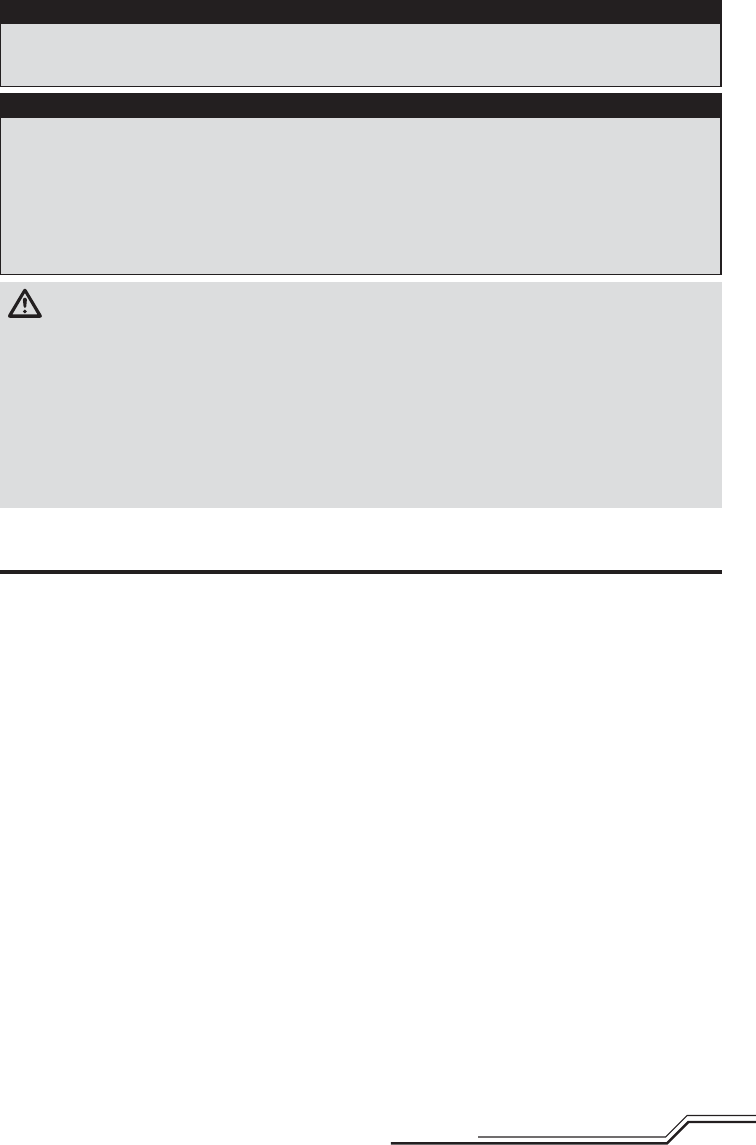
41 IT
AVVERTENZA: leggere TUTTO il manuale di istruzioni e familiarizzare con le caratteristiche del prodotto prima
di farlo funzionare. Un uso improprio del prodotto può causare danni al prodotto stesso e alle altre cose e gravi
lesioni alle persone.
Questo aeromodello è un prodotto sofi sticato per appassionati di modellismo. Deve essere azionato in maniera
attenta e responsabile e richiede alcune conoscenze basilari di meccanica. L’uso improprio o irresponsabile di questo
prodotto può causare lesioni alle persone e danni al prodotto stesso o alle altre cose. Questo prodotto non deve essere
utilizzato dai bambini senza la diretta supervisione di un adulto. Non tentare in nessun caso di smontare il prodotto, di
utilizzarlo con componenti non compatibili odi potenziarlo senza previa approvazione di Horizon Hobby, LLC. Questo
manuale contiene le istruzioni per la sicurezza, l’uso e la manutenzione del prodotto. È fondamentale leggere e seguire
tutte le istruzioni e le avvertenze del manuale prima di montare, impostare o utilizzare il prodotto, alfi ne di utilizzarlo
correttamente e di evitare di causare danni alle cose o gravi lesioni alle persone.
Nella documentazione relativa al prodotto vengono utilizzati i seguenti termini per indicare i vari livelli di pericolo
potenziale durante l’uso del prodotto:
AVVERTENZA: indica procedure che, se non debitamente seguite, determinano il rischio di danni alle cose, danni
collaterali e gravi lesioni alle persone O il rischio elevato di lesioni superfi ciali alle persone.
ATTENZIONE: indica procedure che, se non debitamente seguite, determinano il rischio di danni alle cose E di gravi
lesioni alle persone.
AVVISO: indica procedure che, se non debitamente seguite, possono determinare il rischio di danni alle cose E il
rischio minimo o nullo di lesioni alle persone.
• Mantenere sempre un perimetro di sicurezza intorno al
modello per evitare collisioni o ferite. Questo modello
funziona con comandi radio soggetti alle interferenze di
altri dispositivi non controllabili dall’utente. Leinterferenze
possono provocare una momentanea perdita di controllo.
• Utilizzare sempre l’aeromodello in spazi aperti liberi
daveicoli, traffi co o persone.
• Seguire sempre scrupolosamente le istruzioni e le
avvertenze relative all’aeromodello e a tutti gli accessori
(caricabatterie, pacchi batterie ricaricabili ecc.).
• Tenere sempre le sostanze chimiche, i componenti
dipiccole dimensioni e i componenti elettrici fuori
dallaportata dei bambini.
• Evitare sempre il contatto con l’acqua di tutti i dispositivi
che non sono stati specifi catamente progettati per
funzionare in acqua. L’umidità danneggia le parti
elettroniche.
• Non mettere in bocca alcun componente dell’aeromodello
poiché potrebbe causare lesioni gravi o persino la morte.
• Non far volare l’aeromodello se le batterie del
trasmettitore sono poco cariche.
• Tenere sempre l’aeromodello a vista e sotto controllo.
• Agire sempre sull’interruttore di spegnimento del motore
se l’elicottero perde il controllo o rischia dicadere.
• Utilizzare sempre batterie completamente cariche.
• Tenere sempre acceso il trasmettitore mentre
l’aeromodello è alimentato.
• Rimuovere sempre le batterie prima dello smontaggio.
• Tenere sempre pulite le parti mobili.
• Tenere sempre asciutte le parti.
• Lasciare sempre raffreddare le parti dopo l’uso prima
ditoccarle.
• Rimuovere sempre le batterie dopo l’uso.
• Non far volare mai l’aeromodello con il cablaggio
danneggiato.
• Non toccare mai le parti mobili.
AVVISO
Tutte le istruzioni, le garanzie e gli altri documenti pertinenti sono soggetti a cambiamenti a totale discrezione di
Horizon Hobby, LLC. Per una documentazione aggiornata sul prodotto, visitare il sito horizonhobby.com e fare clic sulla
sezione Support del prodotto.
Convenzioni terminologiche
Ulteriori precauzioni per la sicurezza e avvertenze
Almeno 14 anni. Non è un giocattolo.
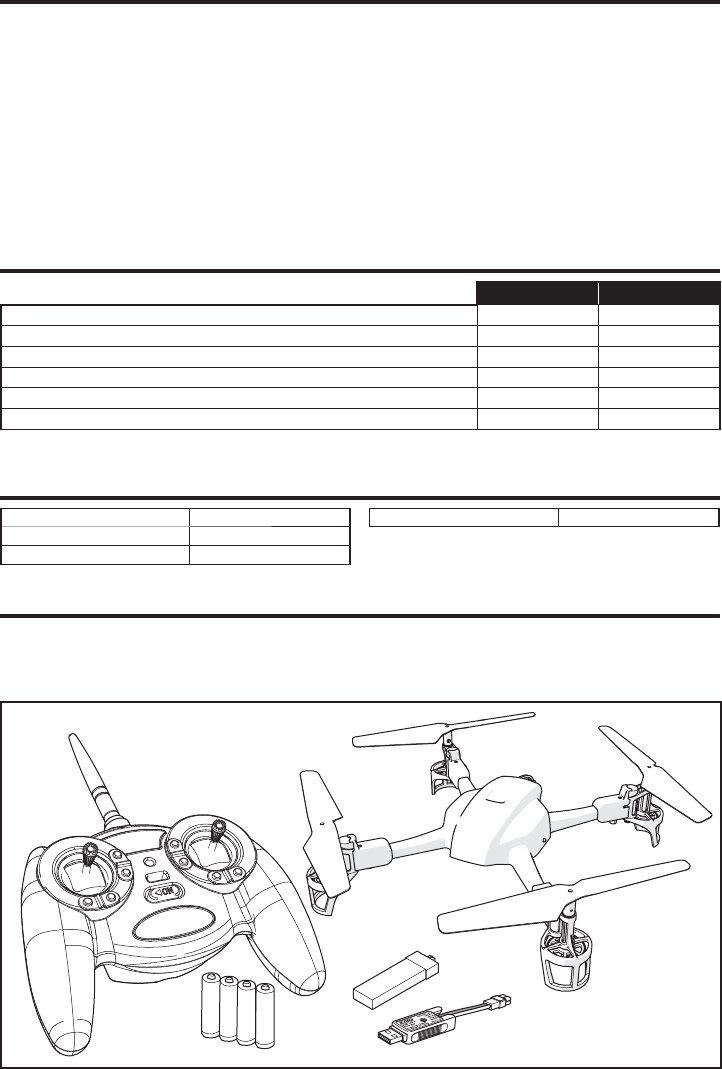
42
IT
Contenuto del Kit
Componenti
Specifi cazioni
• Blade® Ozone™
• Batteria LiPo 1S 3.7V 25C 500mAh (Solo RTF)
• Caricatore LiPo USB 1S (Solo RTF)
• Trasmettitore MLP4DSM (Solo RTF)
• 4 pile AA (Solo RTF)
Indice
Lunghezza 172mm
Altezza 56mm
Diametro elica 65mm
Peso in volo 75 g
RTF BLH9700 BNF BLH9750
Telaio – Blade® Ozone™ (BLH9700) Incluso Incluso
Motori – 8.53mm Brushed, (BLH9709, CW), (BLH9710, CCW) Installata Installata
Elettronica a bordo – Scheda di controllo principale, SAFE® (BLH9706) Installata Installata
Batteria – 500mAh 1S 3.7V 25C Li-Po (EFLB5001S25UM) Incluso Necessario
Caricatore – 1S USB Li-Po, 500 mAh, Alta corrente UMX (EFLC1013) Incluso Necessario
Trasmettitore – MLP4DSM 2.4 GHz, 4 CH, BCMX2 (EFLH1064/B) Incluso Necessario
Per registrare il prodotto online,
visitare il sito www.bladehelis.com
Componenti ...................................................................42
Specifi cazioni ................................................................42
Contenuto del Kit ...........................................................42
Preparazione al primo volo .............................................43
Lista dei controlli prevolo ...............................................43
Avvertenze e istruzioni per le batterie ............................43
Carica della batteria .......................................................43
Montare le pile nel trasmettitore (RTF) ...........................44
Montaggio della batteria di bordo ..................................44
Connessione (binding) fra trasmettitore e ricevitore ........45
SAFE Tecnologia ............................................................46
Controllo trasmettitore ...................................................46
Selezione modalità di volo..............................................47
Codici LED .....................................................................47
Informazioni sui comandi di volo principali .....................48
Il modello Ozone in volo .................................................49
Ispezioni dopo il volo emanutenzione ............................49
Risoluzione dei Problemi ................................................49
Vista esplosa .................................................................51
Elenco delle parti ...........................................................51
Garanzia ........................................................................52
Garanzia e Assistenza - Informazioni per i contatti .........53
Informazioni sulla conformità per l’Unione Europea ........53
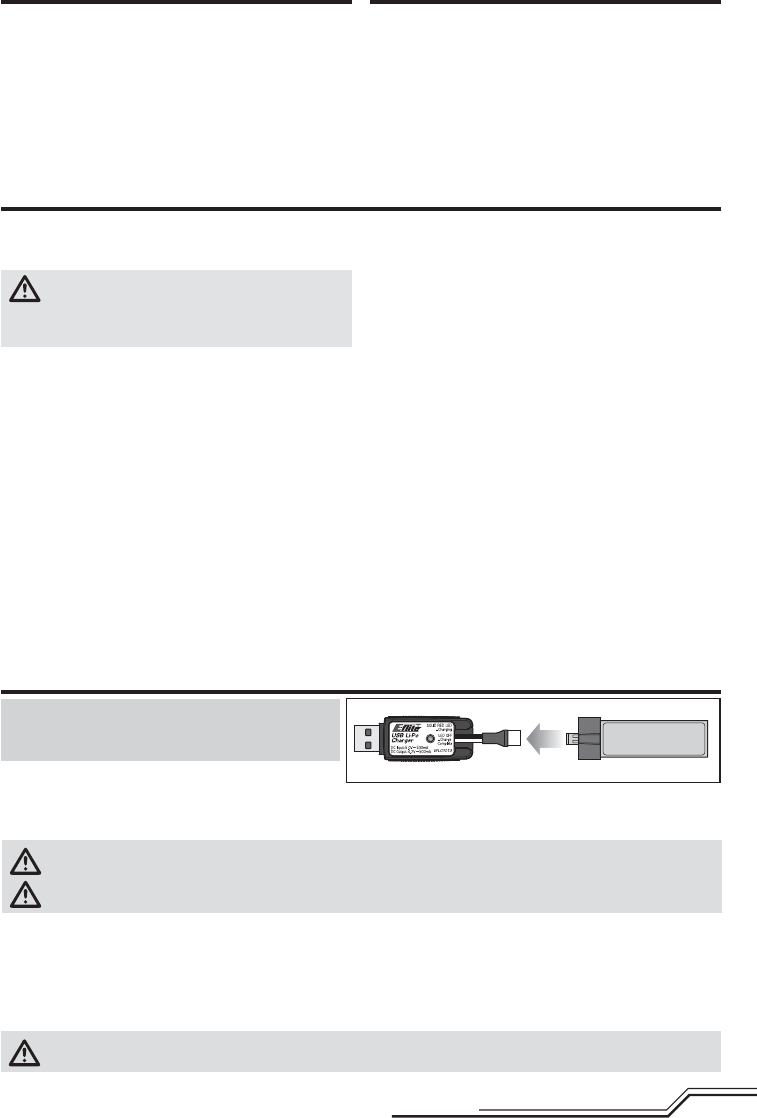
43 IT
AVVISO: caricare le batterie solo se sono fredde al tatto e
non sono danneggiate. Verifi care che le batterie non siano
danneggiate, ad esempio gonfi e, piegate, rotte o forate.
1. Inserire il caricatore in una porta USB.
2. Collegare correttamente la batteria al cavo del carica-
tore.
3. Scollegare la batteria dal caricatore appena la carica è terminata.
ATTENZIONE: usare solo caricatori adatti per le batterie LiPo altrimenti si potrebbero causare incendi o danni.
ATTENZIONE: non superare la corrente di carica consigliata.
Indicazioni dei LED
Fatto il collegamento alla batteria, il LED sul caricatore diventa rosso fi sso, indicando che la carica è iniziata. Per caricare una
batteria da 500mAh completamente scarica (non sovrascaricata) ci vogliono circa 60 minuti. Quando la carica è terminata il LED
si spegne.
IN CARICA (rosso fi sso)
CARICA TERMINATA (spento)
ATTENZIONE: appena terminata la carica staccare la batteria. Non lasciare mai la batteria collegata al caricatore.
Il caricabatterie (EFLC1013) incluso nella confezione del Ozone
è stato concepito per caricare in sicurezza la batteria Li-Po
indotazione.
ATTENZIONE: seguire attentamente le istruzioni e
le avvertenze allegate. L’uso improprio delle batterie
Li-Po può provocare incendi, causare lesioni alle persone e/o
danni alle cose.
• L’installazione, la carica e l’uso della batteria Li-Po inclusa
comportano l’assunzione da parte dell’utente di tutti irischi
associati alle batterie al litio.
• Se durante la carica si forma un rigonfi amento della batteria,
interrompere immediatamente l’uso. Se si sta caricando o
scaricando la batteria, scollegarla e ricollegarla. Il tentativo di
utilizzare, caricare o scaricare una batteria che ha iniziato a
gonfi arsi può dare origine a incendi.
• Per una conservazione ottimale, collocare sempre la batteria
in un luogo asciutto a temperatura ambiente.
• Durante il trasporto o la conservazione temporanea, la
temperatura della batteria deve essere sempre compresa
tra 5 e 49 °C. Non conservare la batteria o l’aeromodello in
auto o sotto la luce diretta del sole. Se conservata all’interno
di un’auto surriscaldata, la batteria potrebbe danneggiarsi o
addirittura incendiarsi.
• Caricare sempre le batterie lontano da materiali infi ammabili.
• Controllare sempre la batteria prima di caricarla e non
caricare mai batterie danneggiate.
• Utilizzare solo caricabatterie specifi catamente progettati per
caricare batterie Li-Po. La carica effettuata con caricabatterie
non compatibili può provocare incendi, causare lesioni alle
persone e/o danni materiali.
• Controllare costantemente la temperatura del pacco batterie
durante la carica.
• Scollegare sempre la batteria dopo la carica e lasciare
raffreddare il caricabatterie tra una carica e l’altra.
• Le celle Li-Po non devono essere mai scaricate sotto i 3 V in
condizioni di carico.
• Non coprire mai le etichette di avvertenza con ganci o
bandelle.
• Non lasciare mai incustodite le batterie in carica.
• Non caricare mai le batterie a livelli al di fuori di quelli
raccomandati.
• Caricare soltanto batterie che risultano fredde al tatto.
• Non tentare mai di smontare o alterare il caricabatterie.
• Non lasciare mai caricare i pacchi batterie a minori.
• Non caricare mai le batterie in ambienti estremamente caldi
o freddi (la temperatura consigliata è compresa tra5 e 49
°C) né collocarle sotto la luce diretta del sole.
Avvertenze e istruzioni per le batterie
Carica della batteria
Preparazione al primo volo
• Togliere il contenuto dalla scatola e controllarlo
• Iniziare a caricare la batteria di volo
• Montare la batteria sul Quad-Copter (dopo averla ben
caricata)
• Programmare il trasmettitore computerizzato (solo BNF)
• Connettere (bind) il vostro tramettitore (solo BNF)
• Familiarizzare con i comandi
• Trovare un’area adatta al volo
Lista dei controlli prevolo
❏Accendere sempre prima il trasmettitore
❏ Collegare la batteria di volo al cavo proveniente
dall’unità di controllo 5-in-1
❏Attendere che l’unità di controllo 5-in-1 si inizializzi e
si armi
❏Far volare il modello
❏Far atterrare il modello
❏Scollegare la batteria di bordo dall’unità di controllo
❏Spegnere sempre il trasmettitore per ultimo
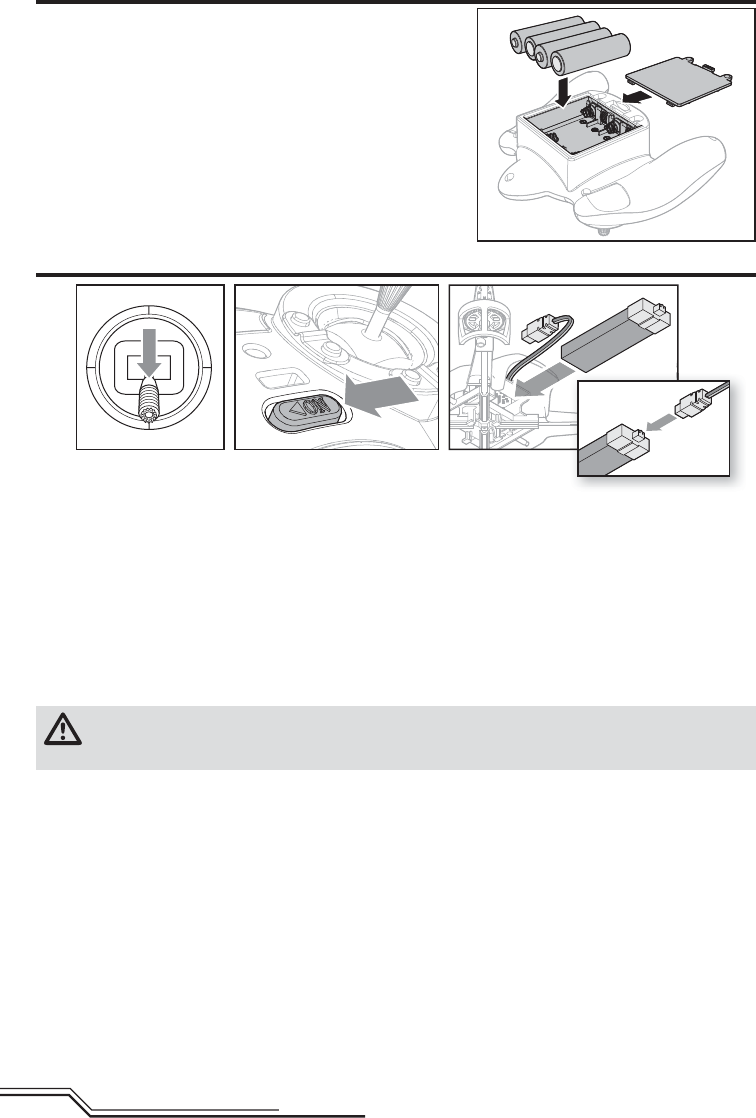
44
IT
Montare le pile nel trasmettitore (RTF)
Quando il LED del trasmettitore lampeggia e si sente un beep, bisogna
sostituire le pile.
1. Abbassare la manetta portandola sulla posizione più bassa. Per il velivolo BNF, mantenere impegnata la manetta, se
la trasmittente lo consente.
2. Accendere la trasmittente.
3. Applicare la batteria facendola scorrere nell’apposita fessura di montaggio sotto all’unità di controllo. Far scorrere la
batteria nelle fessure con l’etichetta rivolta verso l’alto in modo tale che la chiave della batteria stampata nel tappo di
estremità della batteria vada a contatto con la chiave della fessura della batteria.
4. Collegare il cavo della batteria all’unità di controllo.
5. Posizionare il quadricottero su una superfi cie piana e lasciare fermo il velivolo fi no a quando il LED sull’unità di
controllo indica una delle seguenti modalità di volo:
Blu fi sso: Modalità stabilità, posizione interruttore 1
Rosso fi sso: Modalità agilità, posizione interruttore 2
ATTENZIONE: per evitare che le batterie si sovra scarichino, bisogna sempre scollegarle dal velivolo quando
non si vola. Le batterie scaricate ad una tensione inferiore a quella stabilita, si danneggiano, riducendo le loro
prestazioni con la possibilità di causare un incendio quando vengono caricate.
Montaggio della batteria di bordo
12
ere impegnata la manetta se
3
4
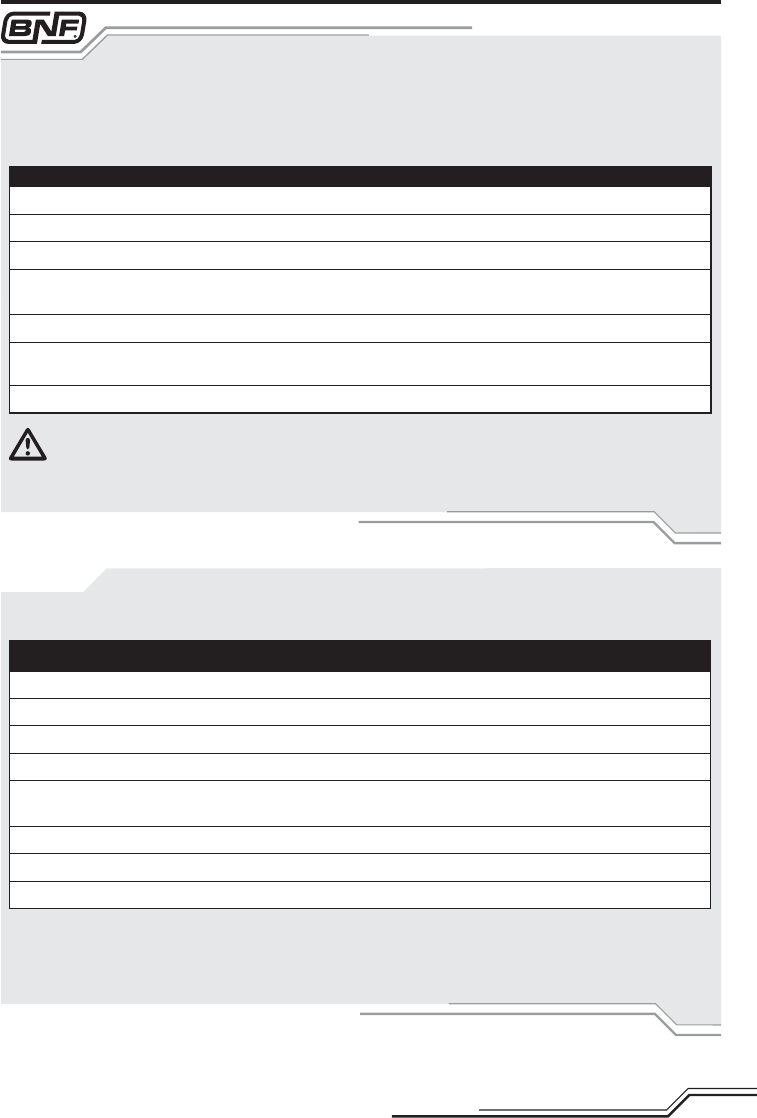
45 IT
ATTENZIONE: quando si utilizza un trasmettitore Futaba® con un modulo Spektrum ™ DSM2® / DSMX®,
è necessario invertire il canale del gas e re-rilegare. Fare riferimento al manuale del modulo Spektrum per le
istruzioni di binding e failsafe. Fare riferimento al manuale del trasmettitore Futaba per istruzioni su come invertire il
canale del gas.
Procedura di “binding” con trasmettitore MLP4DSM
1. Scollegare la batteria di volo dal quadricottero.
2. Centrare tutti i trim sulla trasmittente.
3. Spegnere la trasmittente e spostare tutti gli interruttori in posizione 0.
4. Collegare la batteria di volo al quadricottero. Il LED sull’unità di controllo lampeggia dopo 5 secondi.
5. Quando la luce blu lampeggia, spingere e tenere verso il basso lo stick sinistro* mentre si alimenta la trasmitten-
te (si sente un click)
6. Rilasciare lo stick sinistro. La trasmittente emetterà un segnale acustico e il LED on/off lampeggerà.
7. Il quadricottero è connesso quando tutti i LED sull'aereo si accendono con luce fi ssa.
8. Scollegare la batteria di volo e spegnere la trasmittente.
* Questo interruttore di attivazione si può usare anche nella procedura di connessione (binding).
Se si incontrassero problemi, osservare le istruzioni per il “binding” e far riferimento alla guida per la soluzione dei
problemi per ulteriori istruzioni. Se necessario contattare il servizio assistenza Horizon. Per un elenco completo dei
trasmettitori DSM compatibili visitare il sito www.bindnfl y.com.
RTF
Il trasmettitore RTF viene fornito già connesso al modello. Se serve rifare la connessione, si prega
di osservare le seguenti indicazioni.
Connessione (binding) fra trasmettitore e ricevitore
Se si utilizza una trasmittente computerizzata, impostare il tipo di modello su “Acro” o “Airplane”. Nel menu channel
input (canali in ingresso), assegnare il canale 6 (Aux 1) a un interruttore a pulsante, ad esempio il pulsante BIND
(connessione) (I), e il canale 5 (Gear) a un interruttore a 3 posizioni (interruttore B). Nel menu Servo Setup (Imposta
servi), invertire il canale 6 (Aux 1).
Collegare il quadricottero alla trasmittente seguendo le istruzioni per la connessione trasmittente-ricevitore sottostanti.
Procedura generale per la connessione (binding)
1. Scollegare la batteria di volo dal quadricottero.
2. Centrare tutti i trim sulla trasmittente.
3. Spegnere la trasmittente e abbassare completamente il comando motore.
4. Collegare la batteria di volo al quadricottero. Tutti i LED presenti sull'aereo lampeggeranno rapidamente, indican-
do che il modello è entrato in modalità connessione.
5. Attivare la modalità connessione sulla trasmittente durante l'accensione.
6. Rilasciare il pulsante/interruttore di connessione dopo 2-3 secondi. Il quadricottero è connesso quando tutti i LED
sull'aereo si accendono con luce fi ssa.
7. Scollegare la batteria di volo e spegnere la trasmittente.
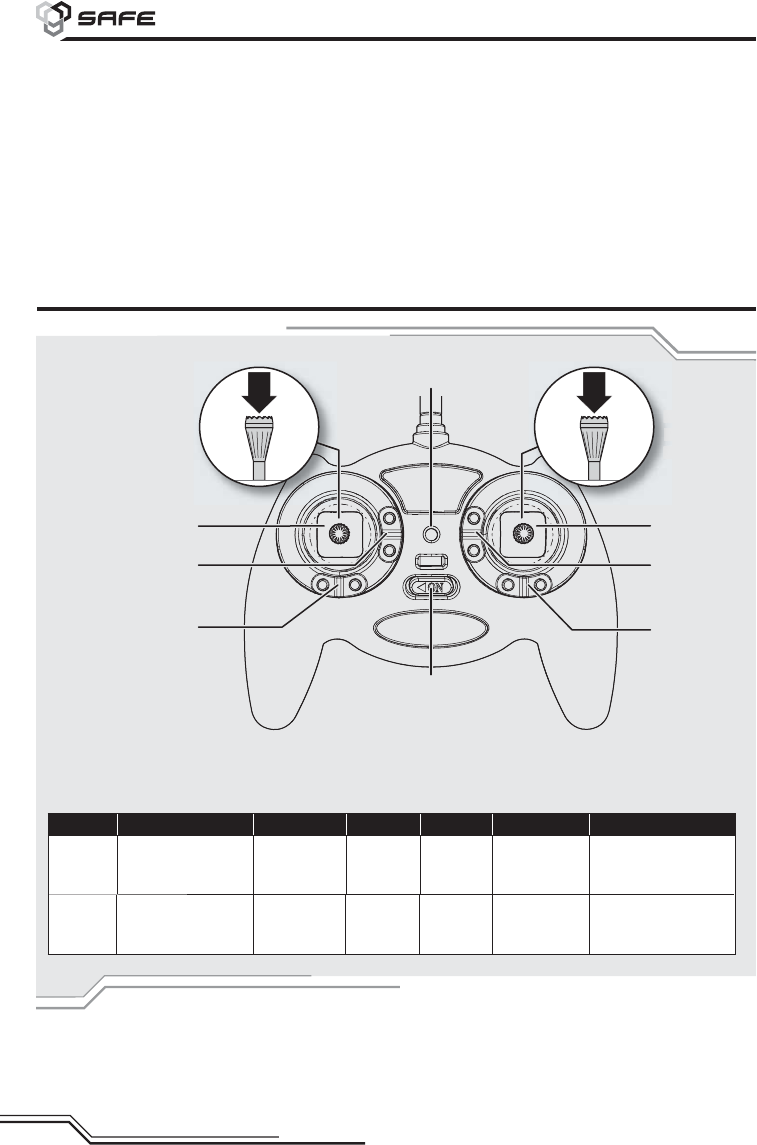
46
IT
RTF
Controllo trasmettitore
La rivoluzionaria tecnologia SAFE usa una combinazione innovativa di sensori ad assi multipli e un software che permette
al modello di conoscere la sua posizione relativa all'orizzonte. Questa percezione spaziale viene utilizzata per controllare
l'inviluppo di volo del velivolo e mantenere l'inclinazione di rollio o beccheggio entro campi ridotti per volare con maggiore
sicurezza. Oltre alla stabilità questo tipo di protezione permette varie modalità di comportamento in modo che il pilota possa
scegliere in base al suo livello di preparazione per sentirsi sempre sicuro nel controllo.
La tecnologia SAFE fornisce:
• Protezione dell'inviluppo di volo attivabile con un interruttore.
• Varie modalità permettono di adeguare la tecnologia SAFE al proprio livello di preparazione.
La cosa migliore è che la sofi sticata tecnologia SAFE non richiede alcun intervento di messa a punto per poterla usare. Ogni
velivolo con il SAFE installato è pronto all'uso per offrire la miglior esperienza di volo possibile.
FlySAFERC.com
Tecnologia
®
ABCDE F
Modalità
1
Alettone
(Sinistra/Destra)
Acceleratore (Su/Giù)
Regolare
Acceleratore
Regolare
Alettone
Regolare
Timone
Regolare
Elevatore
Timone
(Sinistra/Destra)
Elevatore (Su/Giù)
Modalità
2
Alettone
(Sinistra/Destra)
Elevatore (Su/Giù)
Regolare
Elevatore
Regolare
Alettone
Regolare
Timone
Regolare
Acceleratore
Timone
(Sinistra/Destra)
Acceleratore (Su/Giù)
Scelta della
modalità di
volo
• Connessione
• Pressione lunga:
Armare/Disarmare
D
E
F
LED di alimentazione
C
B
A
Interruttore ON/OFF
Se premuti, i pulsanti dei trim emettono un suono che aumenta o diminuisce di intensità a ogni pressione. La
posizione del trim intermedia o neutra è associata a un tono medio nell’intervallo di passo dei suoni. La fi ne del
campo di controllo è segnalata da una serie di beep.
Sc
m
vo
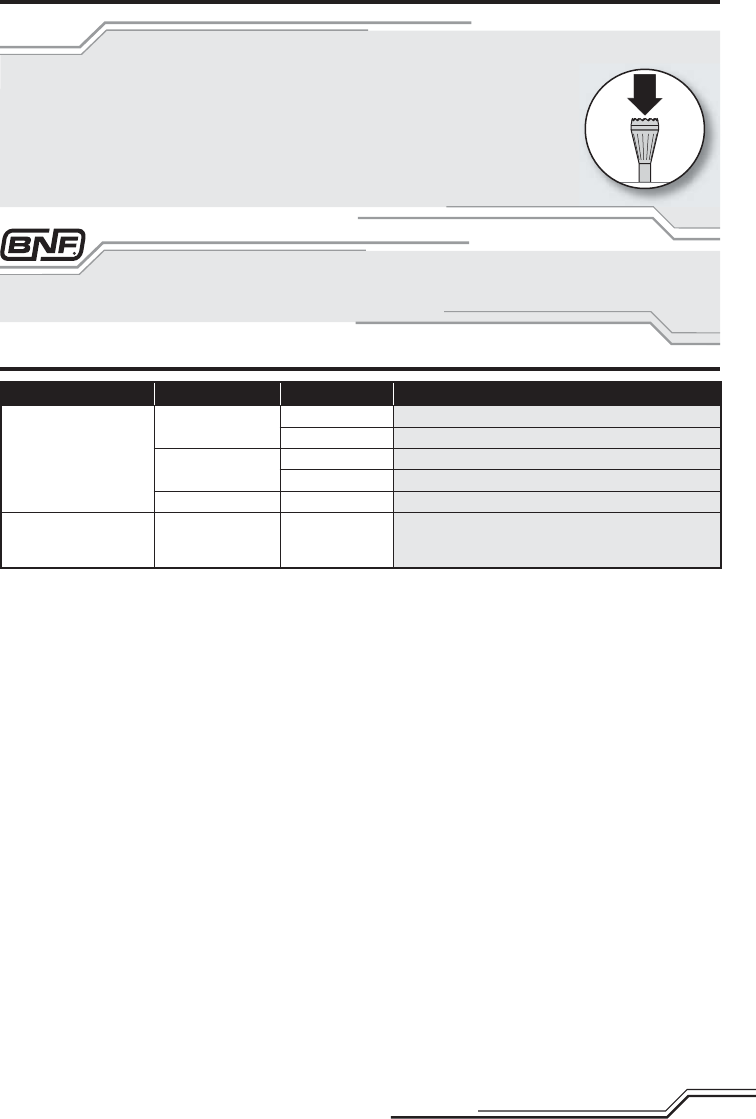
47 IT
RTF
Modifi care le modalità di volo spingendo verso il basso lo stick destro. Assicurarsi che
l’interruttore della modalità di volo sia nella posizione desiderata prima di volare.
• In modalità Stabilità (posizione dell'interruttore 1), i controlli forniscono un angolo minimo di
inclinazione. Questa modalità è indicata dai LED di controllo del volo sul quadricottero che si
illuminano di blu fi sso.
• La modalità Agility (posizione dell'interruttore 2) è indicata dai LED di controllo del volo sul
quadricottero che si illuminano di rosso fi sso.
Se si acquista un quadricottero BNF Ozone™, l’interruttore del canale 5 sulla tua trasmittente selezionerà le modalità
di volo.
Scelta della modalità di volo
Codici LED
Apparecchiatura Colore del LED Stato del LED Operazione
Quadricottero:
LED di controllo del
volo sulla scheda di
controllo
Blu Fisso Modalità stabilità, posizione interruttore 1
Lampeggio Perdita di RF / Trasmittente spenta (OFF)
Rosso Fisso Modalità di agilità, posizione interruttore 2
Lampeggio Batteria scarica
Bianca Lampeggio Disarmato, pronto
Quadricottero:
LED guscio motore
esternos
Bianca (Anteriore)
Rosso (Posteriore) Lampeggio lento Relativamente all’inserimento della manetta
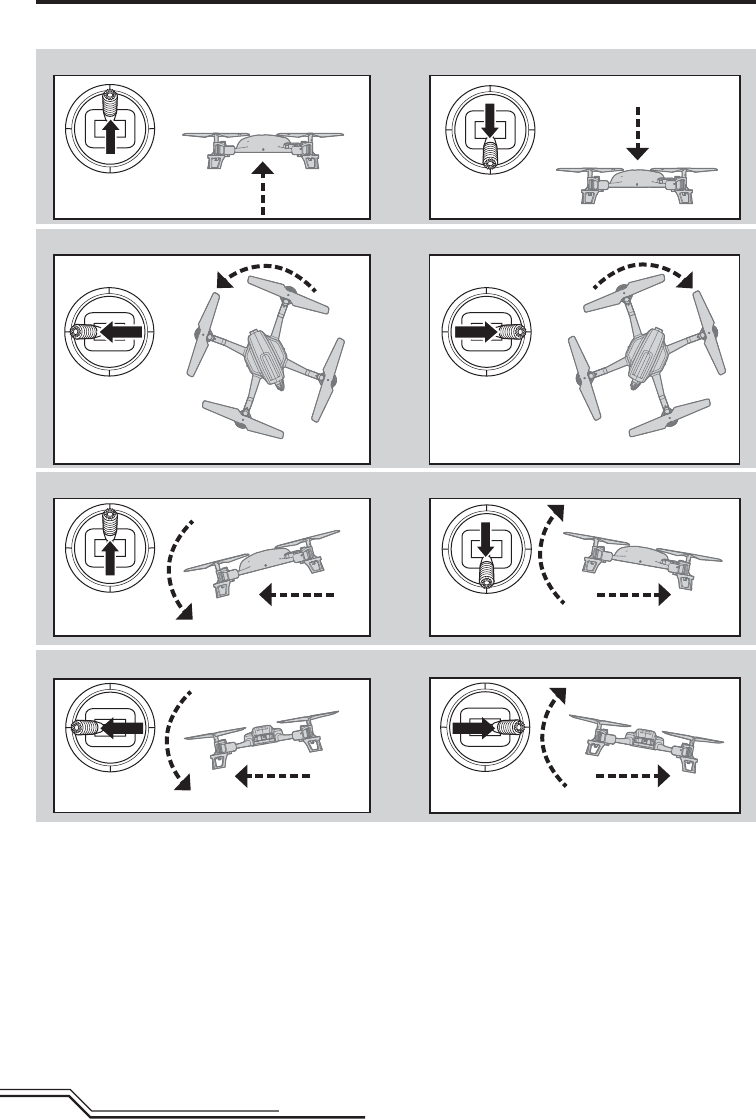
48
IT
Elevatore
Avanti
Elevatore
abbassato Elevatore
alzato Indietro
Timone
Timone a sinistra Timone a destra
Informazioni sui comandi di volo principali
Se non si ha familiarità con i comandi dell’Ozone, è necessario dedicare alcuni minuti per familiarizzarsi con essi prima di
tentare il primo volo.
Acceleratore
Acceleratore
abbassato
Acceleratore
alzato
Vista laterale sinistra
Vista laterale sinistra
Vista laterale sinistra
Vista laterale sinistra
Discesa
Salita
Alettone
Alettone a
sinistra Sinistra Alettone a
destra Destra
Vista posterioreVista posteriore
La fusoliera vira a destraLa fusoliera vira a sinistra
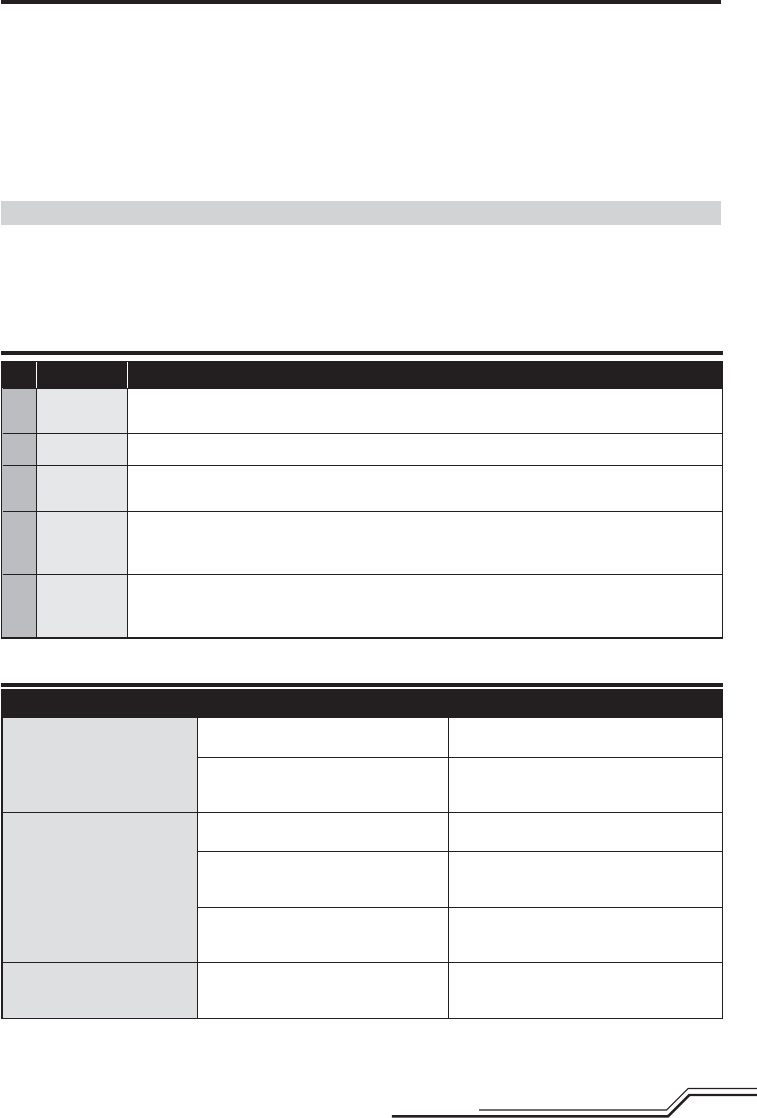
49 IT
Ispezioni dopo il volo e manutenzione
√
Pulizia Assicurarsi che la batteria non sia collegata prima di effettuare la pulizia. Rimuovere polvere eresi-
dui con una spazzola morbida oun panno asciutto eprivo di peli.
Motori Sostituire il motore quando il modello non vola livellato o tende a virare in salita.
Cablaggio Assicurarsi che icavi non blocchino componenti in movimento. Sostituire icavi danneggiati eicon-
nettori allentati.
Sistemi di
fi ssaggio
Assicurarsi che non ci siano viti, elementi di fi ssaggio oconnettori allentati. Non stringere eccessiva-
mente le viti in metallo in componenti di plastica. Serrare la vite in modo che le parti siano abattuta,
poi girare la vite solo 1/8 di giro in più.
Rotori
Assicurarsi che non vi siano danni alle pale del rotore ein altri componenti che si muovono ad
alta velocità. Danni in questi componenti sono costituiti da incrinature, sbavature, trucioli ograffi .
Sostituire le parti danneggiate prima del volo.
Risoluzione dei Problemi
Decollo
Aumentare il gas fi no a che il modello non raggiungera una quota di circa 60 cm dal suolo, controllare i trim in modo
che il modello si comporti come desiderato. Una volta controllati i trim cominciare a volare in modello normalmente.
Per la batteria fornita, il tempo di volo va da 5 a 10 minuti.
Cuto di Basso Voltaggio (LVC)
Il sistema LVC taglierà la corrente ai motori una volta che il voltaggio della batteria raggiungerà il livello di guardia.
Quando la potenza dei motori diminuirà e il LED della unità 5 in 1 diventerà di colore rosso fi sso, atterrare immediata-
mente e caricare la batteria.
La funzione LVC non previene la sovrascarica delle batterie quando sono immagazzinate.
AVVISO: le batterie si potrebbero danneggiare se il sistema LVC interviene ripetutamente.
Atterraggio
Per atterrare, diminuire gradualmente il gas fi no ad arrivere ad un hovering a bassa quota. Dopo l'atterraggio disconnettere
la batteria im modo da eliminare il rischio di scaricarla oltre il livello minimo. Caricare la batteria completamente prima di
riporla. Durante il periodo di stoccaggio della batteria il voltaggio della stessa non deve scendere al di sotto dei 3V.
Il modello Ozone in volo
Problema Possibile Causa Soluzione
Il controllo del quadricoptero
risulta inconsistente o richiede
extra trim per neutralizzare
movimenti non voluti.
Velivolo non inizializzato su di una super-
ficie piana. Scollegare la batteria di bordo, centrare il trim
e ripetere l'inizializzazione del quadricottero.
Batteria non inserita bene nella sua sede. Regolare la posizione della batteria in modo
che il quadricottero sia bilanciato al centro
del telaio.
Il quadricoptero non risponde al
comando del gas.
Stick e/o trim del motore troppo in alto. Resettare i controlli con stick e trim comple-
tamente in basso.
Il quadricoptero è stato mosso durante
l'accensione.
Scollegare la batteria di bordo e rifare l’ini-
zializzazione dello quadricoptero tenendolo
ben fermo.
Il canale del motore è invertito. Disconnettere la batteria di volo, invertire il
canale del gas nella trasmittente, riconnettere
la batteria di volo.
Il quadricoptero non funziona
ed emette odore di bruciato
dopo aver connesso la batteria.
Batteria di bordo collegata con
polarità invertita.
Sostituire il circuito del 4-in-1. Collegare
la batteria di bordo facendo attenzione alla
polarità.
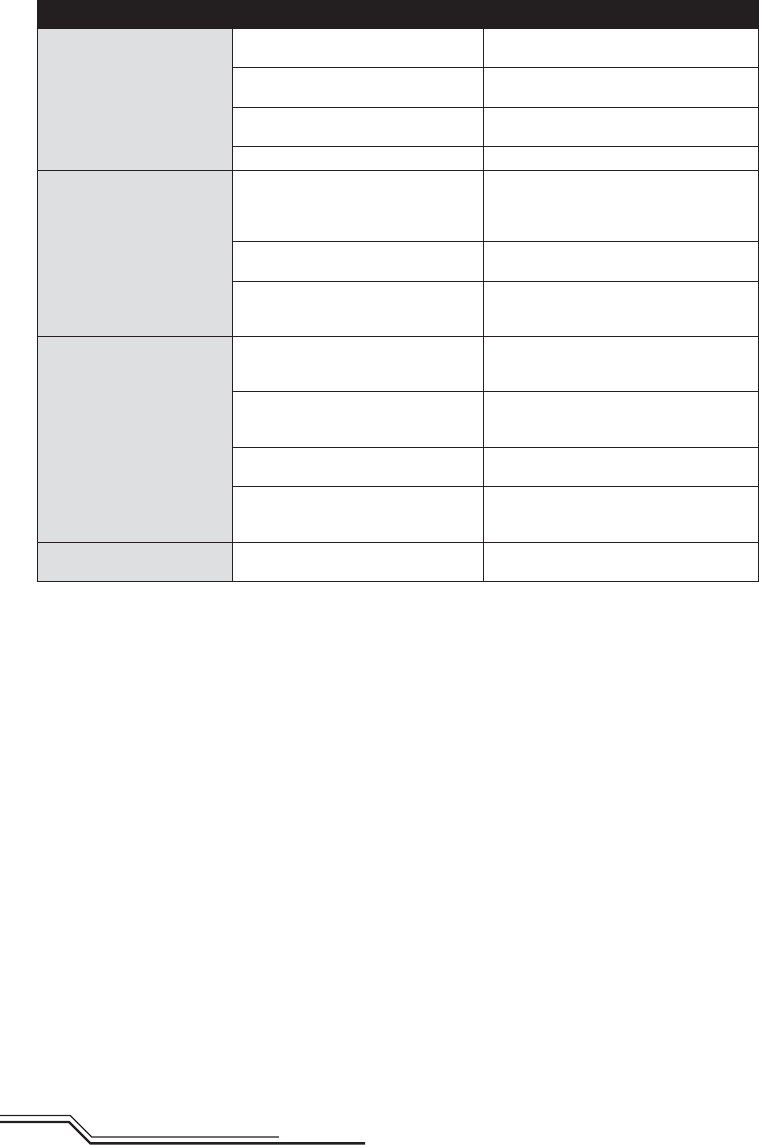
50
IT
Problema Possibile Causa Soluzione
Il quadricoptero ha una durata
di volo ridotta o ha una potenza
ridotta.
Batteria di bordo quasi scarica. Ricaricare completamente la batteria di
bordo.
Caricabatterie alimentato con scarsa
potenza. Usare un'alimentazione USB diversa per il
caricatore.
Batteria di bordo danneggiata. Sostituire la batteria di bordo seguendo le
istruzioni.
La temperatura esterna è troppo bassa. Tenere la batteria al caldo prima dell’uso.
Il LED sul ricevitore lampeggia
velocemente e l’aereo non
risponde al trasmettitore (du-
rante il “binding”).
Trasmettitore troppo vicino al modello
durante la procedura di “binding”.
Spegnere il trasmettitore. Allontanare il tra-
smettitore all’aereo. Scollegare e ricollegare
la batteria di bordo. Ripetere la procedura di
“binding” seguendo le istruzioni.
Il comando per il "bind" non è stato pre-
muto all'accensione del trasmettitore. Spegnere il trasmettitore e ripetere la pro-
cedura.
Il modello o il trasmettitore sono troppo
vicini a grossi oggetti metallici, sorgenti
WiFi o ad un altro trasmettitore.
Spostare il modello e il trasmettitore in un
altro posto prima di ripetere la procedura.
Il LED della ricevente lampeg-
gia rapidamente ed il quadri-
coptero non risponde alla tra-
smittente (dopo aver effettuato
le operazioni di Binding).
Sono passati meno di 5 secondi tra
l'accensione della trasmittente e la con-
nessione della batteria di volo.
Lasciare la trasmittente accesa. Discon-
nettere e riconnettere la batteria di volo al
quadricoptero.
Il quadricoptero è bindato ad una me-
moria diversa della trasmittente (solo per
trasmittenti con ModelMatch).
Selezionare la corretta memoria nella trasmit-
tente. Disconnettere e riconnettere la batterie
di volo del quadricoptero.
Batteria di bordo o del trasmettitore quasi
scariche. Sostituire o ricaricare le batterie.
Il modello o il trasmettitore sono troppo
vicini a grossi oggetti metallici, sorgenti
WiFi o ad un altro trasmettitore.
Spostare il modello e il trasmettitore in un
altro posto prima di ripetere la procedura.
Si schianta al suolo immediata-
mente dopo essersi sollevato. Eliche nella posizione sbagliata o modali-
tà di volo scelta non corretta. Effettuare le regolazioni necessarie.
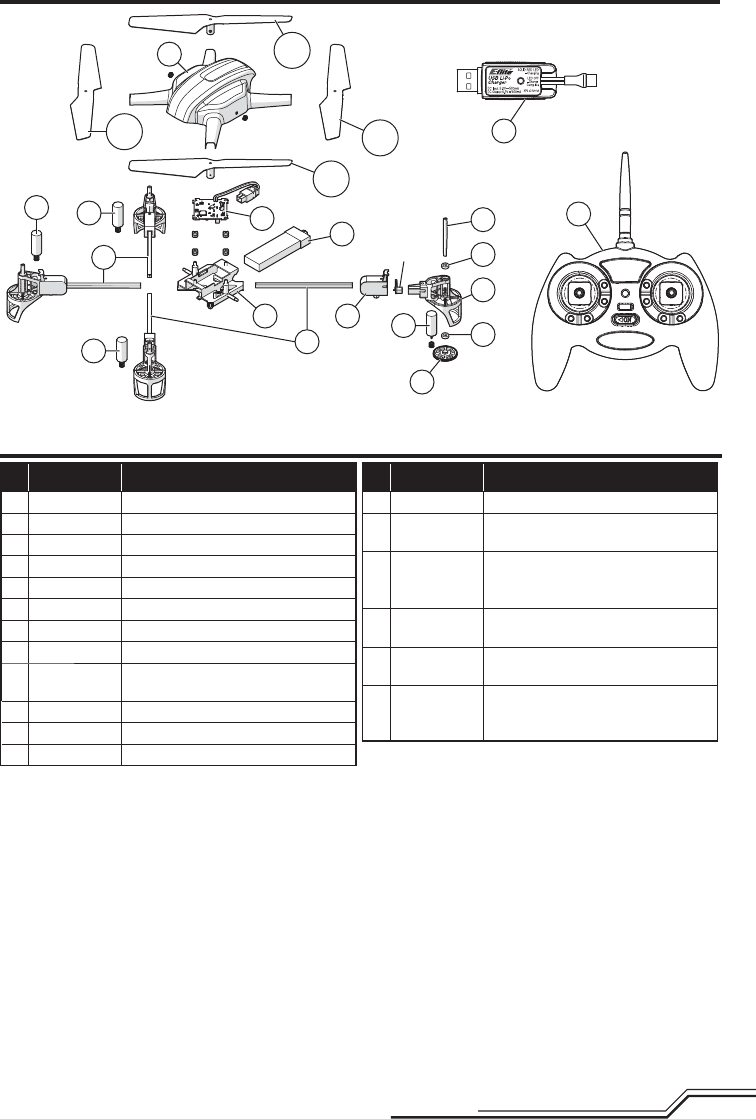
51 IT
Vista esplosa
Elenco delle parti
Codice Descrizione
1 BLH9706 Scheda di controllo principale: Ozone
2 BLH9707 Set braccio sinistro (2)
3 BLH9708 Set braccio destro (2)
4 BLH9710 Motore antiorario
5 BLH9709 Motore orario
6 BLH9702 Telaio interno
7 BLH9704 Capottina
8 BLH9703 Set completo elica (4)
9 BLH9705 Coperchio per montaggio motore
(semitrasparente)
10 BLH9712 Skid di atterraggio
11 BLH7521 Elica, rotazione CCW, nero, (2)
12 BLH7520 Elica MQX, rotazione CW, nero, (2)
Codice Descrizione
13 BLH7513 Albero dell'elica, carbonio
14 BLH3506 Ingranaggio principale: BMSR, mCP
S/X
15 BLH3515
Cuscinetto albero principale, 3x6x2
mm (2):
BMCX/2/MSR, MH-35, mCP X
16 EFLB5001S25UM LiPo 3,7 V 500 mAh 1S 25C,
connettore UMX alta corrente
17 EFLC1013 Caricabatterie LiPo USB 1A, 500
mAh, connettore UMX alta corrente
18 EFLH1064/B Trasmittente a 4 canali MLP4DSM
Blade
2,4 GHz; BMCX2, 120SR
14
15
15
LED
13
17
18
10
8
12 8
12
8
11
8
11
1
6
2
3
9
16
4
4
5
5
7

52
IT
Garanzia
Periodo di garanzia
La garanzia esclusiva - Horizon Hobby, LLC, (Horizon) garantisce
che i prodotti acquistati (il “Prodotto”) sono privi di difetti relativi
ai materiali e di eventuali errori di montaggio. Il periodo di
garanzia è conforme alle disposizioni legali del paese nel quale il
prodotto è stato acquistato. Tale periodo di garanzia ammonta a
6 mesi e si estende ad altri 18 mesi dopo tale termine.
Limiti della garanzia
(a) La garanzia è limitata all’acquirente originale (Acquirente) e
non è cedibile a terzi. L’acquirente ha il diritto a far riparare o
a far sostituire la merce durante il periodo di questa garanzia.
La garanzia copre solo quei prodotti acquistati presso un
rivenditore autorizzato Horizon. Altre transazioni di terze parti
non sono coperte da questa garanzia. La prova di acquisto è
necessaria per far valere il diritto di garanzia. Inoltre, Horizon
si riserva il diritto di cambiare o modificare i termini di questa
garanzia senza alcun preavviso e di escludere tutte le altre
garanzie già esistenti.
(b) Horizon non si assume alcuna garanzia per la disponibilità
del prodotto, per l’adeguatezza o l’idoneità del prodotto
a particolari previsti dall’utente. È sola responsabilità
dell’acquirente il fatto di verificare se il prodotto è adatto agli
scopi da lui previsti.
(c) Richiesta dell’acquirente – spetta soltanto a Horizon, a
propria discrezione riparare o sostituire qualsiasi prodotto
considerato difettoso e che rientra nei termini di garanzia.
Queste sono le uniche rivalse a cui l’acquirente si può
appellare, se un prodotto è difettoso. Horizon si riserva il
diritto di controllare qualsiasi componente utilizzato che
viene coinvolto nella rivalsa di garanzia. Le decisioni relative
alla sostituzione o alla riparazione avvengono solo in base
alla discrezione di Horizon. Questa garanzia non copre dei
danni superficiali o danni per cause di forza maggiore, uso
errato del prodotto, negligenza, uso ai fini commerciali,
o una qualsiasi modifica a qualsiasi parte del prodotto.
Questa garanzia non copre danni dovuti ad una installazione
errata, ad un funzionamento errato, ad una manutenzione
o un tentativo di riparazione non idonei a cura di soggetti
diversi da Horizon. La restituzione del prodotto a cura
dell’acquirente, o da un suo rappresentante, deve essere
approvata per iscritto dalla Horizon.
Limiti di danno
Horizon non si riterrà responsabile per danni speciali, diretti,
indiretti o consequenziali; perdita di profitto o di produzione;
perdita commerciale connessa al prodotto, indipendentemente
dal fatto che la richiesta si basa su un contratto o sulla garanzia.
Inoltre la responsabilità di Horizon non supera mai in nessun
caso il prezzo di acquisto del prodotto per il quale si chiede la
responsabilità. Horizon non ha alcun controllo sul montaggio,
sull’utilizzo o sulla manutenzione del prodotto o di combinazioni
di vari prodotti. Quindi Horizon non accetta nessuna
responsabilità per danni o lesioni derivanti da tali circostanze.
Con l’utilizzo e il montaggio del prodotto l’utente acconsente
a tutte le condizioni, limitazioni e riserve di garanzia citate in
questa sede. Qualora l’utente non fosse pronto ad assumersi
tale responsabilità associata all’uso del prodotto, si suggerisce di
restituire il prodotto intatto, mai usato e immediatamente presso
il venditore.
Indicazioni di sicurezza
Questo è un prodotto sofisticato di hobbistica e non è un
giocattolo. Esso deve essere manipolato con cautela, con
giudizio e richiede delle conoscenze basilari di meccanica e delle
facoltà mentali di base. Se il prodotto non verrà manipolato in
maniera sicura e responsabile potrebbero risultare delle lesioni,
dei gravi danni a persone, al prodotto o all’ambiente circostante.
Questo prodotto non è concepito per essere usato dai bambini
senza una diretta supervisione di un adulto. Il manuale del
prodotto contiene le istruzioni di sicurezza, di funzionamento e
di manutenzione del prodotto stesso. È fondamentale leggere
e seguire tutte le istruzioni e le avvertenze nel manuale prima
di mettere in funzione il prodotto. Solo così si eviterà un utilizzo
errato e di preverranno incidenti, lesioni o danni.
Domande, assistenza e riparazioni
Il vostro negozio locale e/o luogo di acquisto non possono fornire
garanzie di assistenza o
riparazione senza previo colloquio con Horizon. Questo vale
anche per le riparazioni in garanzia.
Quindi in tale casi bisogna interpellare un rivenditore, che si
metterà in contatto subito con
Horizon per prendere una decisione che vi possa aiutare nel più
breve tempo possibile.
Manutenzione e riparazione
Se il prodotto deve essere ispezionato o riparato, si prega di
rivolgersi ad un rivenditore specializzato o direttamente ad
Horizon. Il prodotto deve essere Imballato con cura. Bisogna
far notare che i box originali solitamente non sono adatti
per effettuare una spedizione senza subire alcun danno.
Bisogna effettuare una spedizione via corriere che fornisce
una tracciabilità e un’assicurazione, in quanto Horizon non
si assume alcuna responsabilità in relazione alla spedizione
del prodotto. Inserire il prodotto in una busta assieme ad una
descrizione dettagliata dei problemi e ad una lista di tutti i singoli
componenti spediti. Inoltre abbiamo bisogno di un indirizzo
completo, di un numero di telefono per rivolgere ulteriori
domande e di un indirizzo e-mail.
Garanzia a riparazione
Le richieste in garanzia verranno elaborate solo se è presente
una prova d’acquisto in originale proveniente da un rivenditore
specializzato autorizzato, nella quale è ben visibile la data di
acquisto. Se la garanzia viene confermata, allora il prodotto verrà
riparato o sostituito. Questa decisione spetta esclusivamente a
Horizon Hobby.
Riparazioni a pagamento
Se bisogna effettuare una riparazione a pagamento,
effettueremo un preventivo che verrà inoltrato al vostro
rivenditore. La riparazione verrà effettuata dopo l’autorizzazione
da parte del vostro rivenditore. La somma per la riparazione
dovrà essere pagata al vostro rivenditore. Le riparazioni a
pagamento avranno un costo minimo di 30 minuti di lavoro
e in fattura includeranno le spese di restituzione. Qualsiasi
riparazione non pagata e non richiesta entro 90 giorni verrà
considerata abbandonata e verrà gestita di conseguenza.
ATTENZIONE : Le riparazioni a pagamento sono
disponibili solo sull’elettronica e sui motori. Le
riparazioni a livello meccanico, soprattutto per gli
elicotteri e le vetture RC sono molto costose e devono
essere effettuate autonomamente dall’acquirente.
5/2015
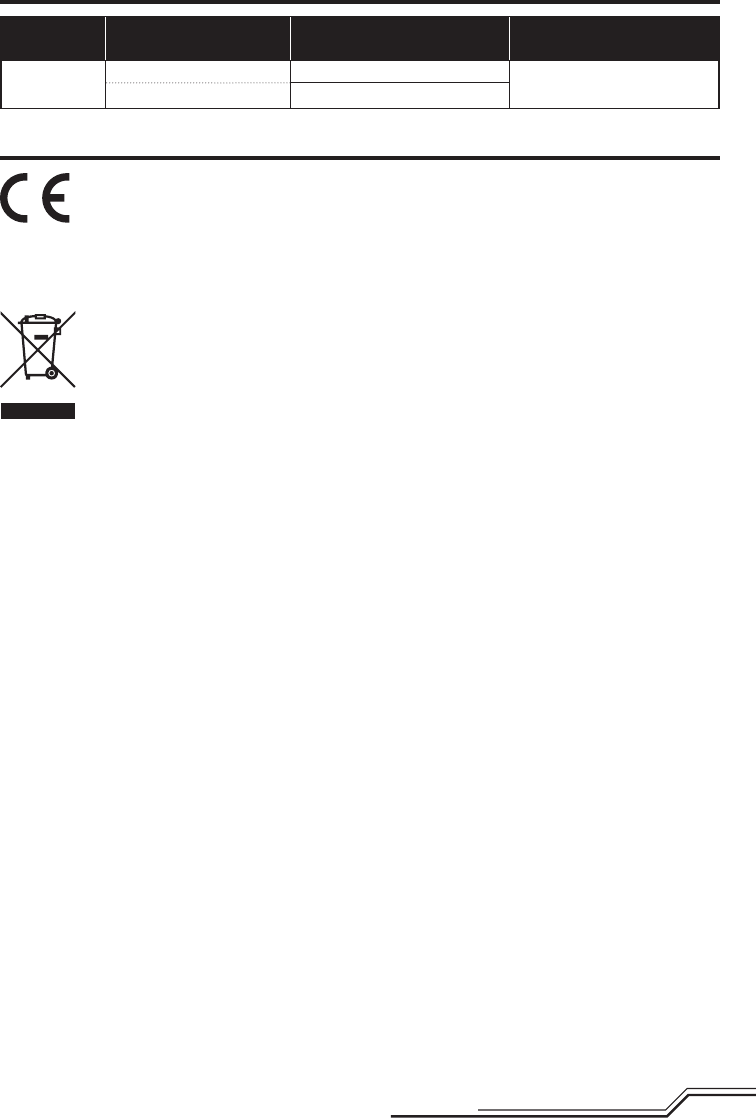
53 IT
Garanzia e Assistenza - Informazioni per i contatti
Stato
di acquisto Horizon Hobby Telefono/Indirizzo e-mail Indirizzo
Unione Europea Horizon Technischer Service service@horizonhobby.eu Hanskampring 9
D 22885 Barsbüttel, Germany
Sales: Horizon Hobby GmbH +49 (0) 4121 2655 100
Dichiarazione di conformità UE:
BLH9700: Horizon Hobby, LLC con la presente dichiara che il prodotto è conforme ai requisiti essenziali e ad
altre disposizioni rilevanti delle direttive RED e EMC.
BLH9750: Horizon Hobby, LLC con la presente dichiara che il prodotto è conforme ai requisiti essenziali e ad altre
disposizioni rilevanti della direttiva RED.
Una copia della dichiarazione di conformità per l’Unione Europea è disponibile a:
http://www.horizonhobby.com/content/support-render-compliance.
Informazioni sulla conformità per l’Unione Europea
Istruzioni del RAEE per lo smaltimento da parte di utenti dell’Unione Europea
Questo prodotto non deve essere smaltito assieme ai rifi uti domestici. Al contrario, l’utente è responsabile
dello smaltimento di tali rifi uti che devono essere portati in un centro di raccolta designato per il riciclaggio
di rifi uti elettrici e apparecchiature elettroniche. La raccolta differenziata e il riciclaggio di tali rifi uti
provenienti da apparecchiature nel momento dello smaltimento aiuteranno a preservare le risorse naturali
e garantiranno un riciclaggio adatto a proteggere il benessere dell’uomo e dell’ambiente. Per maggiori
informazioni sui centri di raccolta, contattare il proprio uffi cio locale, il servizio di smaltimento rifi uti o il
negozio presso il quale è stato acquistato il prodotto.

©2018 Horizon Hobby, LLC.
Blade, Ozone, E-fl ite, Celectra, SAFE, DSM, DSM2, DSMX, the BNF logo, ModelMatch
and the Horizon Hobby logo are trademarks or registered trademarks of Horizon Hobby, LLC.
The Spektrum trademark is used with permission of Bachmann Industries, Inc. Futaba is a registered trademark of Futaba Denshi
Kogyo Kabushiki Kaisha Corporation of Japan. All other trademarks, service marks or logos are property of their respective owners.
Patents pending. Updated 06/18 56286.1 BLH9700 BLH9750